7/03/2024 Washtucna (link to here)
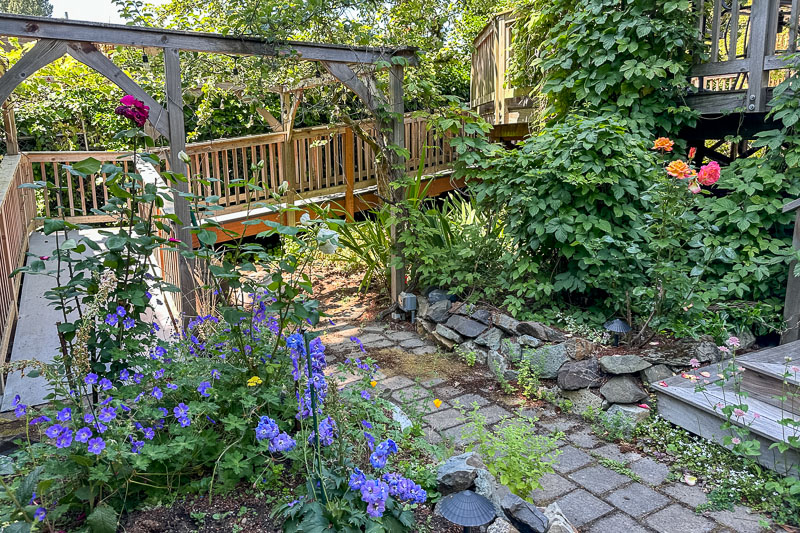

 Sally is putting on a party for July 4 so we are heading over to Walla Walla but on the way we will
stop in Washtucna L+
because it is such a good spot for migrants in the fall. It is not as good in the summer but we do
manage to add one species to our Adams County list - a Lazuli Bunting. The $148 we spend to sleep
at the Best Western Plus in Dayton does not feel as expensive as it did a few years ago and the
bed is comfortable.
Sally is putting on a party for July 4 so we are heading over to Walla Walla but on the way we will
stop in Washtucna L+
because it is such a good spot for migrants in the fall. It is not as good in the summer but we do
manage to add one species to our Adams County list - a Lazuli Bunting. The $148 we spend to sleep
at the Best Western Plus in Dayton does not feel as expensive as it did a few years ago and the
bed is comfortable.

Backyard flowers, Ravenna

Swainson's Hawk and wheat, Washtucna

The Best Western, Dayton
7/04/2024 Columbia County (link to here)
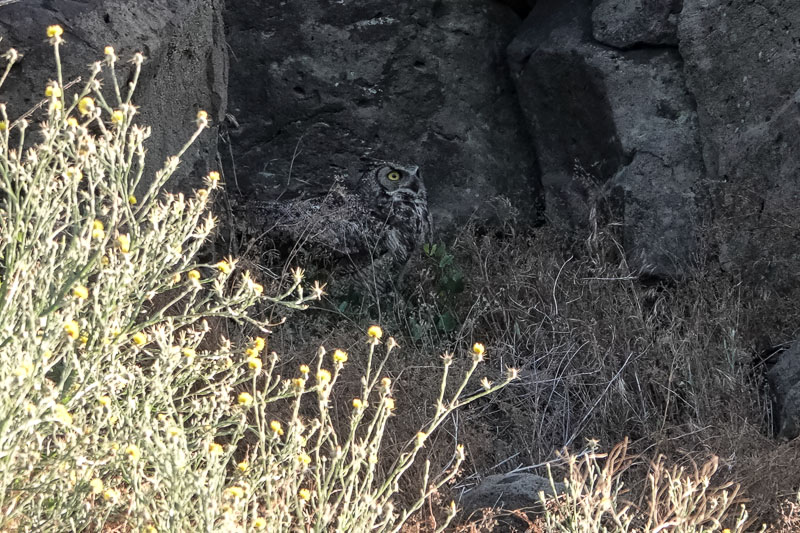
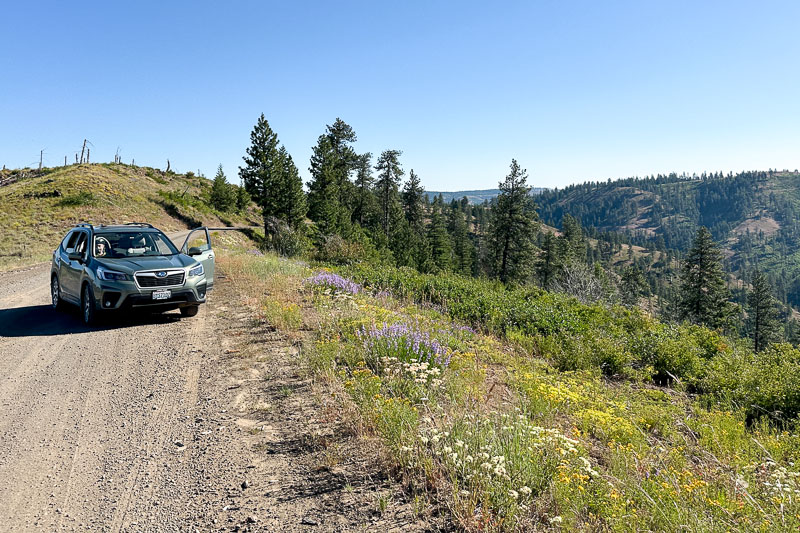
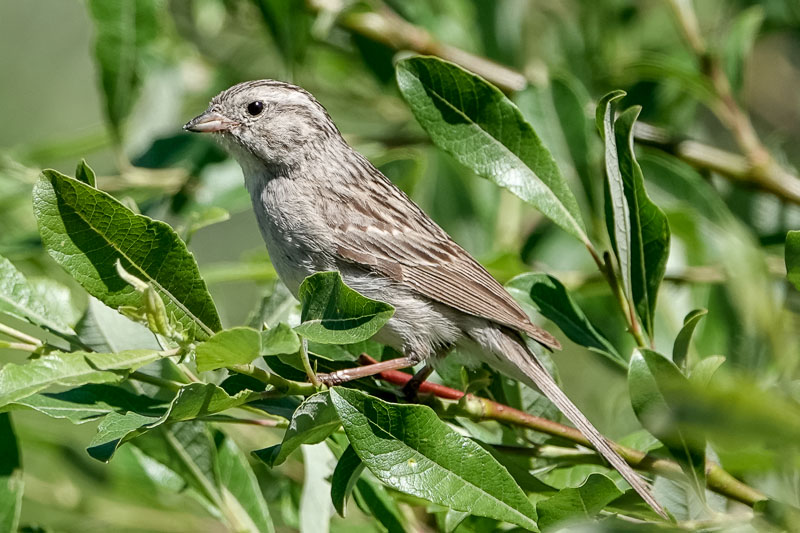
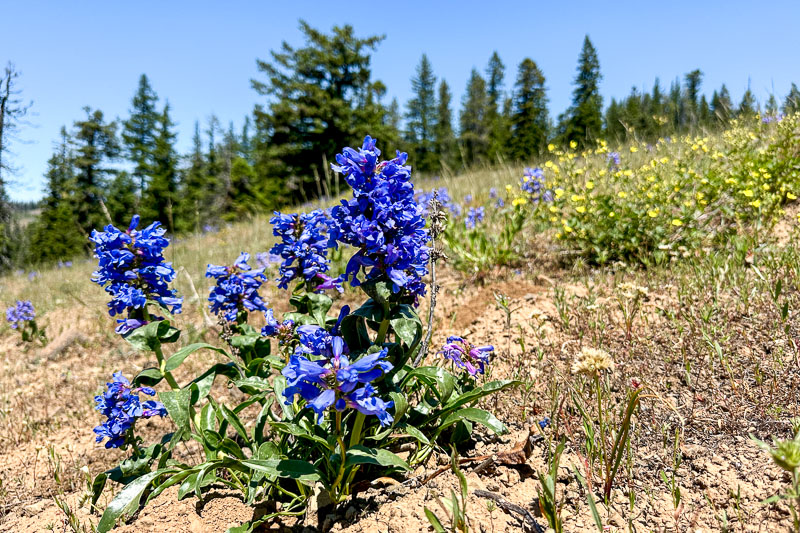 Swallows were chattering over Main Street but not much else was stirring when we checked out of the
Best Western shortly after sunrise. We followed 4th Sreet south out of Dayton then turned left onto
Crall Hollow Rd L+
after about two miles. That took us up out of the valley to Kendall Skyline Rd, aka Eckler Mountain
Rd, where we birded first wheatfields L+ then forest L+ on our up to the old burn L+ along Kendall Skyline Rd where Green-tailed Towhees had
recently been reported. We were unable to get photos but it was exciting to see and hear that
uncommon species in a new location. New for us that is, though probably not for the towhees; I
suspect they have been breeding there for years.
Swallows were chattering over Main Street but not much else was stirring when we checked out of the
Best Western shortly after sunrise. We followed 4th Sreet south out of Dayton then turned left onto
Crall Hollow Rd L+
after about two miles. That took us up out of the valley to Kendall Skyline Rd, aka Eckler Mountain
Rd, where we birded first wheatfields L+ then forest L+ on our up to the old burn L+ along Kendall Skyline Rd where Green-tailed Towhees had
recently been reported. We were unable to get photos but it was exciting to see and hear that
uncommon species in a new location. New for us that is, though probably not for the towhees; I
suspect they have been breeding there for years.
As we had hoped, we were able to continue on Kendall Skyline Rd L+ south and west through the high country above the Bluewood Ski Area before descending back to the North Touchet Road and Dayton. Completing the 61 mile loop M+ took us eight hours but gave us 20 new species for Columbia County. The flowers were beautiful, the views expansive, the roads unpaved but reasonably smooth and the birding + excellent.
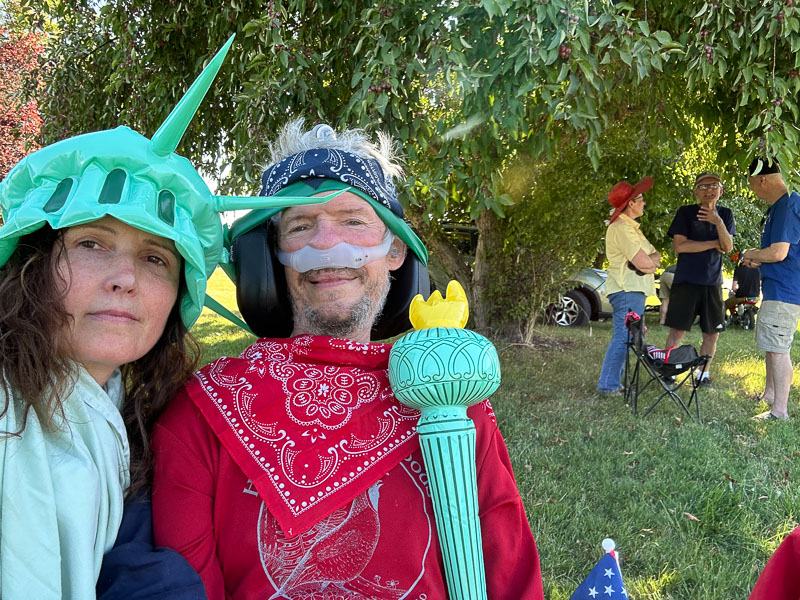
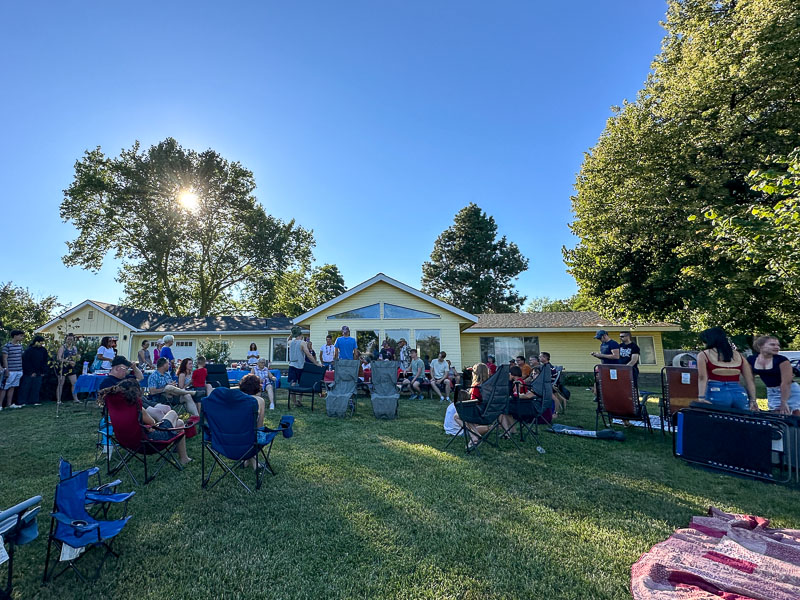
 Thanks to our early start this morning we made it to Walla Walla in time to participate in the parade
Sally and her neighbor Tiffany organized for the kids. The afternoon was hot, around 100F as I recall,
so instead of wheeling around the 1.X mile loop we donned the props that Darchelle had purchased for
the occasion and sat under a cherry tree along the route, dispensing cheers and drinks as needed
to the marchers. Afterwards Sally hosted a potluck supper and party in their front yard for family,
friends and neighbors. I didn't visit much; transformed by ALS, I'm not the party animal I used to be.
Thanks to our early start this morning we made it to Walla Walla in time to participate in the parade
Sally and her neighbor Tiffany organized for the kids. The afternoon was hot, around 100F as I recall,
so instead of wheeling around the 1.X mile loop we donned the props that Darchelle had purchased for
the occasion and sat under a cherry tree along the route, dispensing cheers and drinks as needed
to the marchers. Afterwards Sally hosted a potluck supper and party in their front yard for family,
friends and neighbors. I didn't visit much; transformed by ALS, I'm not the party animal I used to be.

Great Horned Owl, Crall Hollow Rd

Towhee habitat, Kendall Skyline Rd

Brewer's Sparrow, Kendall Skyline Rd

Penstemon, Kendall Skyline Rd
As we had hoped, we were able to continue on Kendall Skyline Rd L+ south and west through the high country above the Bluewood Ski Area before descending back to the North Touchet Road and Dayton. Completing the 61 mile loop M+ took us eight hours but gave us 20 new species for Columbia County. The flowers were beautiful, the views expansive, the roads unpaved but reasonably smooth and the birding + excellent.

Dressed for the Parade

Sally's Fourth of July Party

Baccoon family, Ravenna
7/18/2024 Tokeland (link to here)
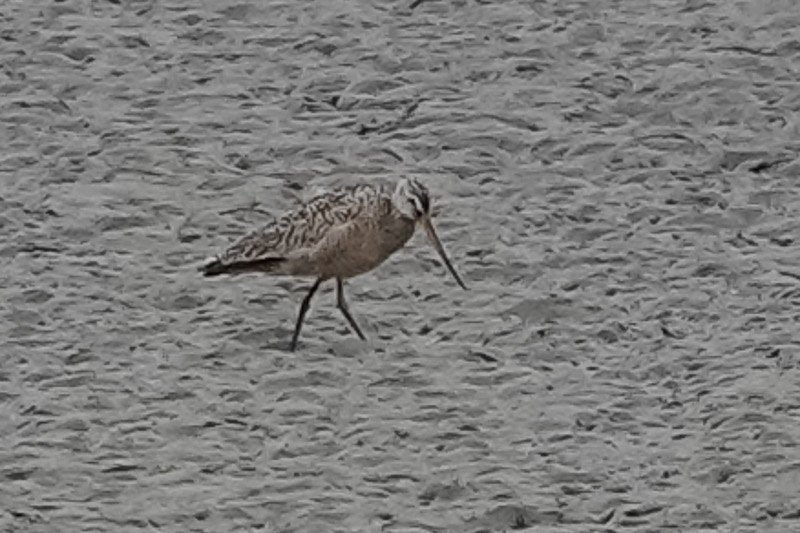
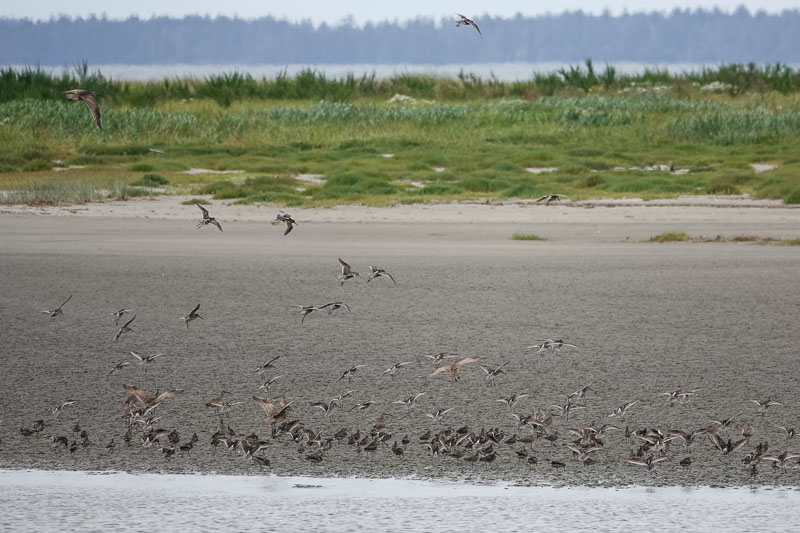
 Ed and Delia left Seattle ahead of us but stopped at Bottle Beach on the way so arrived at
Graveyard Spit L+
a few minutes after us, by which time the shorebirds had reshuffled and we were unable to relocate
the Bar-tailed Godwit. They did get to see our other target, the Black-legged Kittiwake at the
Tokeland marina L+.
Ed and Delia left Seattle ahead of us but stopped at Bottle Beach on the way so arrived at
Graveyard Spit L+
a few minutes after us, by which time the shorebirds had reshuffled and we were unable to relocate
the Bar-tailed Godwit. They did get to see our other target, the Black-legged Kittiwake at the
Tokeland marina L+.

Bar-tailed Godwit, Tokeland

Shorebirds at Graveyard Spit, Tokeland

Purple Martin and Black-legged Kittiwake, Tokeland
7/19/2024 Toutle (link to here)
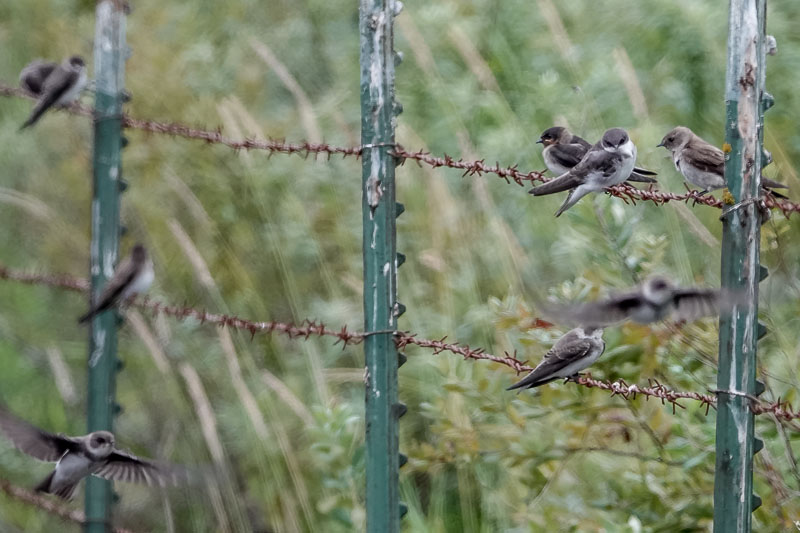
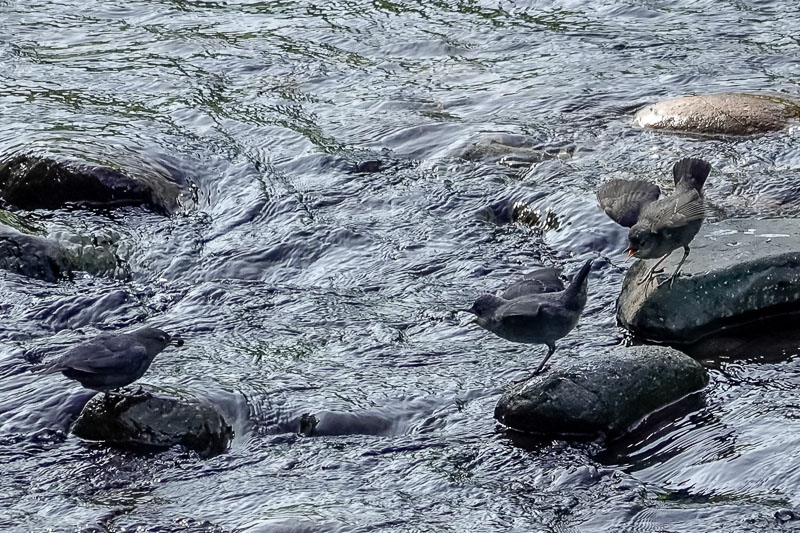
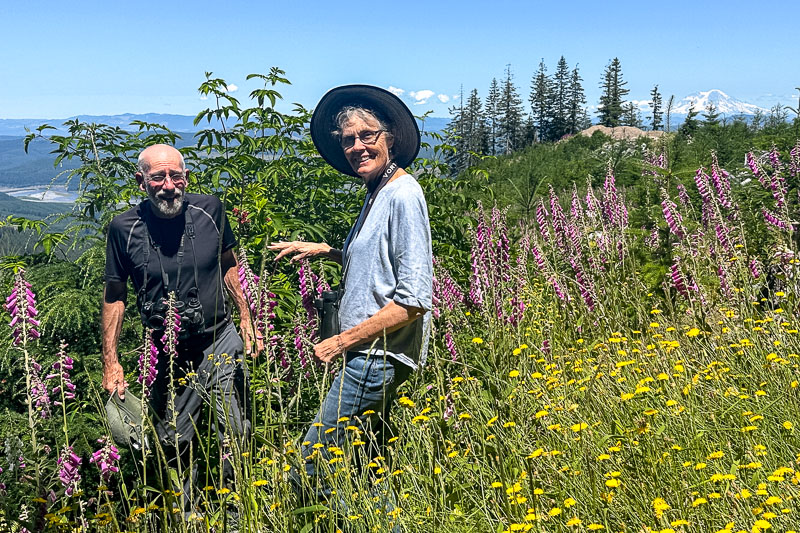 We all spent the night at the Mt Saint Helens Motel in Castle Rock for the reasonable price of $115/room
then spent the day chasing county birds in Toutle and along the Spirit Lake Hwy as far as Coldwater
Lake. We would have continued up to Johnston Ridge but that road was closed. Darchelle and I had
birded around Toutle but only in the winter and neither of us had been up to Coldwater Lake so we
enjoyed exploring the area. I was particularly intrigued by the extensive stands of second growth
Noble Fir + on the ridges around the lake and the even-aged alder groves by the
parking lots at the lake. Both areas were in the blast zone and were completely barren 44 years ago.
We all spent the night at the Mt Saint Helens Motel in Castle Rock for the reasonable price of $115/room
then spent the day chasing county birds in Toutle and along the Spirit Lake Hwy as far as Coldwater
Lake. We would have continued up to Johnston Ridge but that road was closed. Darchelle and I had
birded around Toutle but only in the winter and neither of us had been up to Coldwater Lake so we
enjoyed exploring the area. I was particularly intrigued by the extensive stands of second growth
Noble Fir + on the ridges around the lake and the even-aged alder groves by the
parking lots at the lake. Both areas were in the blast zone and were completely barren 44 years ago.
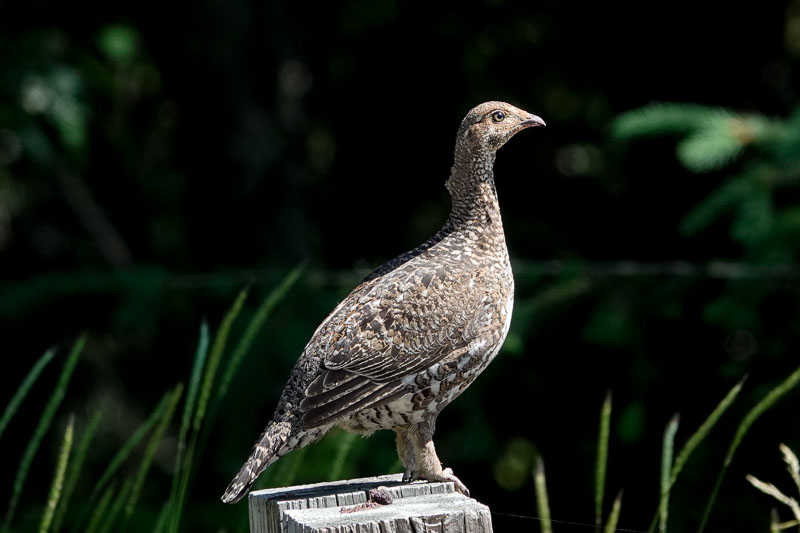
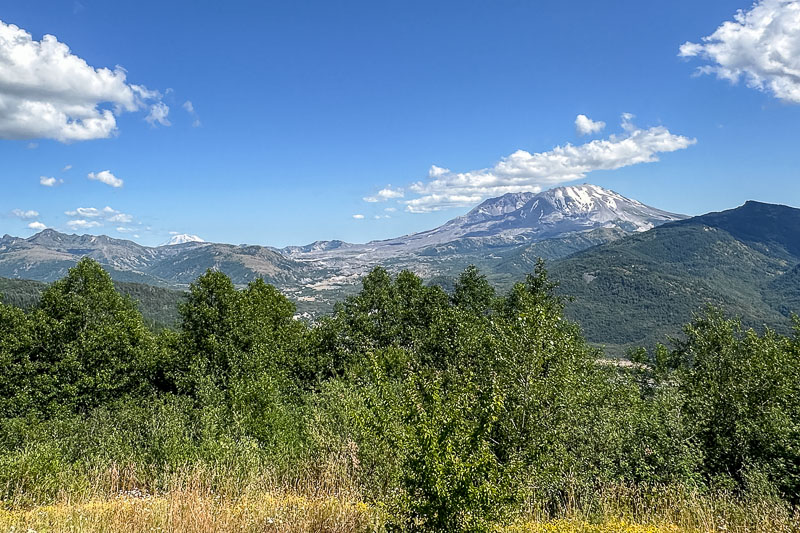
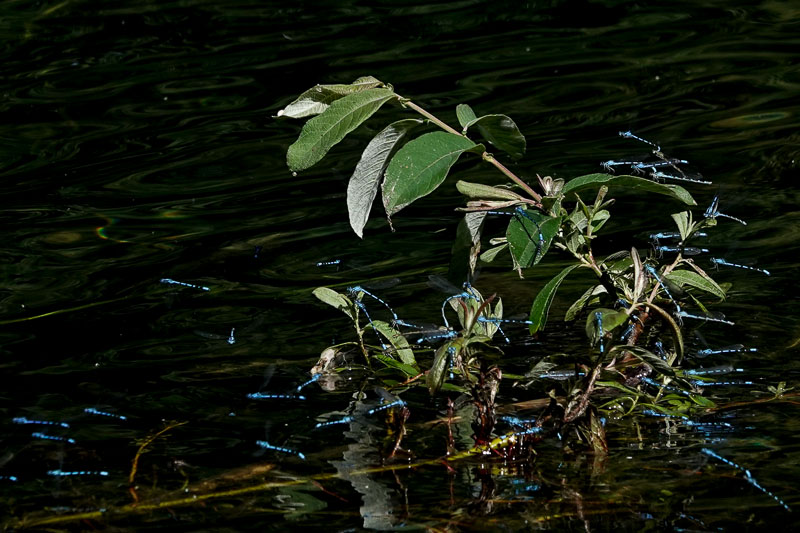 Probably because we did not reach Coldwater Lake L+ until mid-afternoon, we did not have many birds there but we
added 20 new Cowlitz county birds during the morning around Toutle. We picked up a handful along
the highway at Silver
Lake L+ and a few more at Sightly Road L+, less than a mile NE of the patch of woods where I used to
dig agates in a past life. At nearby Canal Road L+ we added another 10 species and at
Harry Gardner Park L+
along the Toutle River, three more. Our final new county birds were a Hermit Warbler way up in the
hills on FR 4200 L+
and a statuesque Sooty Grouse on a guardrail post along the Spirit Lake Hwy.
Probably because we did not reach Coldwater Lake L+ until mid-afternoon, we did not have many birds there but we
added 20 new Cowlitz county birds during the morning around Toutle. We picked up a handful along
the highway at Silver
Lake L+ and a few more at Sightly Road L+, less than a mile NE of the patch of woods where I used to
dig agates in a past life. At nearby Canal Road L+ we added another 10 species and at
Harry Gardner Park L+
along the Toutle River, three more. Our final new county birds were a Hermit Warbler way up in the
hills on FR 4200 L+
and a statuesque Sooty Grouse on a guardrail post along the Spirit Lake Hwy.

Swallows, Canal Road

American Dipper, Harry Gardner Park

Ed and Delia along FR 4200

Sooty Grouse, Spirit Lake Hwy

Mount St. Helens from Spirit Lake Hwy

Marsh bluets, Coldwater Lake
7/20/2024 Clark County (link to here)
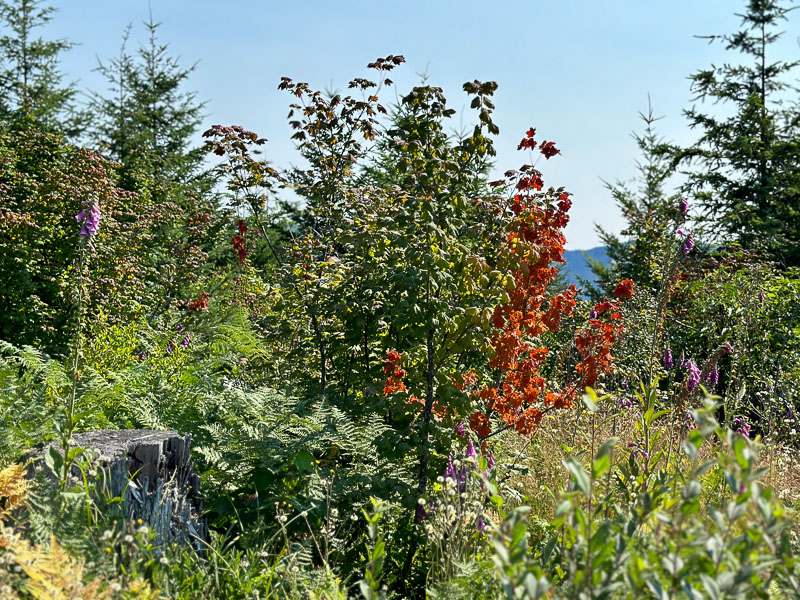
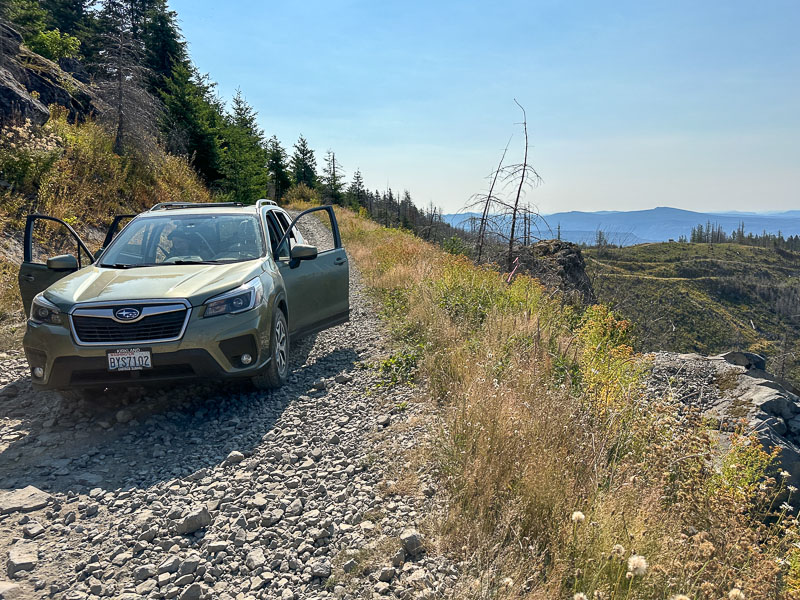
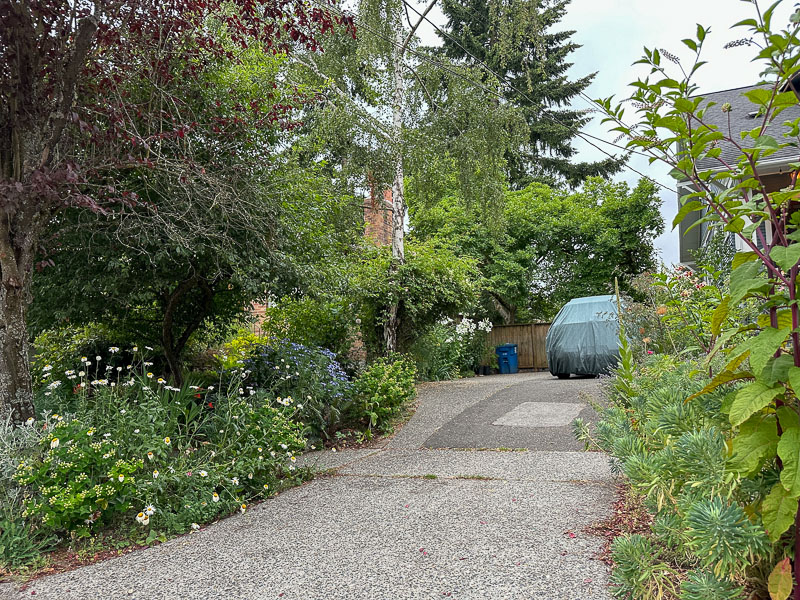 Ed and Delia returned to Seattle yesterday afternoon but since we were already down south we decided
to stay another night in Castle Rock and try for a new bird or two in Clark County in the morning,
Clark being one of the few counties in the state in which we had not yet seen a new bird this year.
The Mt Saint Helens Motel was full so we booked an inferior room at the Timberland Inn & Suites for
$70 more. That evening felt a little bleak but the morning was bright and sunny and I perked up as
we birded our way up through mixed second growth forest, clearcuts and old burns to the
Mountain View 4x4
Trailhead L+, also known to Clark County birders as "Migration Corner". We found 4x4's and
motorcycles but no migrants; we were about five weeks too early for those. We did pick up seven new
birds for the county but I did not find the experience particularly rewarding. I barely saw distant
dots or barely heard faint calls and had more gas than normal, even had to stop in the middle of a
clearcut and transfer to the wheelchair for a half hour so I could lean forward, pass gas and
finally relieve the bloating.
Ed and Delia returned to Seattle yesterday afternoon but since we were already down south we decided
to stay another night in Castle Rock and try for a new bird or two in Clark County in the morning,
Clark being one of the few counties in the state in which we had not yet seen a new bird this year.
The Mt Saint Helens Motel was full so we booked an inferior room at the Timberland Inn & Suites for
$70 more. That evening felt a little bleak but the morning was bright and sunny and I perked up as
we birded our way up through mixed second growth forest, clearcuts and old burns to the
Mountain View 4x4
Trailhead L+, also known to Clark County birders as "Migration Corner". We found 4x4's and
motorcycles but no migrants; we were about five weeks too early for those. We did pick up seven new
birds for the county but I did not find the experience particularly rewarding. I barely saw distant
dots or barely heard faint calls and had more gas than normal, even had to stop in the middle of a
clearcut and transfer to the wheelchair for a half hour so I could lean forward, pass gas and
finally relieve the bloating.

Old burn habitat above Migration Corner

Rough road above Migration Corner

Gardens along the driveway, Ravenna
7/31/2024 Concluding July (link to here)
During July we drove 1424 miles, spending 4 nights away from home and 5 days birding and submitting 30 complete checklists with 139 species. We added only two new year birds for a total of 312.
During July we drove 1424 miles, spending 4 nights away from home and 5 days birding and submitting 30 complete checklists with 139 species. We added only two new year birds for a total of 312.
8/04/2024 Red-footed Booby (link to here)
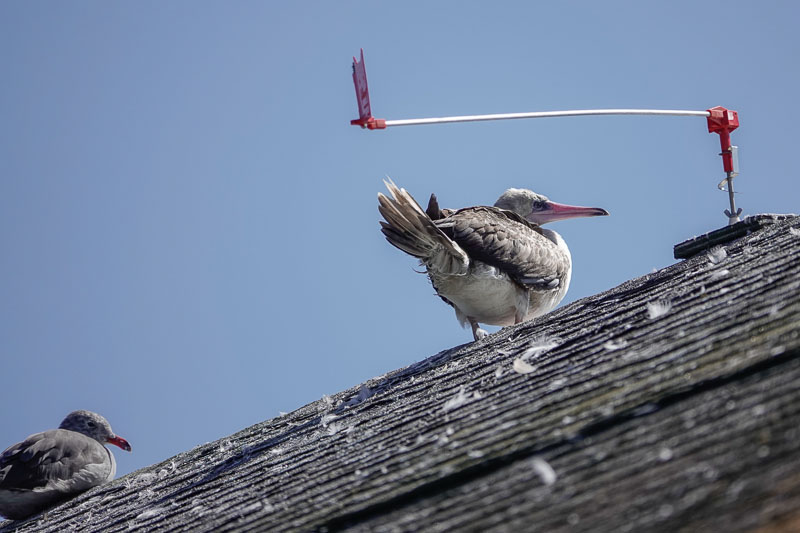

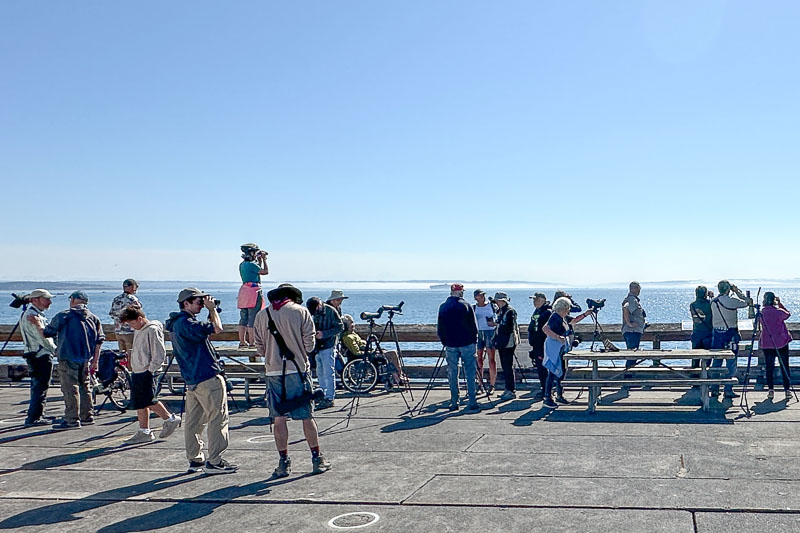 The Red-footed Booby first appeared on a buoy off Dungeness Spit a few days ago. It being only the
third record in state, we were interested but not until it was reported from Point Wilson yesterday
did we consider chasing it. We hurried out to North Beach where it had been seen two hours earlier
and Darchelle scoped the water while I watched through my opera glasses. She saw the bird plunging
into a feeding flock of gulls and cormorants but it was too distant for me to pick out so we
returned today to try again. We were not alone.
The Red-footed Booby first appeared on a buoy off Dungeness Spit a few days ago. It being only the
third record in state, we were interested but not until it was reported from Point Wilson yesterday
did we consider chasing it. We hurried out to North Beach where it had been seen two hours earlier
and Darchelle scoped the water while I watched through my opera glasses. She saw the bird plunging
into a feeding flock of gulls and cormorants but it was too distant for me to pick out so we
returned today to try again. We were not alone.
At least a dozen of us had been scoping the waters north of Point Wilson for an hour or more when someone rode up on a bicycle and announced that the bird we sought was currently sitting on top of the Marine Science Center building about 300 yards directly behind us. We hurried over to join a Booby party of delighted birders gathered on the pier below what would become quite a celebrity bird. Even I had a good look at it, when it soared directly over my head on its way out to the bay to look for lunch. It did not catch anything while we were watching, as far as I could tell, but other efforts must have been more successful because it remained in the area until early October.

Red-footed Booby, Fort Worden SP

Red-footed Booby, Fort Worden SP

Booby party
At least a dozen of us had been scoping the waters north of Point Wilson for an hour or more when someone rode up on a bicycle and announced that the bird we sought was currently sitting on top of the Marine Science Center building about 300 yards directly behind us. We hurried over to join a Booby party of delighted birders gathered on the pier below what would become quite a celebrity bird. Even I had a good look at it, when it soared directly over my head on its way out to the bay to look for lunch. It did not catch anything while we were watching, as far as I could tell, but other efforts must have been more successful because it remained in the area until early October.
8/05/2024 Flowers (link to here)
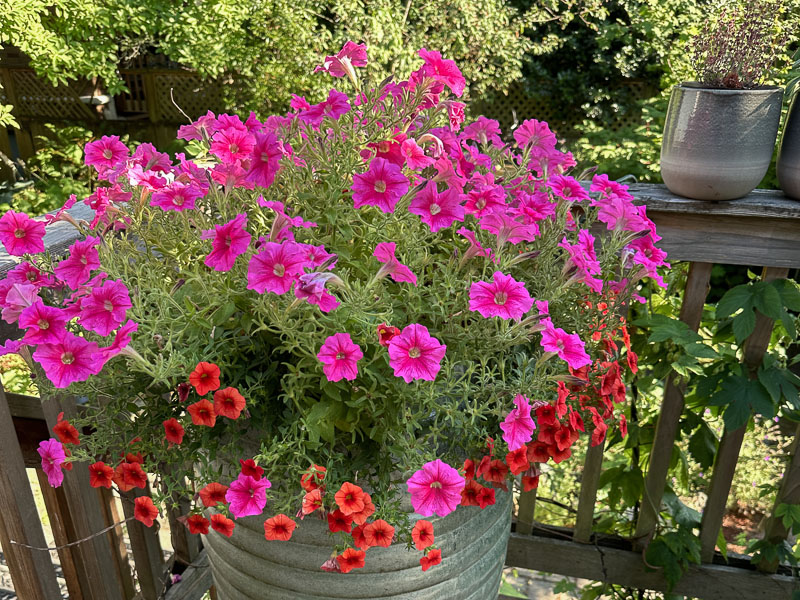
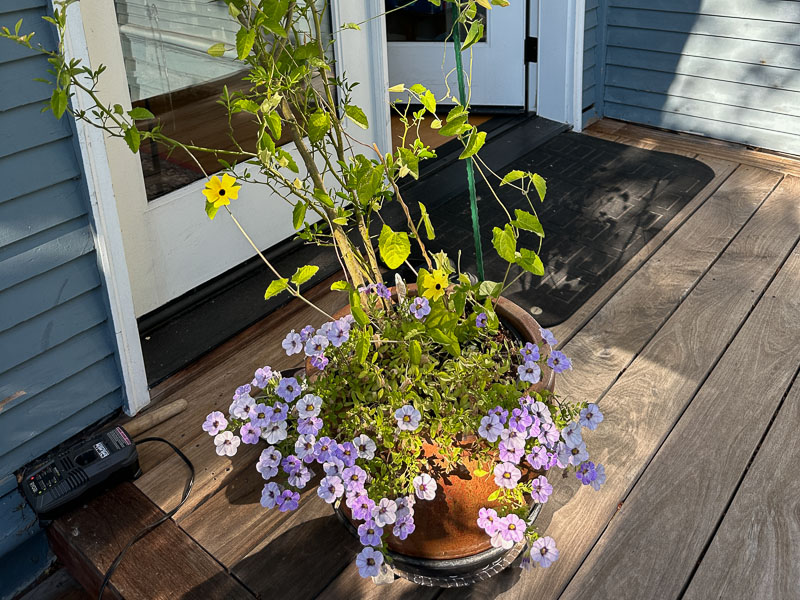
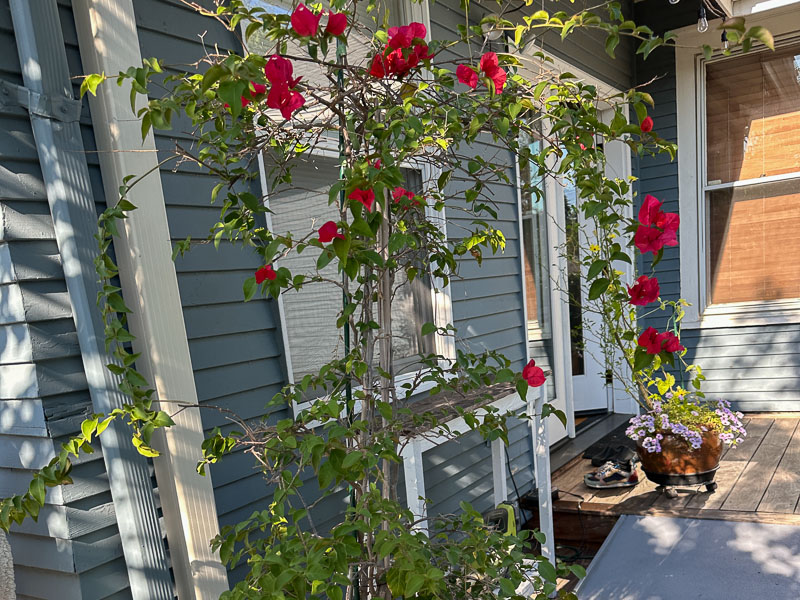 Darchelle decorates the deck with flowers every summer and right now they are at their prime. The
Bougainvillea is one of my favorites. It's more comfortable in Africa than in Seattle so we bring
it inside for the winter and as soon as we do so, it sheds all its leaves and grows a new set then
produces a new crop of flowers as well but the winter flowers are pale pink. When we put the
Bougainvillea back outdoors in May the spring sunshine burns off its tender winter foliage no matter
how carefully we try to shade it. Unfazed, the plant promptly grows new leaves then sometime in
late July, comes out with the blood red flowers shown here.
Darchelle decorates the deck with flowers every summer and right now they are at their prime. The
Bougainvillea is one of my favorites. It's more comfortable in Africa than in Seattle so we bring
it inside for the winter and as soon as we do so, it sheds all its leaves and grows a new set then
produces a new crop of flowers as well but the winter flowers are pale pink. When we put the
Bougainvillea back outdoors in May the spring sunshine burns off its tender winter foliage no matter
how carefully we try to shade it. Unfazed, the plant promptly grows new leaves then sometime in
late July, comes out with the blood red flowers shown here.

Deck flowers, Ravenna

Deck flowers, Ravenna

Bougainvillea, Ravenna
8/12/2024 Anniversary (link to here)
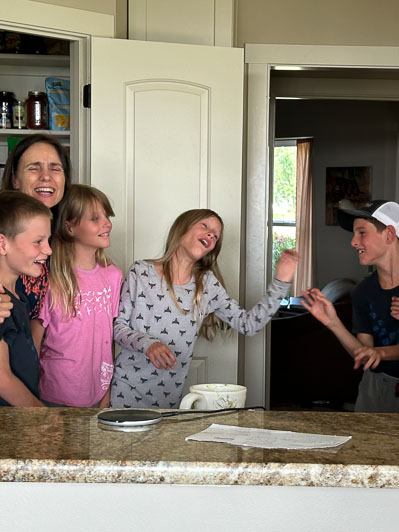


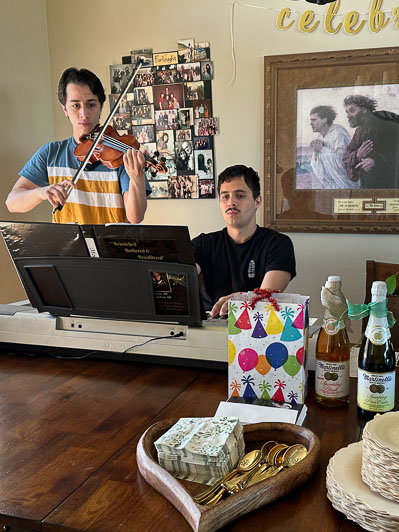 Darchelle and her sisters planned a family reunion around their parents' 60th wedding anniversary so
we spent the third week of August in Walla Walla.
Darchelle and her sisters planned a family reunion around their parents' 60th wedding anniversary so
we spent the third week of August in Walla Walla.
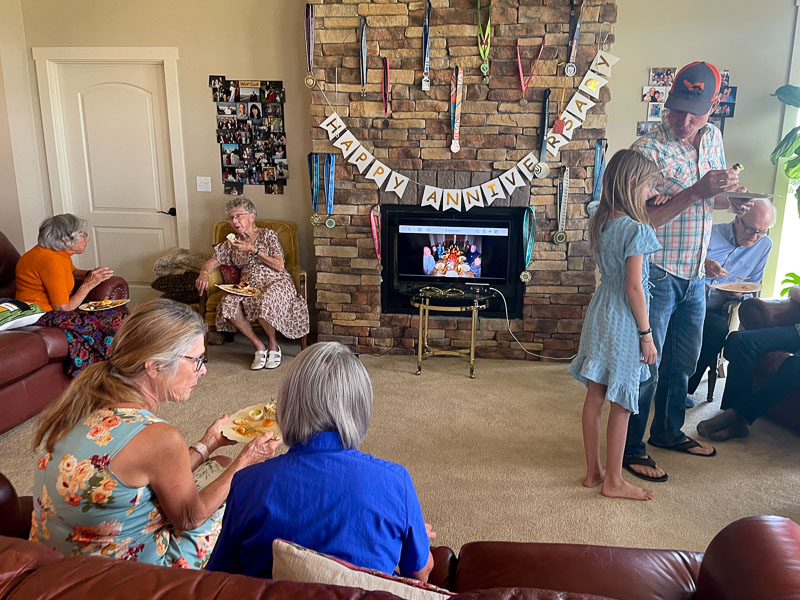


 The anniversary party was a big deal. Alicia designed and printed announcement cards to be posted
around town and handed out at church. Darchelle sorted through hundreds of photos and arranged them
on five posterboards depicting five chronological periods of her parents' lives together. Sally and
Alicia prepared favorite foods and Darchelle decorated both the tables and the room. More than 60
friends and family attended over the course of the afternoon. Tribute speeches had been planned but
didn't quite happen. Instead everyone browsed and visited and seemed to have a great time honoring
Richard and Donna by their presence and attention. I particularly enjoyed philosophical
conversations with Richard's brother Roger and with my former fellow elder and friend Lee Myers.
The anniversary party was a big deal. Alicia designed and printed announcement cards to be posted
around town and handed out at church. Darchelle sorted through hundreds of photos and arranged them
on five posterboards depicting five chronological periods of her parents' lives together. Sally and
Alicia prepared favorite foods and Darchelle decorated both the tables and the room. More than 60
friends and family attended over the course of the afternoon. Tribute speeches had been planned but
didn't quite happen. Instead everyone browsed and visited and seemed to have a great time honoring
Richard and Donna by their presence and attention. I particularly enjoyed philosophical
conversations with Richard's brother Roger and with my former fellow elder and friend Lee Myers.

Alicia and the Quads

Three sisters, Ben and Micah

Richard and Donna on their 60th Anniversary

Daniel and Gabriel

At the party

Richard with former student Lee M

Guest with Richard and Roger

Reading cards after the party
8/16/2024 Asotin (link to here)
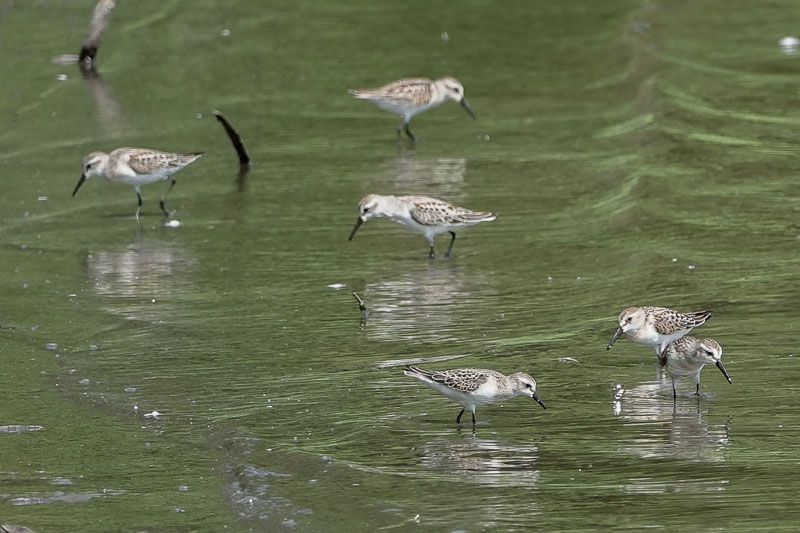

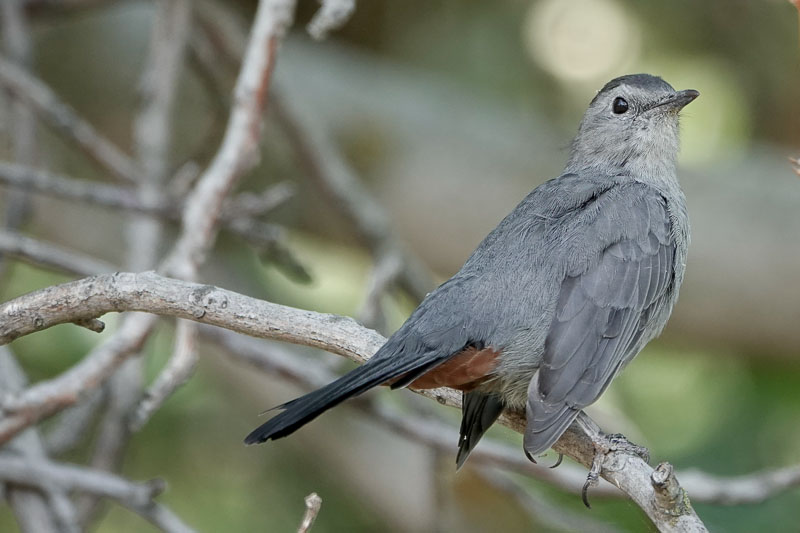 For the rest of the week we relaxed, enjoying meals and conversation together with no particular
agenda. Darchelle and I didn't even do any birding, until reports of not one but two Stilt
Sandpipers two hours away at Swallows Park L+ in Asotin lured us back out into the field.
For the rest of the week we relaxed, enjoying meals and conversation together with no particular
agenda. Darchelle and I didn't even do any birding, until reports of not one but two Stilt
Sandpipers two hours away at Swallows Park L+ in Asotin lured us back out into the field.
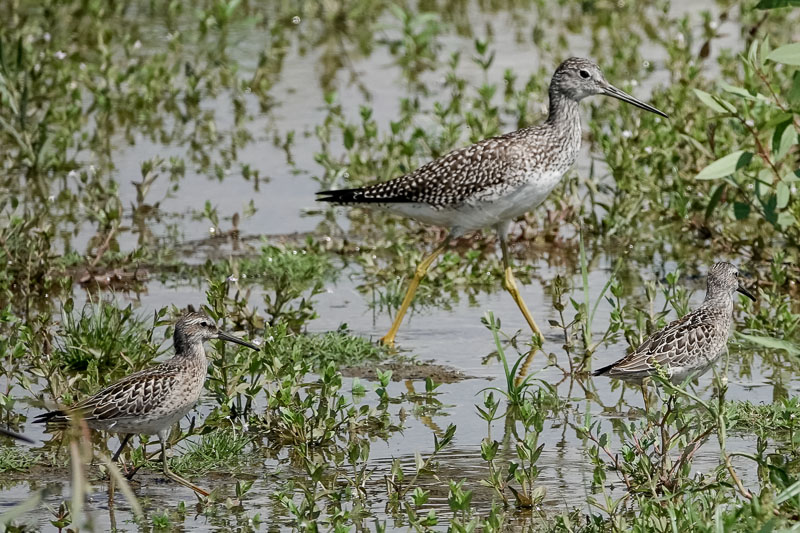

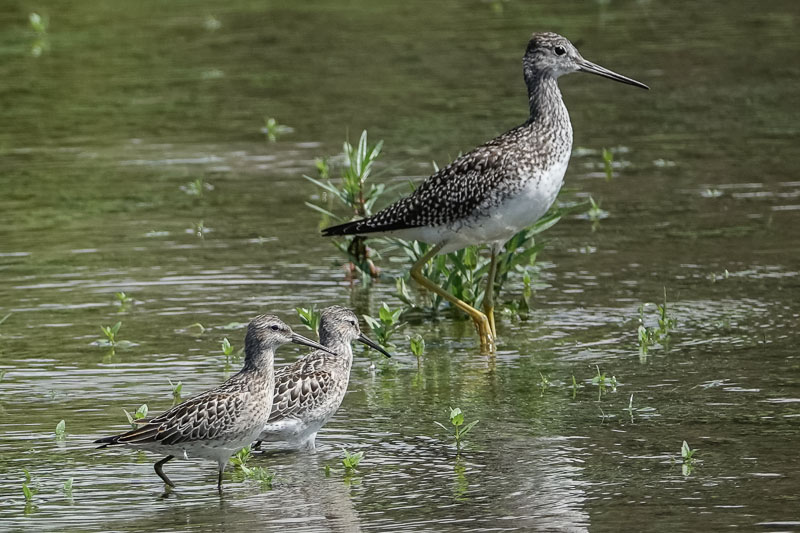 The sandpipers, a bird which in some years we have had to work very hard to see, provided Darchelle
with some excellent photo opportunities despite the two energetic dogs dashing through the marsh now
and then. They were of course year birds for us but they, along with six other species including
the four pictured above, were also new for Asotin County.
The sandpipers, a bird which in some years we have had to work very hard to see, provided Darchelle
with some excellent photo opportunities despite the two energetic dogs dashing through the marsh now
and then. They were of course year birds for us but they, along with six other species including
the four pictured above, were also new for Asotin County.

Semipalmated and Western Sandpipers, Swallows Park

Swallows Park

Gray Catbird, Swallows Park

Stilt Sandpipers and Greater Yellowlegs, Swallows Park

Stilt Sandpipers and Greater Yellowlegs, Swallows Park

Stilt Sandpipers and Greater Yellowlegs, Swallows Park
8/17/2024 Birthday Week (link to here)
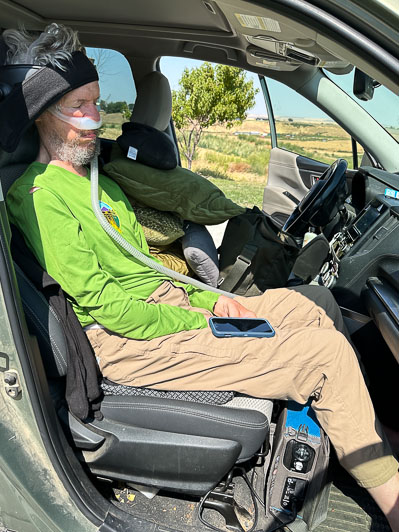
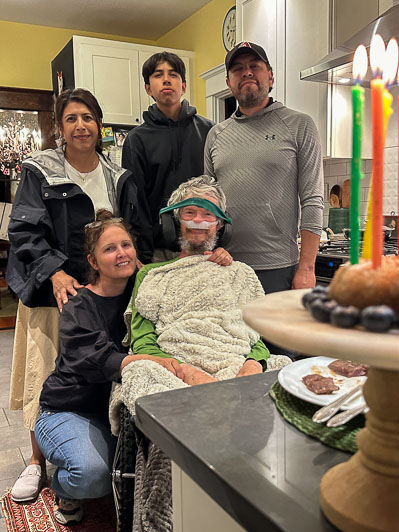
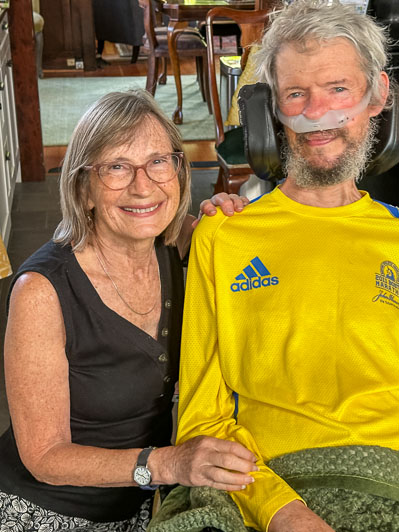
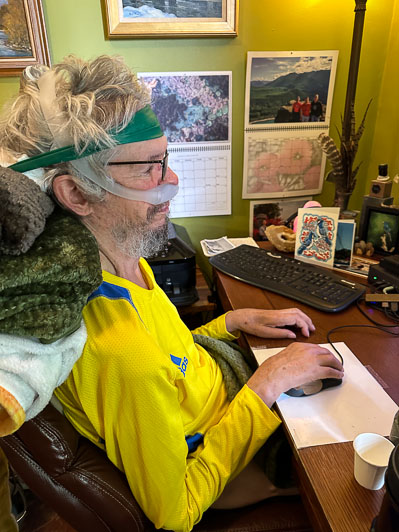 A day, actually several days, in the life of the birthday boy, a birthday worth celebrating because
I didn't expect to achieve this Biblically-sanctioned lifespan. Now, by one standard at least, my
life has not been cut short by ALS.
A day, actually several days, in the life of the birthday boy, a birthday worth celebrating because
I didn't expect to achieve this Biblically-sanctioned lifespan. Now, by one standard at least, my
life has not been cut short by ALS.
Daniel called shortly after Darchelle and I pulled into Richard and Donna's driveway on a recent hot August afternoon. I do not recall our conversation other than that it was more meaningful than most. Our friends and neighbors Marco, Monica and Marc never fail to remember our birthdays, this time as usual with savory food as well as a cake - Monica is an excellent cook. The visit from my college friend LaJuan was a delightful treat; nothing to do with my birthday, she was just in the area and had time to stop by and even spend the night. The conversations that she, Darchelle and I share are so rich that it feels as though we only need to have them every six months or so. Finally, back in my two-dollar office chair with jury-rigged headrest, trying to catch up on my journaling. Unsuccessfully as it turned out, since this entry was actually written six months later while I was sitting in the kitchen typing with my eyes on my wheelchair-mounted and eye gaze-controlled computer.

Talking with Daniel

With Monica, Marc, Marco and cake

Visit from Lajuan

Journaling
Daniel called shortly after Darchelle and I pulled into Richard and Donna's driveway on a recent hot August afternoon. I do not recall our conversation other than that it was more meaningful than most. Our friends and neighbors Marco, Monica and Marc never fail to remember our birthdays, this time as usual with savory food as well as a cake - Monica is an excellent cook. The visit from my college friend LaJuan was a delightful treat; nothing to do with my birthday, she was just in the area and had time to stop by and even spend the night. The conversations that she, Darchelle and I share are so rich that it feels as though we only need to have them every six months or so. Finally, back in my two-dollar office chair with jury-rigged headrest, trying to catch up on my journaling. Unsuccessfully as it turned out, since this entry was actually written six months later while I was sitting in the kitchen typing with my eyes on my wheelchair-mounted and eye gaze-controlled computer.
8/25/2024 KGY Point (link to here)
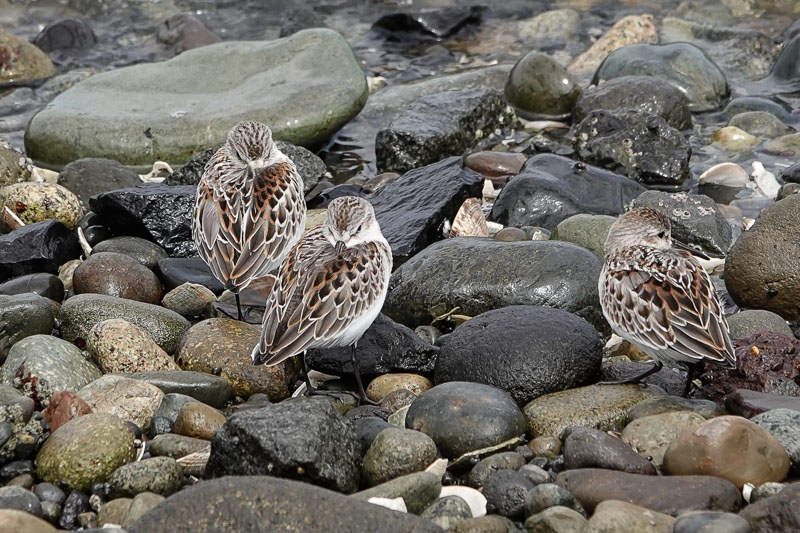

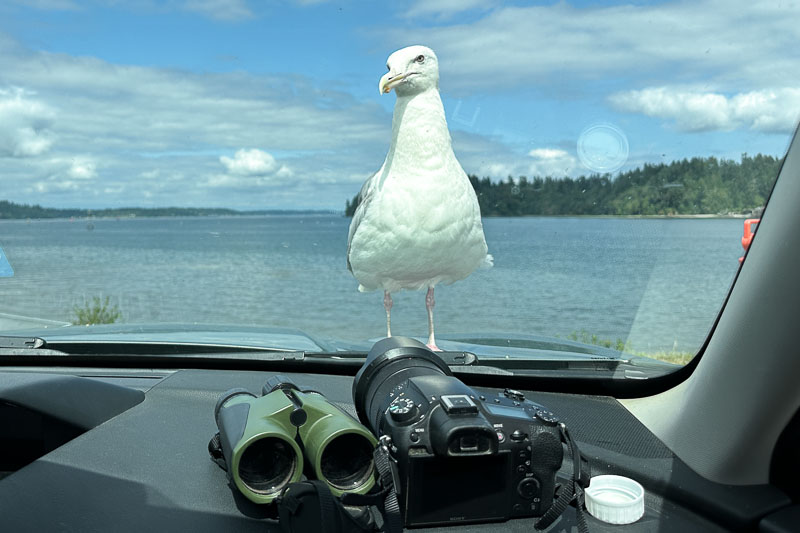 Which bird it was that lured us out to KGY Point on our way to Westport for our pelagic trip
tomorrow, I no longer recall - an Arctic Tern perhaps. At any rate we did not find it but we did
have fun with this Glaucous-winged Gull, which we rewarded with part of our lunch for his/her
attentions.
Which bird it was that lured us out to KGY Point on our way to Westport for our pelagic trip
tomorrow, I no longer recall - an Arctic Tern perhaps. At any rate we did not find it but we did
have fun with this Glaucous-winged Gull, which we rewarded with part of our lunch for his/her
attentions.

Western Sandpipers, KGY Point

Glaucous-winged Gull, KGY Point

Glaucous-winged Gull, KGY Point
8/26/2024 Pelagic Trip (link to here)
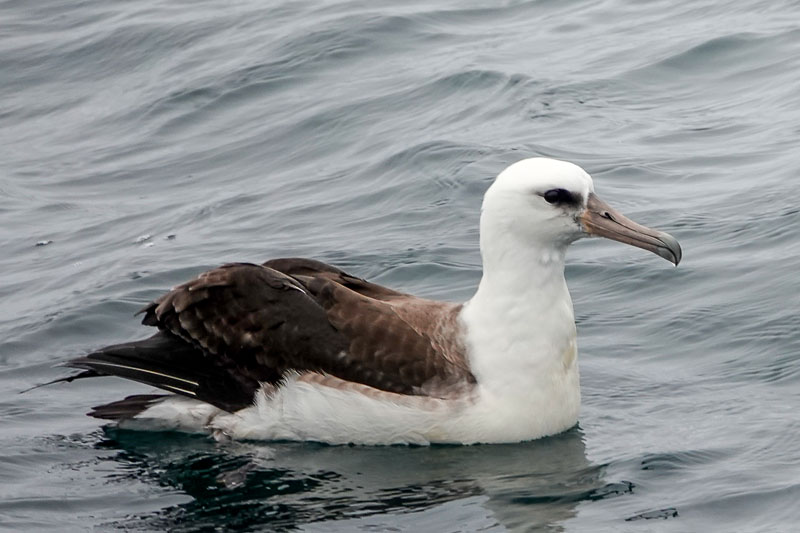
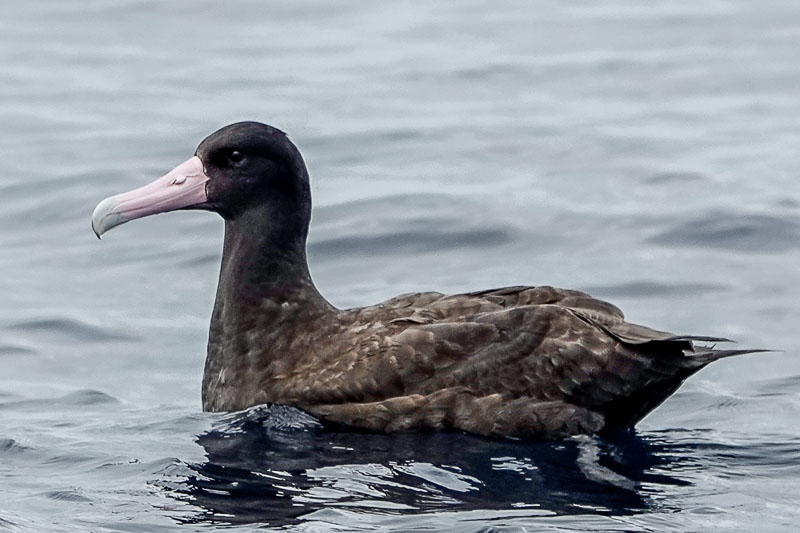 Today we had a truly remarkable day of pelagic birding with Westport Seabirds +. Of the 19 pelagic or mostly pelagic birds we
might hope to counter on a late-summer trip we missed only two, an impressive feat in itself, but
in addition we found three mega-rarities, species which have each been seen fewer than four times
in the past four years on 75 trips out of Westport. I'm not sure that has ever happened before
in nearly 50 years of Westport pelagic trips.
Today we had a truly remarkable day of pelagic birding with Westport Seabirds +. Of the 19 pelagic or mostly pelagic birds we
might hope to counter on a late-summer trip we missed only two, an impressive feat in itself, but
in addition we found three mega-rarities, species which have each been seen fewer than four times
in the past four years on 75 trips out of Westport. I'm not sure that has ever happened before
in nearly 50 years of Westport pelagic trips.
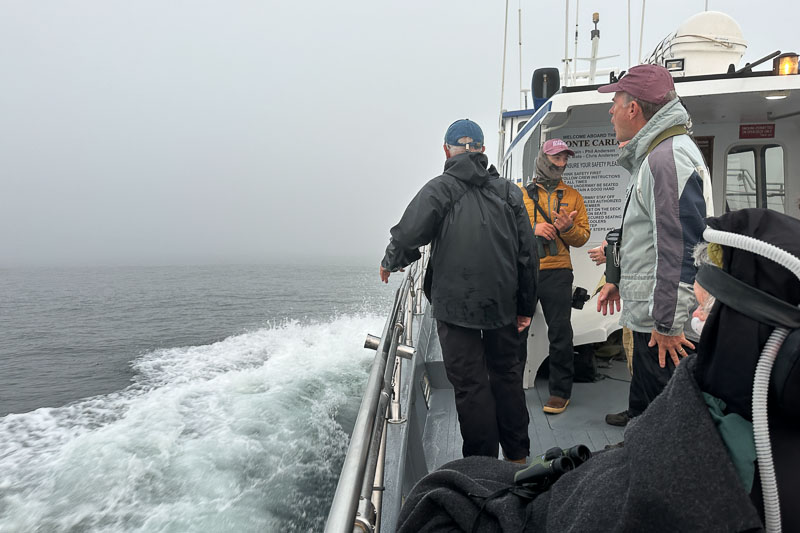
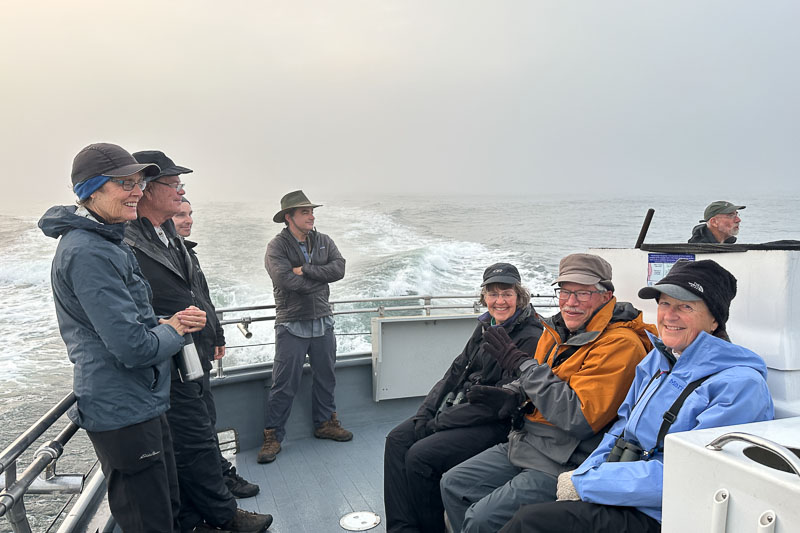
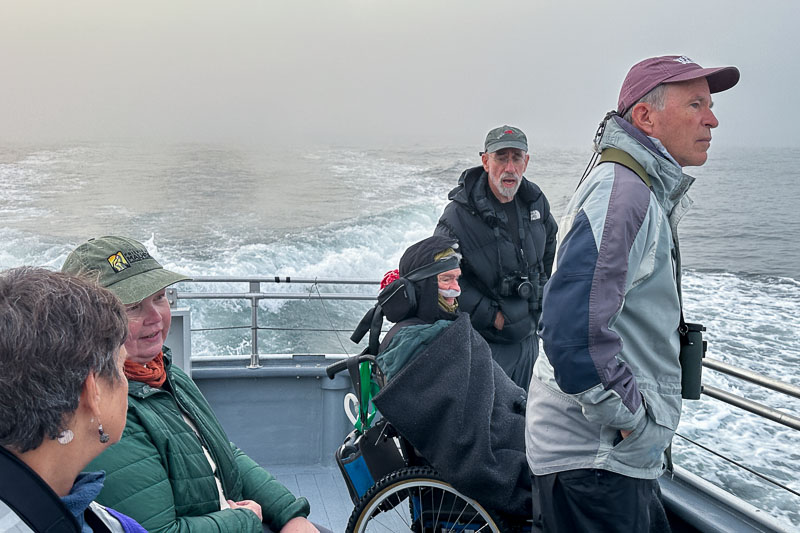 Although fog had not been in the forecast, mist shrouded the marina when we arrived at Float 10 at
5:30 AM and enveloped us as we motored out of the harbor, across the bar and out to sea. The water
was glassy and almost flat; I've rarely seen the bar so calm. That's not necessarily a good
thing. The birds tend to move around more when they can take advantage of the energy of wind and
waves and when they are on the move, they are often easier to find.
Although fog had not been in the forecast, mist shrouded the marina when we arrived at Float 10 at
5:30 AM and enveloped us as we motored out of the harbor, across the bar and out to sea. The water
was glassy and almost flat; I've rarely seen the bar so calm. That's not necessarily a good
thing. The birds tend to move around more when they can take advantage of the energy of wind and
waves and when they are on the move, they are often easier to find.
The fog began to thin out as the sun rose behind us but we still were not seeing many birds. We passed, or were passed by, an occasional murre or shearwater but no big flocks so I began to adjust my year bird estimates for the day downward. I had initially figured 12-15 new birds would not be unreasonable but after an hour and half in the fog I was prepared to be content with 10-12.
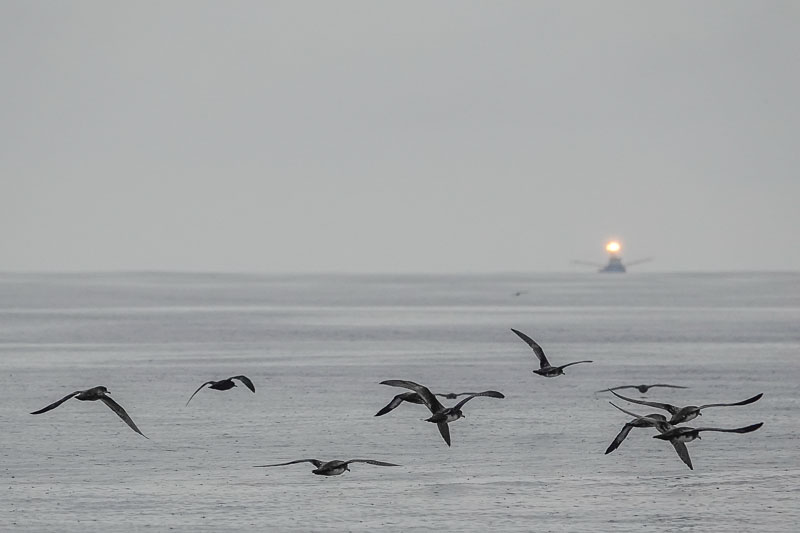
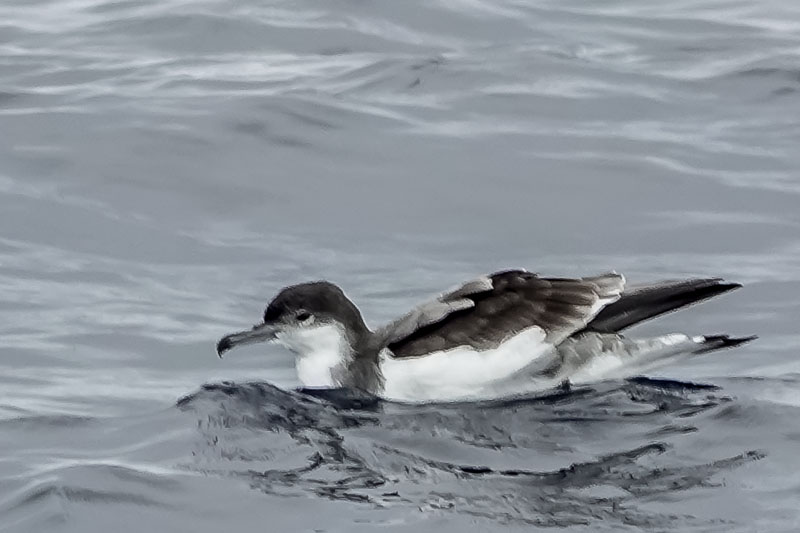
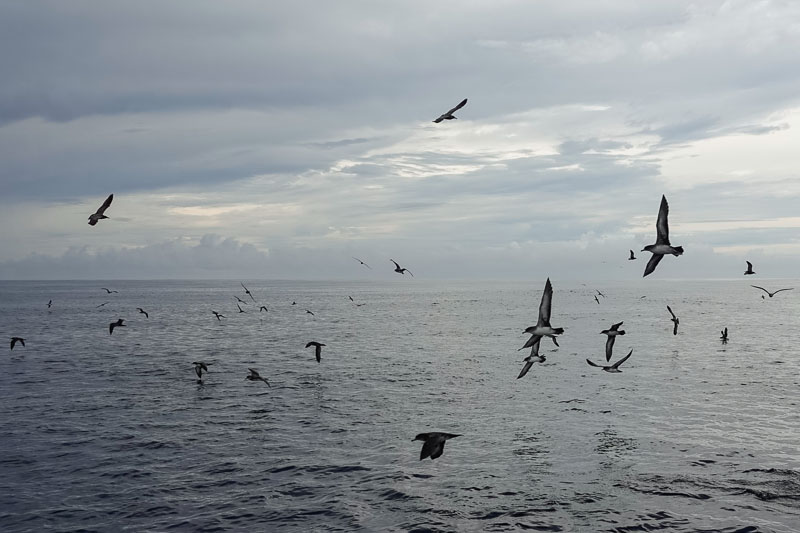 Not long after that we began to see groups of mostly Pink-footed Shearwaters and Westport Seabirds
started their first checklist - westbound from the 50 fathom line L+. Fork-tailed Storm-Petrels began to show
up, individuals at first then large flocks. They were not new for the year for us but the Buller's
Shearwater in one of the flocks of Pink-foots was one of the birds we were looking for, as was the
Northern Fulmar a few minutes later. Both species are regular but neither has been seen in large
numbers recently. Given that I do not always see every bird, I was grateful to get them.
Not long after that we began to see groups of mostly Pink-footed Shearwaters and Westport Seabirds
started their first checklist - westbound from the 50 fathom line L+. Fork-tailed Storm-Petrels began to show
up, individuals at first then large flocks. They were not new for the year for us but the Buller's
Shearwater in one of the flocks of Pink-foots was one of the birds we were looking for, as was the
Northern Fulmar a few minutes later. Both species are regular but neither has been seen in large
numbers recently. Given that I do not always see every bird, I was grateful to get them.
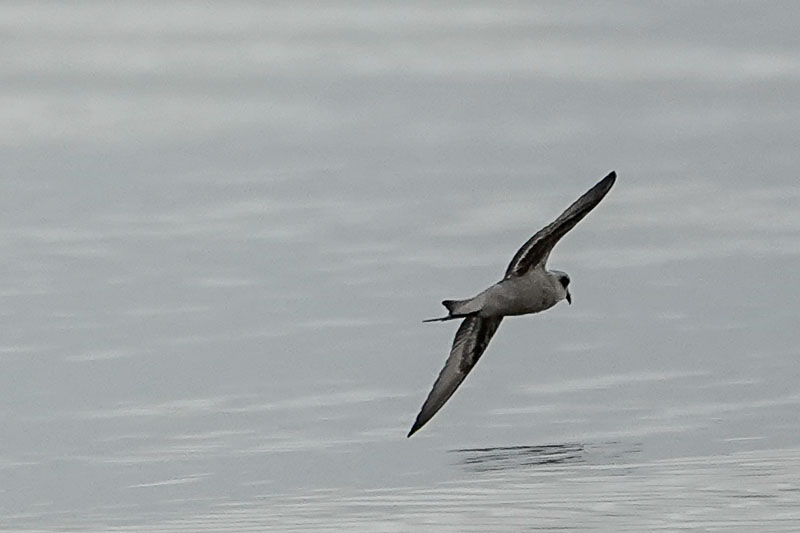
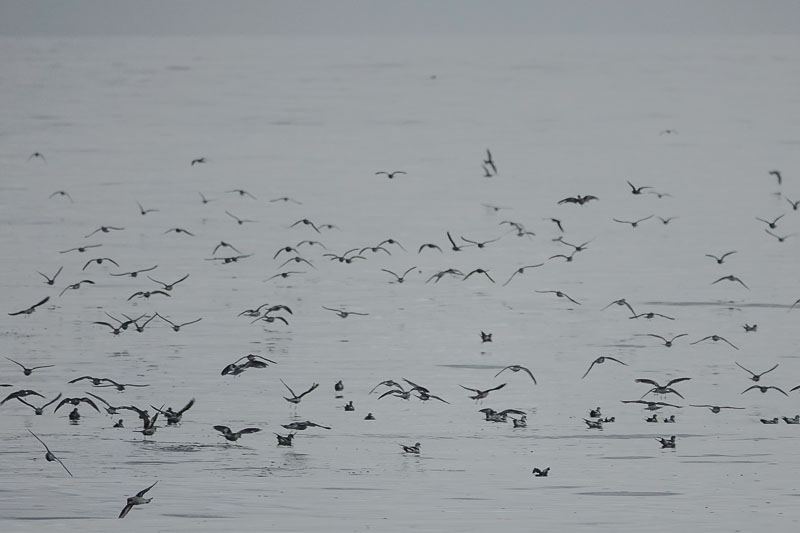
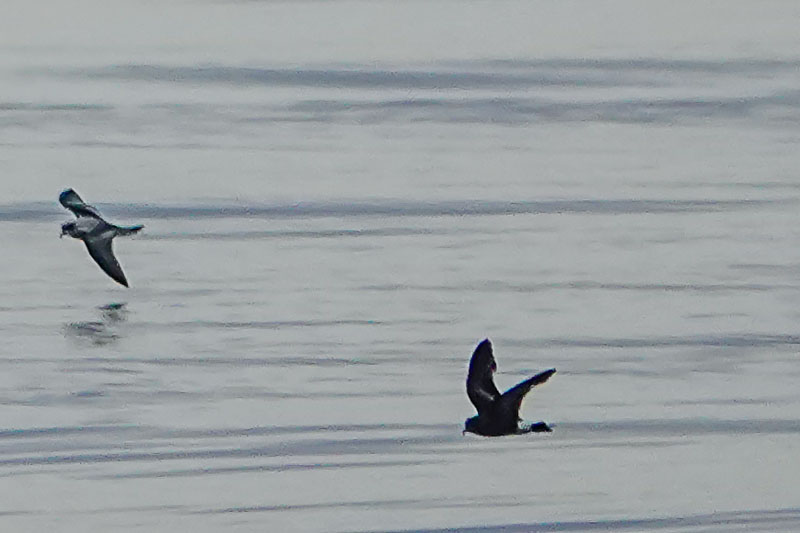 Two hours out we had our first mega-rarity. Bill was standing next to my wheelchair on the port
side of the boat when, alerted by someone up front, got binoculars on a dark storm-petrel and
shouted "Wilson's Storm-Petrel!" In his words:
Two hours out we had our first mega-rarity. Bill was standing next to my wheelchair on the port
side of the boat when, alerted by someone up front, got binoculars on a dark storm-petrel and
shouted "Wilson's Storm-Petrel!" In his words:


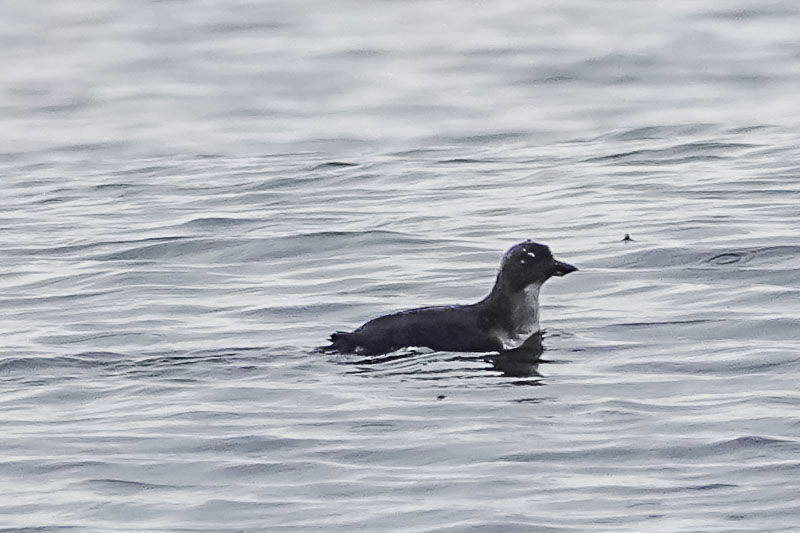 Around 9 AM we caught up to several fishing boats trailing large loose flocks of seabirds,
mostly shearwaters but also albatrosses, gulls and jaegers. Westport Seabirds
did a separate checklist for the next three hours and 18 miles covering the
area north of Grays
Canyon L+ near the edge of the continental shelf. As noted in the checklist comments,
Around 9 AM we caught up to several fishing boats trailing large loose flocks of seabirds,
mostly shearwaters but also albatrosses, gulls and jaegers. Westport Seabirds
did a separate checklist for the next three hours and 18 miles covering the
area north of Grays
Canyon L+ near the edge of the continental shelf. As noted in the checklist comments,


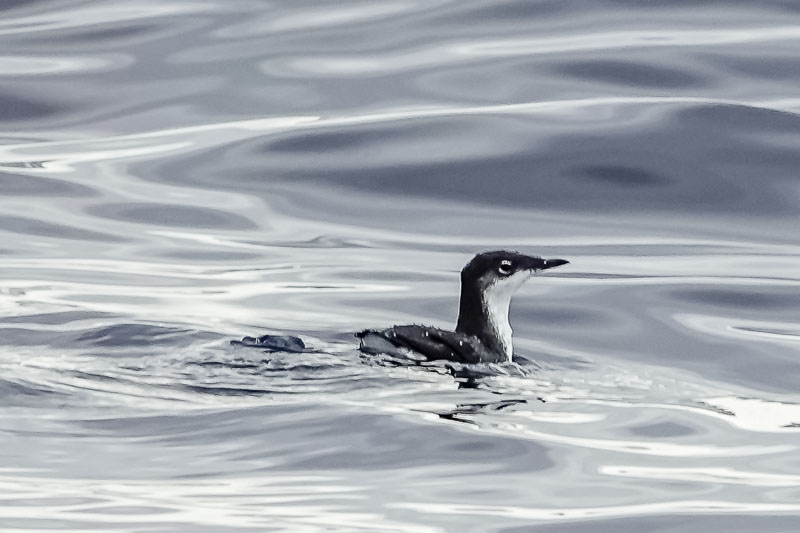 With 16 new birds at that point we had already exceeded my most optimistic projections when we came
across our second mega-rarity, a Scripps's Murrelet. A small black and white seabird which occasionally
wanders north into Westport waters in the fall, it had not been reported for the past three years. I first
saw one on another memorable pelagic trip back in October 2013; I think it was unusual then too.
With 16 new birds at that point we had already exceeded my most optimistic projections when we came
across our second mega-rarity, a Scripps's Murrelet. A small black and white seabird which occasionally
wanders north into Westport waters in the fall, it had not been reported for the past three years. I first
saw one on another memorable pelagic trip back in October 2013; I think it was unusual then too.


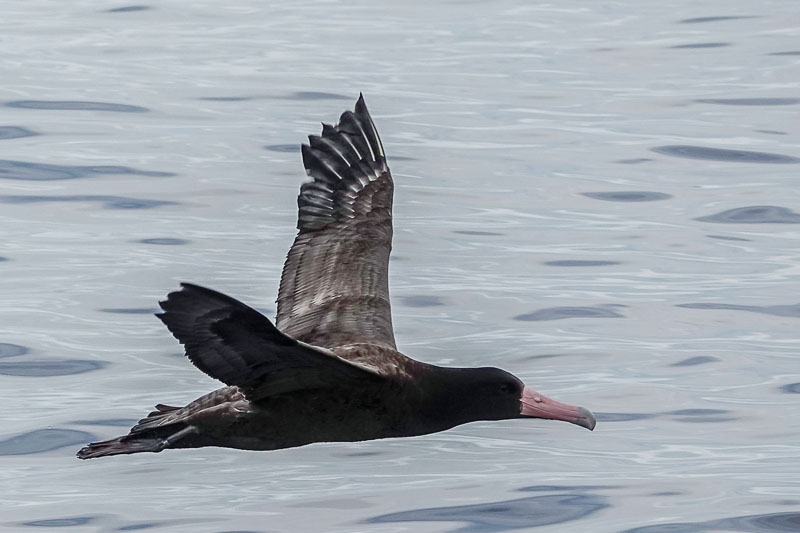 Within 10 minutes of leaving the murrelet we were motoring past a another group of Pink-footed
Shearwaters when someone (I think it was Bill again) noticed a very large dark brown bird with a
bright pink bill sitting on the water with them. Short-tailed Albatross! Our third mega-rarity in
three hours, it is the rarest of the three albatrosses which breed in the North Pacific ocean and a
bird which few people on the boat had ever seen. For Darchelle it was particularly exciting; prior
to each of our past three trips she has named the Short-tailed Albatross as the bird she has most
desired to see.
Within 10 minutes of leaving the murrelet we were motoring past a another group of Pink-footed
Shearwaters when someone (I think it was Bill again) noticed a very large dark brown bird with a
bright pink bill sitting on the water with them. Short-tailed Albatross! Our third mega-rarity in
three hours, it is the rarest of the three albatrosses which breed in the North Pacific ocean and a
bird which few people on the boat had ever seen. For Darchelle it was particularly exciting; prior
to each of our past three trips she has named the Short-tailed Albatross as the bird she has most
desired to see.
Phil cut the engine and we floated quietly in the company of the rare albatross for almost 15 minutes before the big bird got up, padded across the water and flapped heavily away.
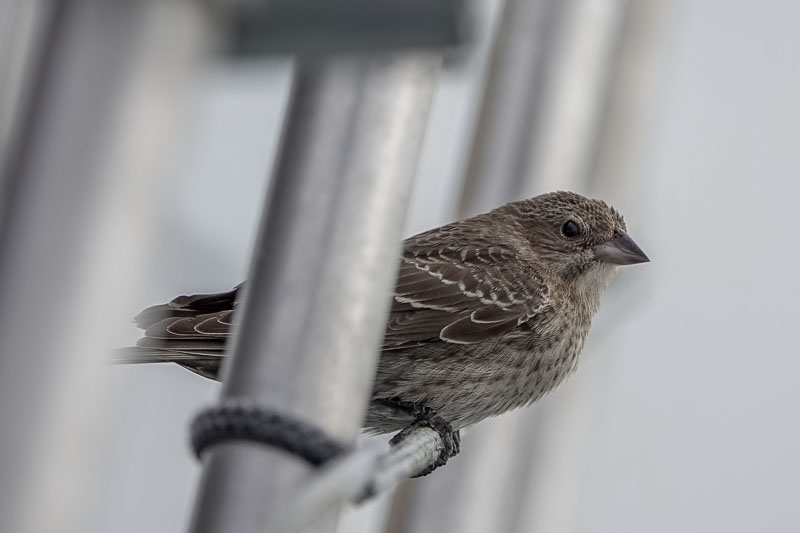
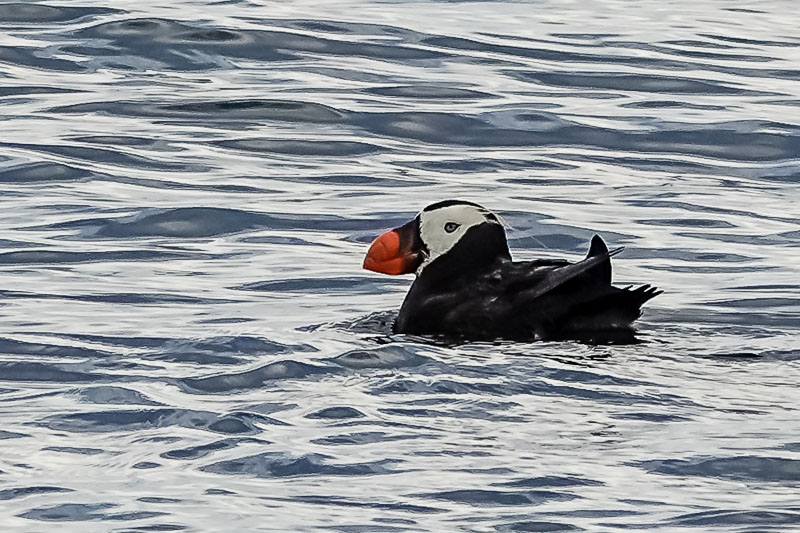
 Shortly after we turned to head inbound from Grays Canyon L+ we met up with another bird rarely found 40 miles
off Westport, a Brown-headed Cowbird. Although they can be quite tame on land it was nervous on
the boat and soon took off low over the water, presumably to its demise. Otherwise the trip in
was relatively uneventful though we did pick up our 19th year bird of the day, a Tufted Puffin
about 25 miles offshore.
Shortly after we turned to head inbound from Grays Canyon L+ we met up with another bird rarely found 40 miles
off Westport, a Brown-headed Cowbird. Although they can be quite tame on land it was nervous on
the boat and soon took off low over the water, presumably to its demise. Otherwise the trip in
was relatively uneventful though we did pick up our 19th year bird of the day, a Tufted Puffin
about 25 miles offshore.

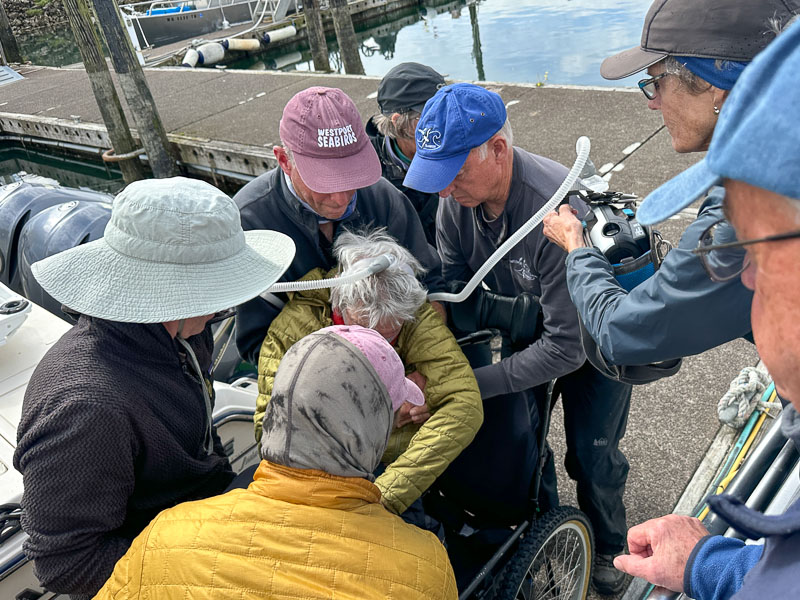
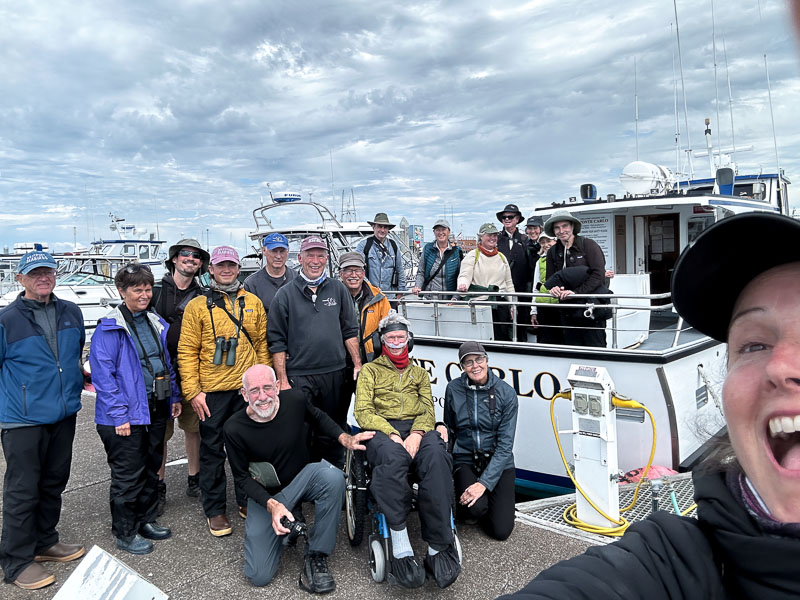 Not only was it an amazing trip in terms of birds, but it was easier than I anticipated as well.
I always worry about getting on and off the boat but many people helped and the transfers went
without a hitch. Bill, in addition to serving as one of the spotters, was especially helpful to
me in pointing out species which I might have overlooked or was unable to identify without optics.
Unlike some past trips I never got too cold. Also unlike past trips, I had to pee but Darchelle had
brought the bottle and it worked fine. I don't know if we'll do another one next year but if not,
what a way to end!
Not only was it an amazing trip in terms of birds, but it was easier than I anticipated as well.
I always worry about getting on and off the boat but many people helped and the transfers went
without a hitch. Bill, in addition to serving as one of the spotters, was especially helpful to
me in pointing out species which I might have overlooked or was unable to identify without optics.
Unlike some past trips I never got too cold. Also unlike past trips, I had to pee but Darchelle had
brought the bottle and it worked fine. I don't know if we'll do another one next year but if not,
what a way to end!

Laysan Albatross (from 2022), Westport offshore

Short-tailed Albatross, Westport offshore

Bruce, Liam, Bill and me, Westport bar

Waiting for the fog to clear, Westport bar

Crossing the bar, Westport bar
The fog began to thin out as the sun rose behind us but we still were not seeing many birds. We passed, or were passed by, an occasional murre or shearwater but no big flocks so I began to adjust my year bird estimates for the day downward. I had initially figured 12-15 new birds would not be unreasonable but after an hour and half in the fog I was prepared to be content with 10-12.

Pink-footed Shearwaters, Westport offshore

Buller's Shearwater, Westport offshore

Pink-footed Shearwaters, Westport offshore

Fork-tailed Storm-Petrel, Westport offshore

Fork-tailed Storm-Petrels, Westport offshore

Wilson's and Fork-tailed Storm-Petrels, Westport offshore
As we were enjoying the FTSP show, one of the participants called out that they had a dark storm
petrel with a white rump. I was able to get on their bird immediately, and noted the extensive
white on the rump wrapped around onto the sides. I immediately called out Wilson's Storm-Petrel and
attempted to get everyone on board on the bird. I noted a dark, almost blackish storm-petrel with
extensive and brightly white rump that continued onto the sides almost to the undertail coverts.
Flight was fairly direct, with relatively shallower wingbeats than nearby FTSP. Wings are broader
in shape than nearby FTSP. When it hovered over the wake, the long legs dangled very obviously.
My view was too distant to identify it without optics but I watched it fly past the boat and over the
wake while Darchelle scrambled to get photos. To my delight she succeeded. Only the seventh state
record, it was a state bird for both of us and our sixth year bird of the trip. Things were looking up!
Shrimp Trawlers, Westport offshore

Red and Red-necked Phalaropes, Westport offshore

Cassin's Auklet, Westport offshore
Ocean conditions were excellent, with essentially no wind (Beaufort 0-1), a light swell from the
west, and overcast skies with occasional light rain.
The birds were excellent too. Along with the Black-footed Albatrosses were several less common
Laysans, a beautiful bird. We saw numerous Sabine's Gulls and Cassin's Auklets, both expected, and
Arctic Terns as well, which we've seen on very few trips. Among the flocks of Red-necked Phalaropes
were a few Red Phalaropes, another bird we needed but were not counting on. Bill pointed out
another hoped-for bird, a Short-tailed Shearwater, in the swirling groups of Pink-footed
Shearwaters. By 11 AM we'd also had good looks at a couple of South Polar Skuas, several
Long-tailed Jaegers and at least one Parasitic Jaeger which, together with the Pomarine we'd seen
earlier, gave us a "Skua Slam" - sightings of all four Washington members of the jaeger family.
That has only happened on about one trip in three over the past four years.
Laysan Albatross, Westport offshore

Laysan and Black-footed Albatrosses, Westport offshore

Scripps's Murrelet, Westport offshore

Short-tailed Albatross with Pink-footed Shearwaters

Short-tailed Albatross with Pink-footed Shearwaters

Short-tailed Albatross, Westport offshore
Phil cut the engine and we floated quietly in the company of the rare albatross for almost 15 minutes before the big bird got up, padded across the water and flapped heavily away.

Brown-headed Cowbird, Westport offshore

Tufted Puffin

Adult Common Murre with young, Westport bar

Delia and Ed, Westport offshore

Carrying me off the boat, Westport Marina

The Fortunate Few, Westport Marina
8/31/2024 August Totals (link to here)
During August we birded 9 days and spent 11 nights away from home, although 7 of those were for a family reunion in Walla Walla. We drove 2114 miles for an ending odometer reading of 124060. Thanks to our pelagic trip on the 26th which contributed 25 species and the morning of the 31st at Steptoe Butte which added 22, we tallied 151 species for the month on 26 complete checklists. That gives us 337 species for the year in Washington, two fewer than a year ago.
During August we birded 9 days and spent 11 nights away from home, although 7 of those were for a family reunion in Walla Walla. We drove 2114 miles for an ending odometer reading of 124060. Thanks to our pelagic trip on the 26th which contributed 25 species and the morning of the 31st at Steptoe Butte which added 22, we tallied 151 species for the month on 26 complete checklists. That gives us 337 species for the year in Washington, two fewer than a year ago.
9/01/2024 Washtucna (link to here)
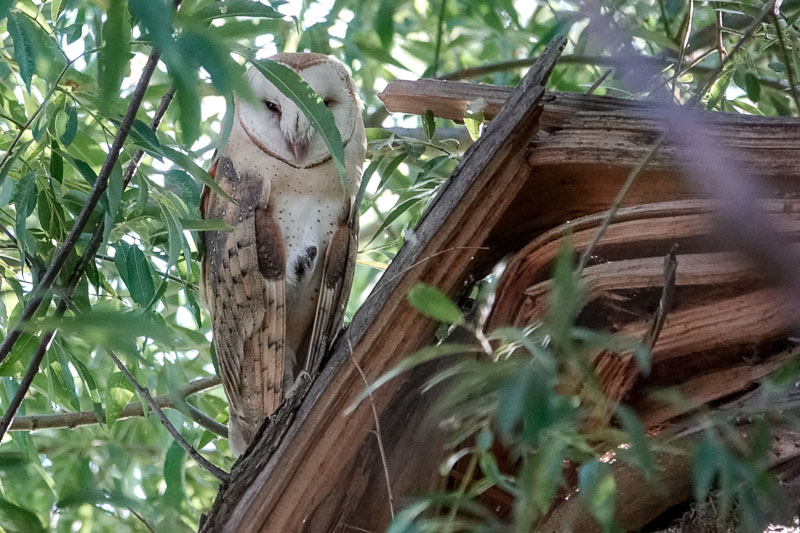
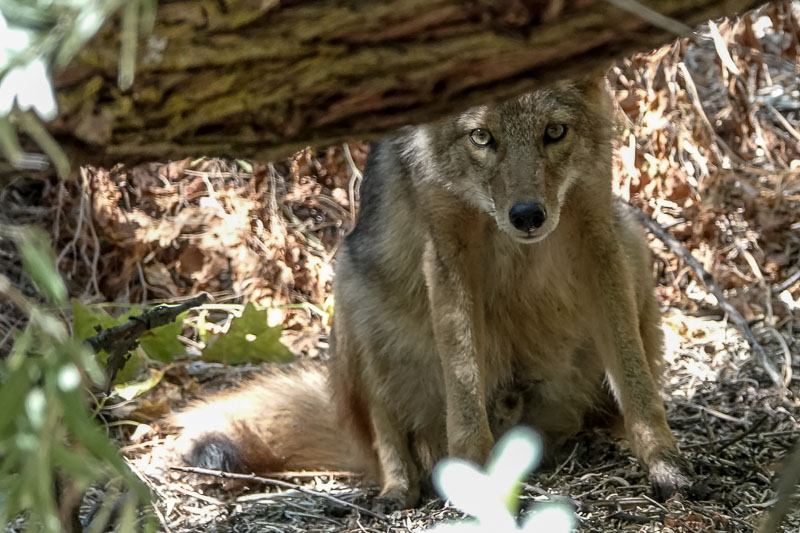
 We spent the night in Othello and drove over to Washtucna early, arriving at Bassett Park L+
by 6:30 though we didn't park my chair in front of the bush right away. The morning was sunny but
cool and there initially wasn't much activity at the bush so we drove around inspecting sparrow
flocks. That might have been a mistake; by the time we returned to the bush it was hopping so we
might have missed a few early birds.
We spent the night in Othello and drove over to Washtucna early, arriving at Bassett Park L+
by 6:30 though we didn't park my chair in front of the bush right away. The morning was sunny but
cool and there initially wasn't much activity at the bush so we drove around inspecting sparrow
flocks. That might have been a mistake; by the time we returned to the bush it was hopping so we
might have missed a few early birds.
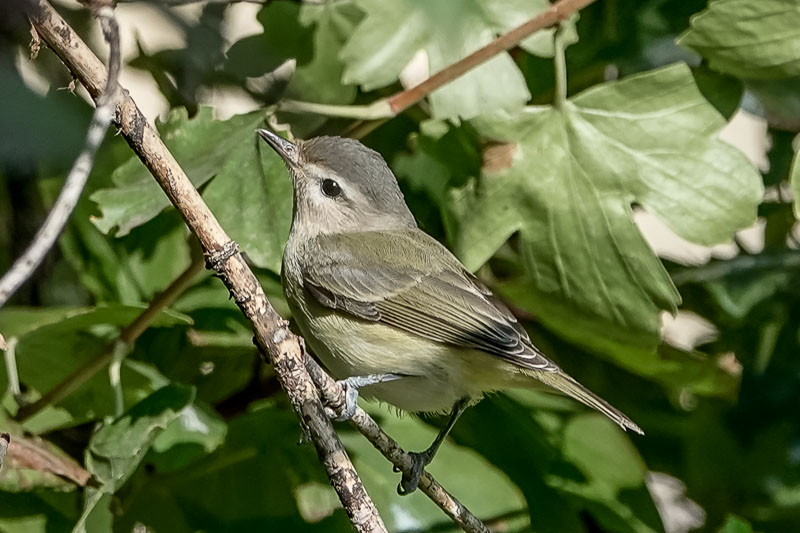
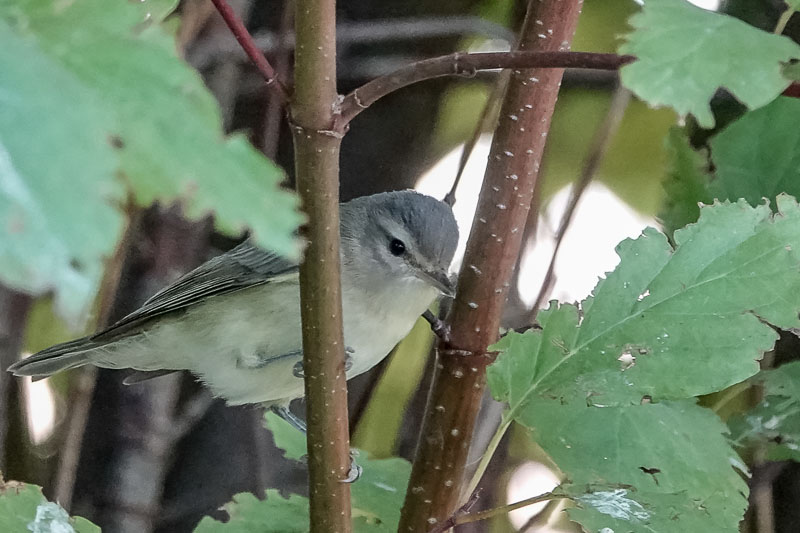
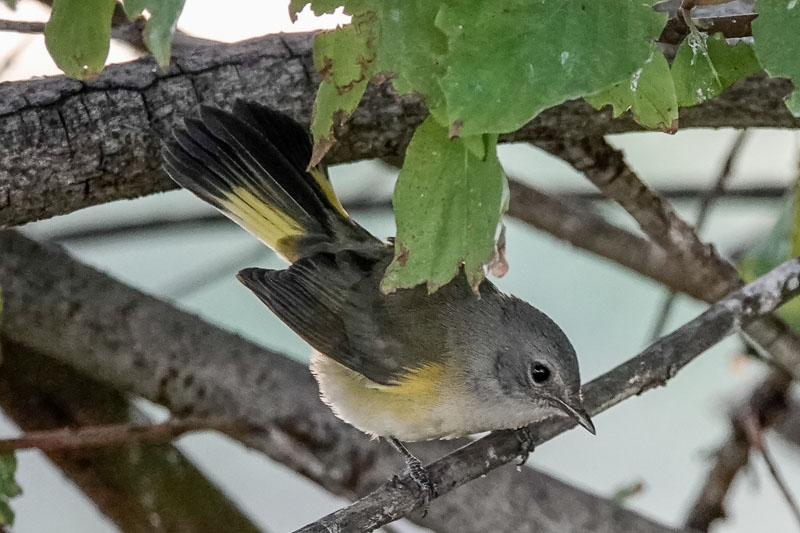 I still did pretty well in four hours of watching the bush, with close views of Warbling Vireos,
Dusky and Hammond's Flycatchers and Wilson's Warblers every few minutes along with an occasional
visit by the previously-reported American Redstart, a new bird for the county for me.
I still did pretty well in four hours of watching the bush, with close views of Warbling Vireos,
Dusky and Hammond's Flycatchers and Wilson's Warblers every few minutes along with an occasional
visit by the previously-reported American Redstart, a new bird for the county for me.
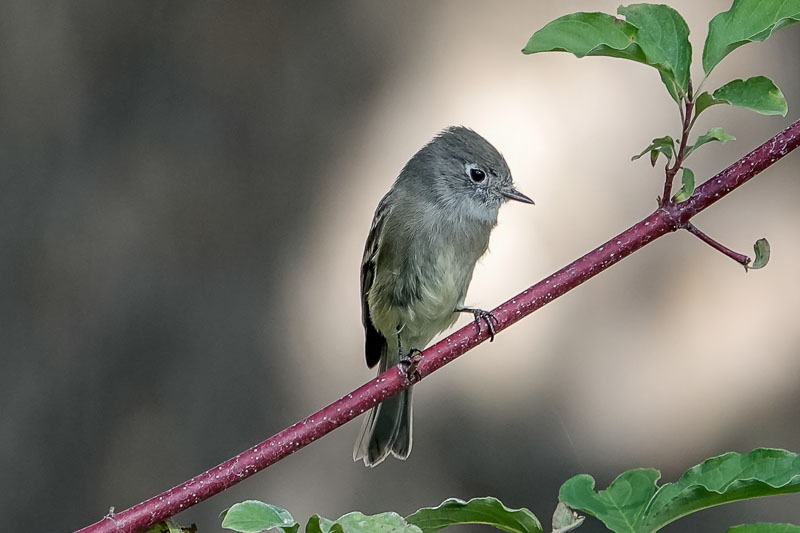
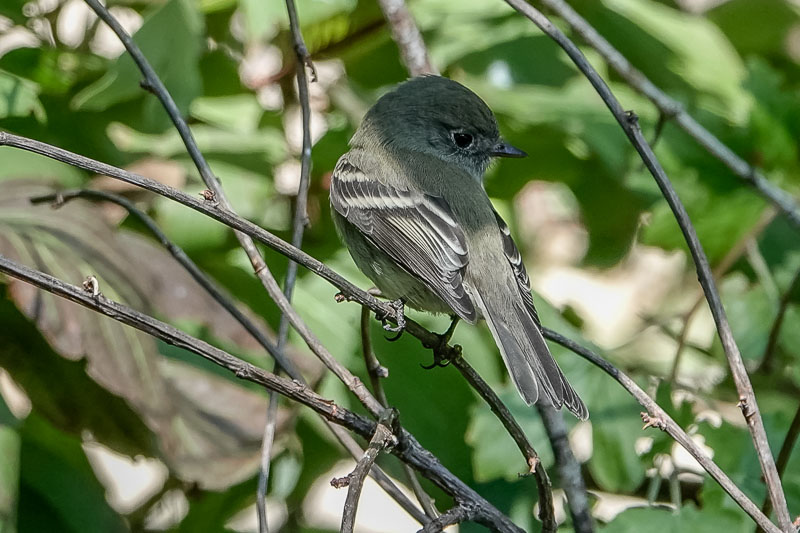
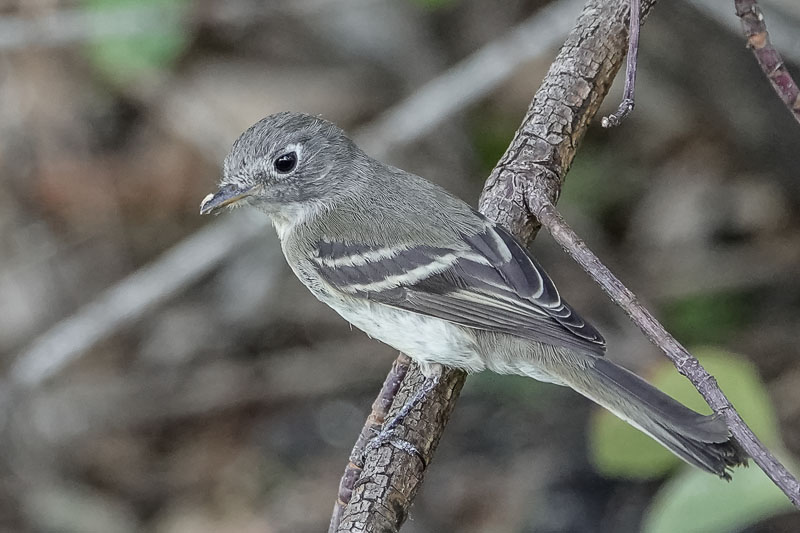 The flycatchers were vocalizing which made it easy to distinguish Dusky ("wit") from Hammond's
("peet") and provided an opportunity to compare plumage characteristics between the two species.
In the fall migration Dusky Flycatchers haven't molted yet so tend to be more gray overall with
more visible feather wear. Hammond's Flycatchers have already molted into fresh plumage with more
olive coloration and more contrast in the underparts. They also tend to have a more crested and
larger-headed appearance which in turn makes the bill appear smaller. Despite the practice
though, at the end of the day a solitary silent bird could still leave me guessing.
The flycatchers were vocalizing which made it easy to distinguish Dusky ("wit") from Hammond's
("peet") and provided an opportunity to compare plumage characteristics between the two species.
In the fall migration Dusky Flycatchers haven't molted yet so tend to be more gray overall with
more visible feather wear. Hammond's Flycatchers have already molted into fresh plumage with more
olive coloration and more contrast in the underparts. They also tend to have a more crested and
larger-headed appearance which in turn makes the bill appear smaller. Despite the practice
though, at the end of the day a solitary silent bird could still leave me guessing.

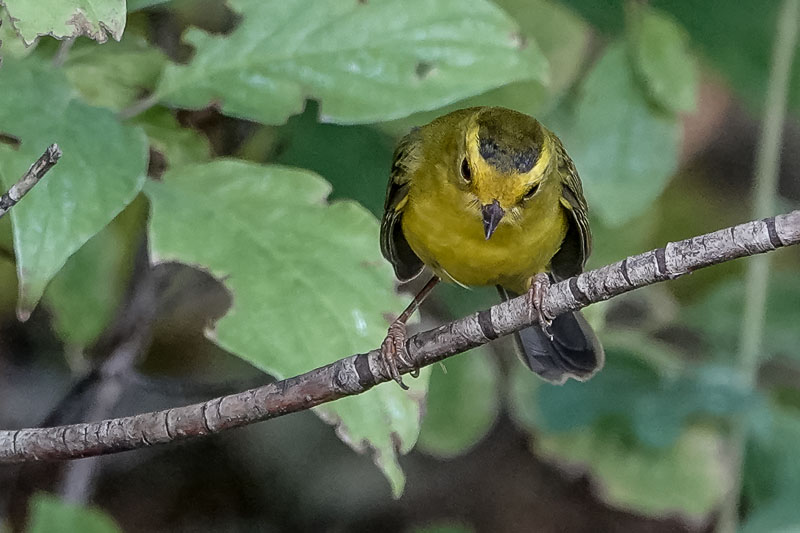
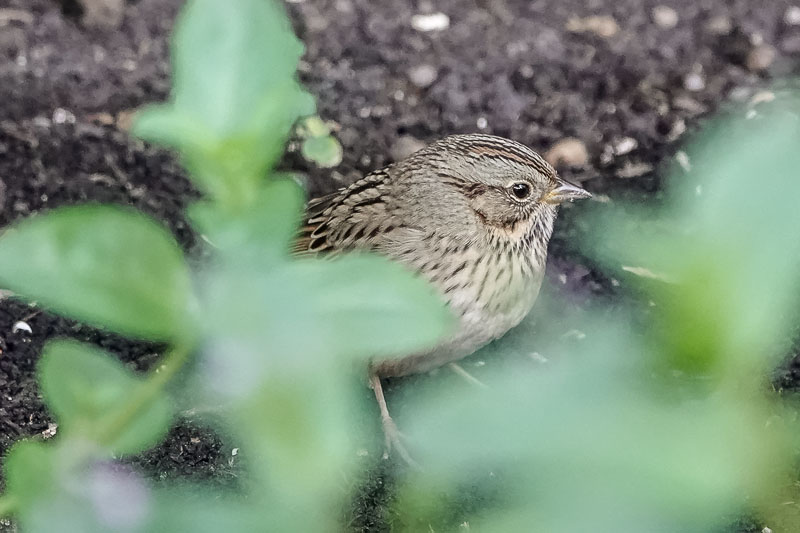 Most of the warblers were Wilson's which, like the other species, visited the bush both to bathe
and to forage. Fat moths were the preferred food item though they were neither easy to catch nor
to subdue once caught. The White-crowned Sparrow in the photo on the left above took a couple of
minutes to get its moth under control, with the young Wilson's Warbler all the while watching
intently.
Most of the warblers were Wilson's which, like the other species, visited the bush both to bathe
and to forage. Fat moths were the preferred food item though they were neither easy to catch nor
to subdue once caught. The White-crowned Sparrow in the photo on the left above took a couple of
minutes to get its moth under control, with the young Wilson's Warbler all the while watching
intently.

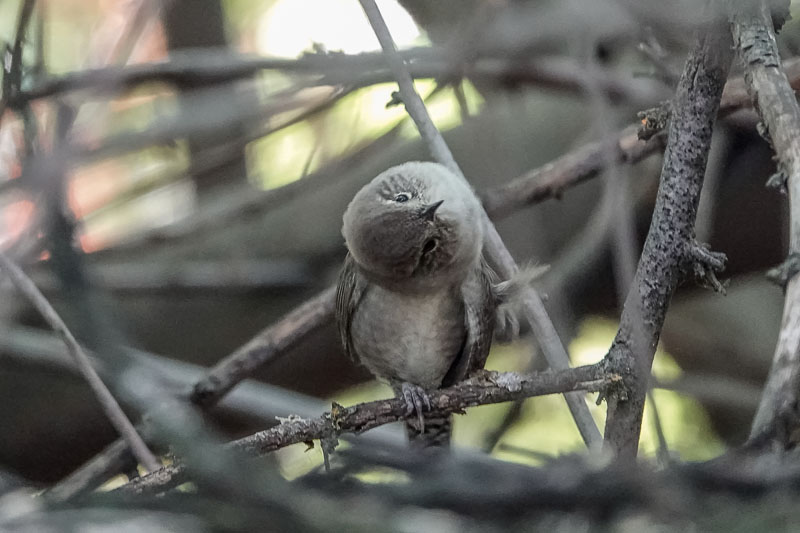
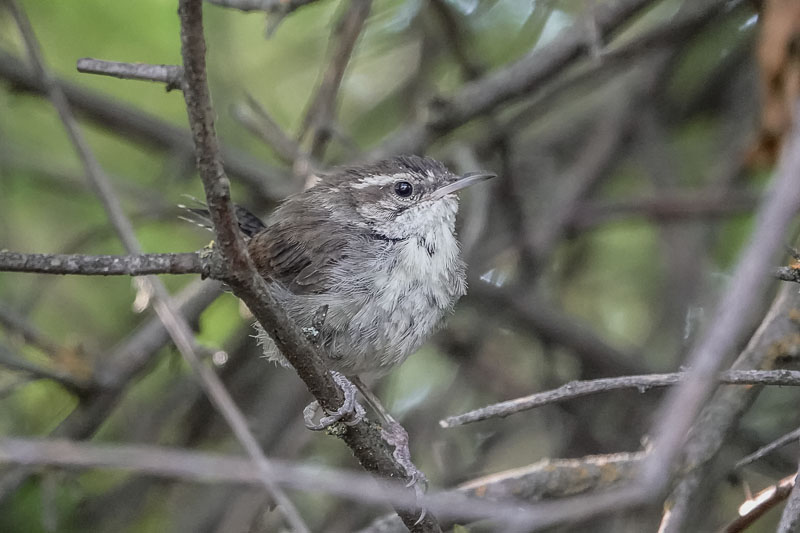 Among the birds which did not visit the bush were the wrens. Darchelle, watching the willows up
beyond the swimming pool at the northeast corner of the park, had three species - the two
pictured above along with a Rock Wren.
Among the birds which did not visit the bush were the wrens. Darchelle, watching the willows up
beyond the swimming pool at the northeast corner of the park, had three species - the two
pictured above along with a Rock Wren.
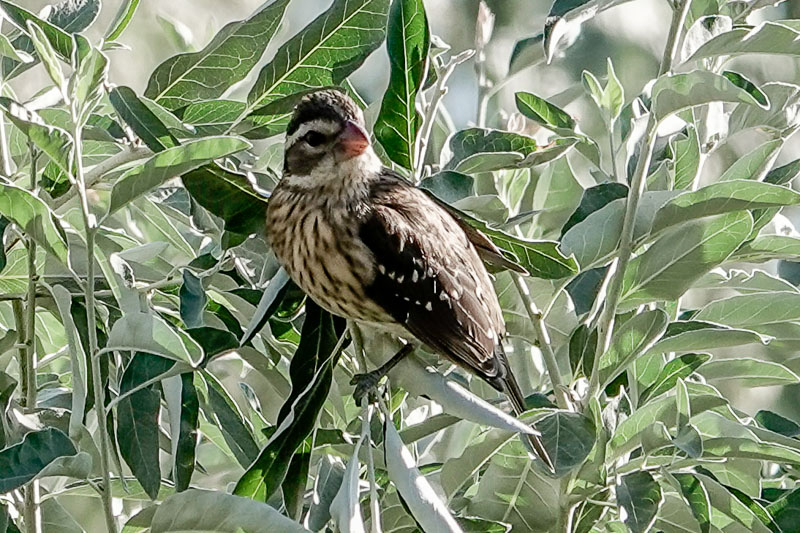
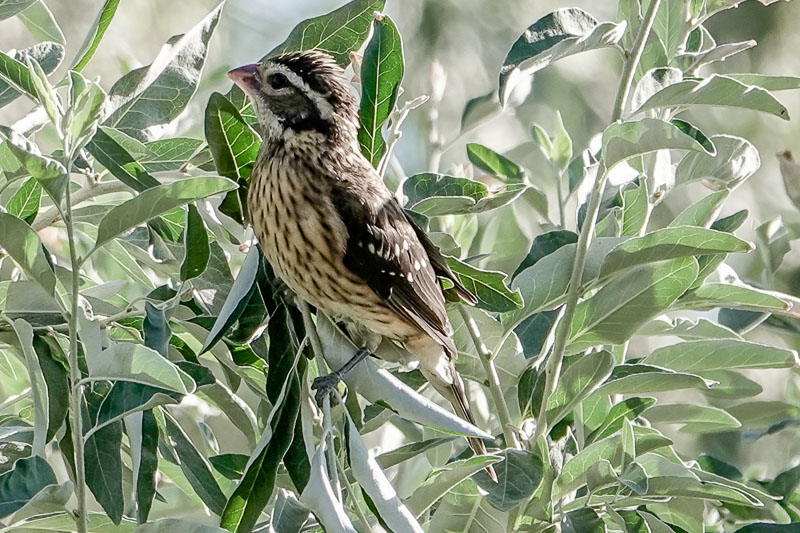
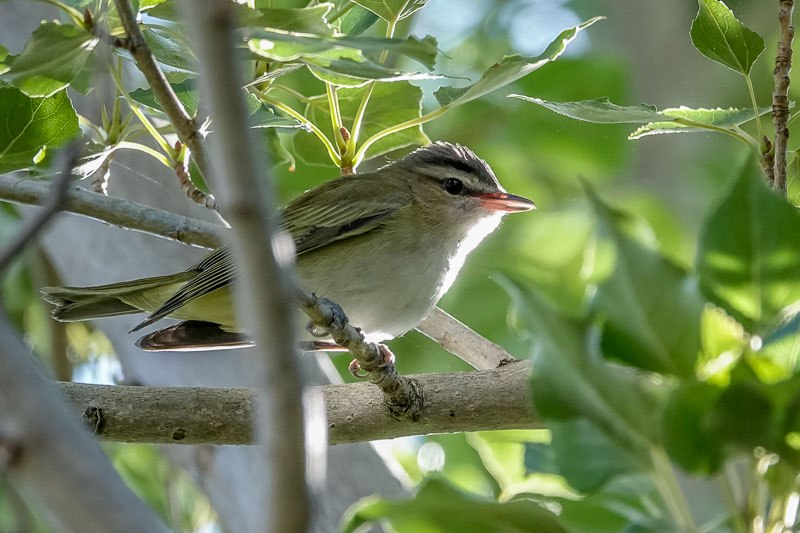 Also in the willows were the two best birds of the day. The Red-eyed Vireo would have been another
county bird for me but the grosbeak was also a year bird, putting her one ahead of me in the
eBird Top 100 +.
Neither bird lingered long enough for her to come down to get me and even if she had, the
path up there was too steep for us to negotiate with the wheelchair. I was sorry to miss them
but delighted that she was able to get photos.
Also in the willows were the two best birds of the day. The Red-eyed Vireo would have been another
county bird for me but the grosbeak was also a year bird, putting her one ahead of me in the
eBird Top 100 +.
Neither bird lingered long enough for her to come down to get me and even if she had, the
path up there was too steep for us to negotiate with the wheelchair. I was sorry to miss them
but delighted that she was able to get photos.

Barn Owl, Bassett Park

Coyote, Bassett Park

Porcupine, Bassett Park

Warbling Vireo, Bassett Park

Warbling Vireo, Bassett Park

American Redstart, Bassett Park

Hammond's Flycatcher, Bassett Park

Hammond's Flycatcher, Bassett Park

Dusky Flycatcher, Bassett Park

White-crowned Sparrow and Wilson's Warbler, Bassett Park

Wilson's Warbler, Bassett Park

Lincoln's Sparrow, Bassett Park

Northern House Wren, Bassett Park

Northern House Wren, Bassett Park

Bewick's Wren, Bassett Park

Rose-breasted Grosbeak, Bassett Park

Rose-breasted Grosbeak, Bassett Park

Red-eyed Vireo, Bassett Park
9/04/2024 Canada Warbler (link to here)
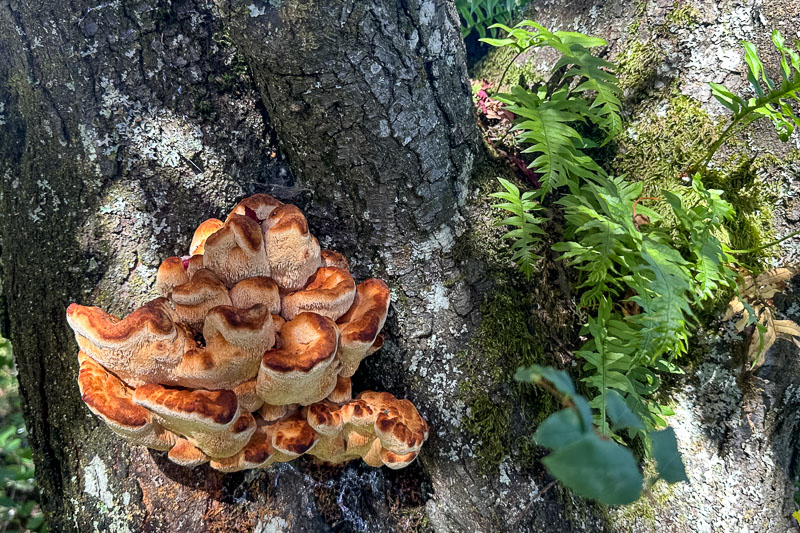
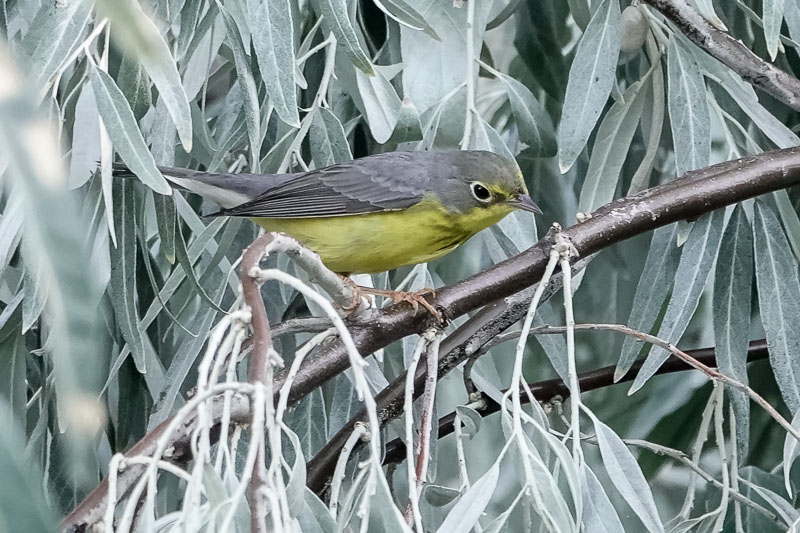
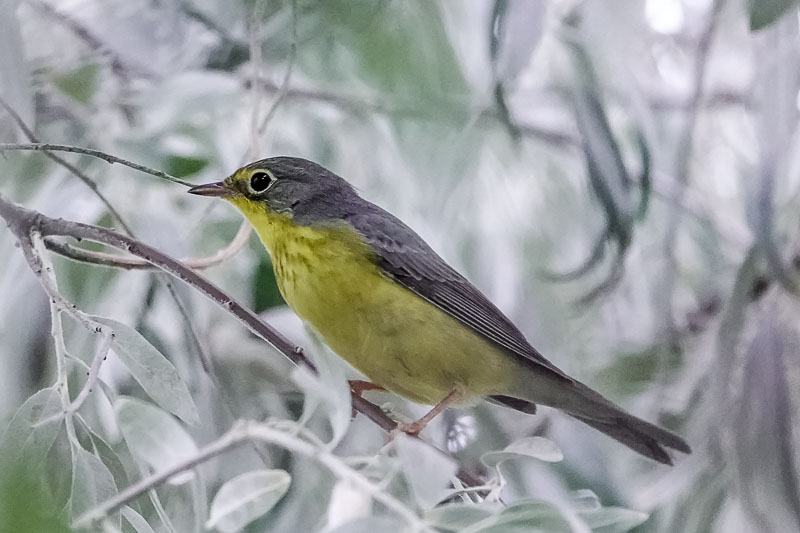 Vagrant eastern species such as the Canada Warbler which Scott D discovered at Potholes State
Park two days ago are always a priority for us but they often do not linger long so unless they are
close to home, I prefer to wait for another report. Matt Y provided that report this morning
so we left as soon as possible which was unfortunately not until 2 PM, though this time that was
soon enough. Lisa H, who'd also seen it this morning, offered to return and help us find the
notoriously secretive bird. She pulled into Potholes L+ just minutes after we did but thanks to a photographer
who was tracking it when we'd arrived, we had already managed to see it ourselves.
Vagrant eastern species such as the Canada Warbler which Scott D discovered at Potholes State
Park two days ago are always a priority for us but they often do not linger long so unless they are
close to home, I prefer to wait for another report. Matt Y provided that report this morning
so we left as soon as possible which was unfortunately not until 2 PM, though this time that was
soon enough. Lisa H, who'd also seen it this morning, offered to return and help us find the
notoriously secretive bird. She pulled into Potholes L+ just minutes after we did but thanks to a photographer
who was tracking it when we'd arrived, we had already managed to see it ourselves.
Our decision to stick around and try for photos of the Canada Warbler cost us the opportunity to pick up another rare eastern warbler. We had been planning to head over to Hooper from Potholes and we done so, we'd have been there when RJ Baltierra found the only Blackpoll Warbler of the season. Instead we chased the Canada around its Russian Olive patch until Darchelle was able to get decent photos and I was able to get decent views. In the end I didn't regret our choice; I've appreciated the photos more than I would have the additional year tick for the Blackpoll and we enjoyed the visit with Lisa. After the Canada went to bed we went over to Perch Point L+ with Lisa and found a couple of Stilt Sandpipers, which I think were new for her, then we drove down to Othello and went to bed ourselves.
BTW, the mushroom on our plum tree which our neighbor Z pointed out to us as we were backing out of our drveway was not, as she thought, a Sulfur Shelf, but I was unable to definitively identify it.

Not a Sulfur Shelf

Canada Warbler, Potholes SP

Canada Warbler, Potholes SP
Our decision to stick around and try for photos of the Canada Warbler cost us the opportunity to pick up another rare eastern warbler. We had been planning to head over to Hooper from Potholes and we done so, we'd have been there when RJ Baltierra found the only Blackpoll Warbler of the season. Instead we chased the Canada around its Russian Olive patch until Darchelle was able to get decent photos and I was able to get decent views. In the end I didn't regret our choice; I've appreciated the photos more than I would have the additional year tick for the Blackpoll and we enjoyed the visit with Lisa. After the Canada went to bed we went over to Perch Point L+ with Lisa and found a couple of Stilt Sandpipers, which I think were new for her, then we drove down to Othello and went to bed ourselves.
BTW, the mushroom on our plum tree which our neighbor Z pointed out to us as we were backing out of our drveway was not, as she thought, a Sulfur Shelf, but I was unable to definitively identify it.
9/05/2024 Hooper to Ione (link to here)
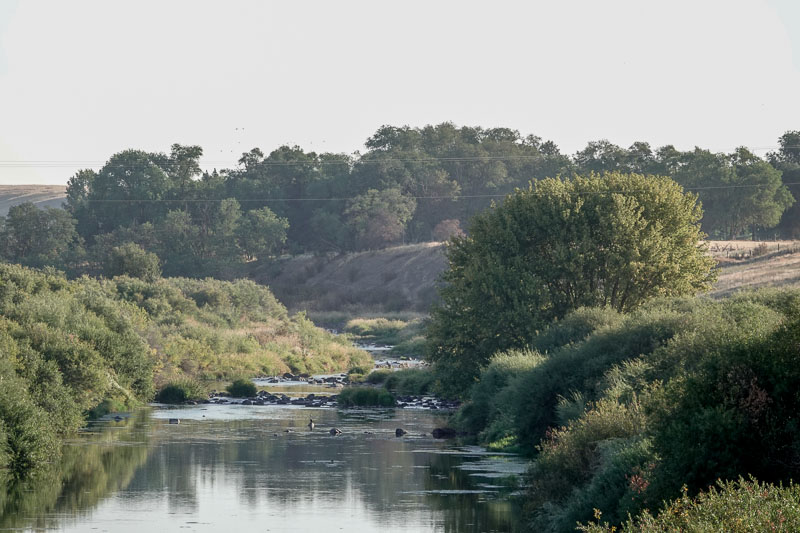
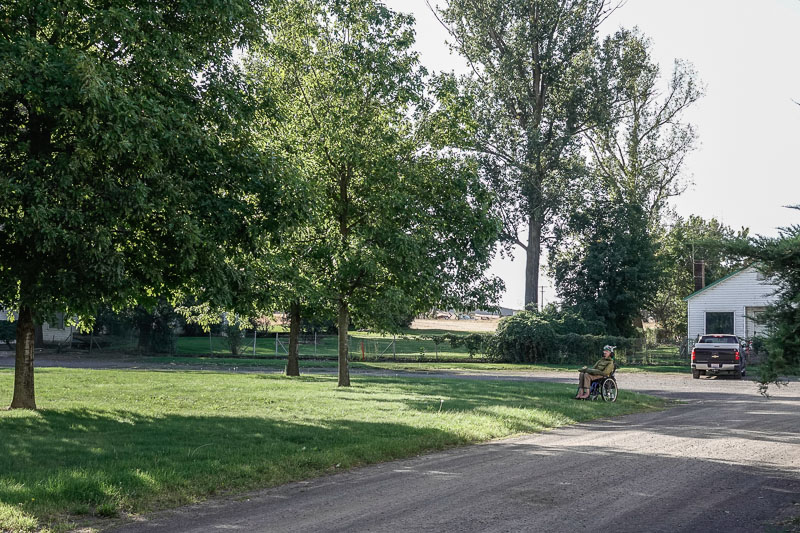
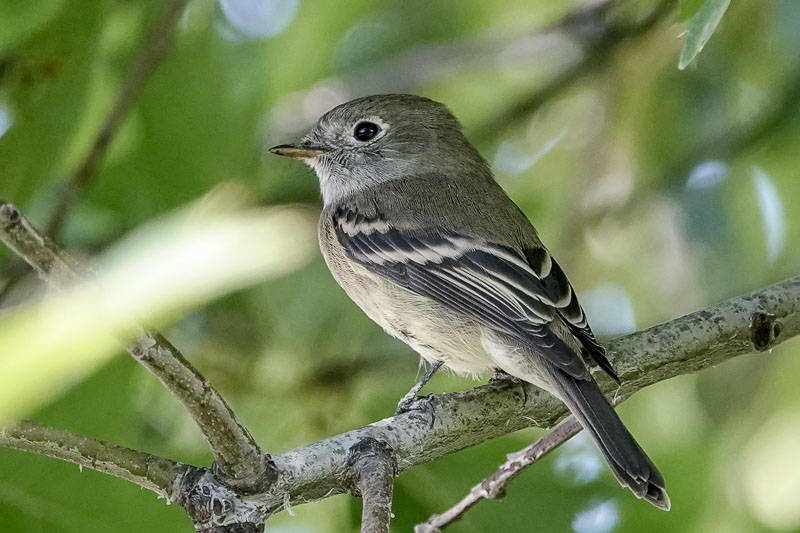 The Blackpoll was no longer at Hooper L+ when we arrived but we did add three species to our Whitman County
list, including a previously reported but improbably situated Canyon Wren calling around one of the
outbuildings. We added three more species along the Palouse River L+ on our way into town.
The Blackpoll was no longer at Hooper L+ when we arrived but we did add three species to our Whitman County
list, including a previously reported but improbably situated Canyon Wren calling around one of the
outbuildings. We added three more species along the Palouse River L+ on our way into town.
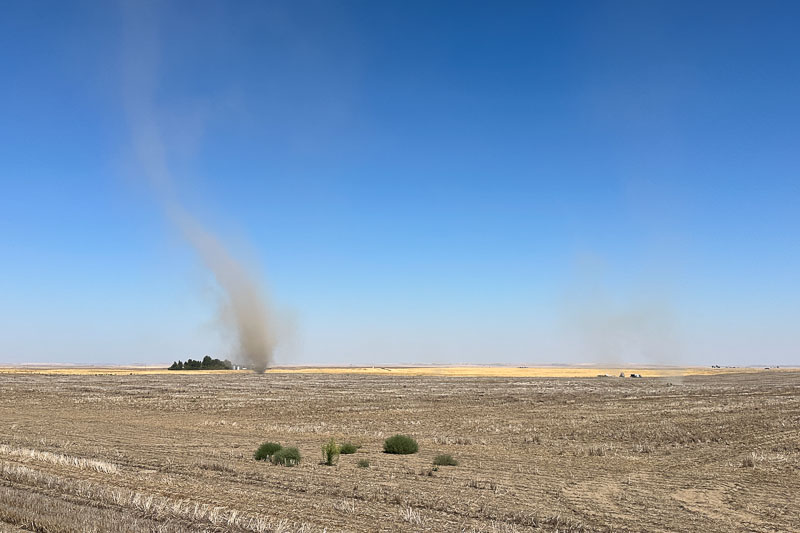
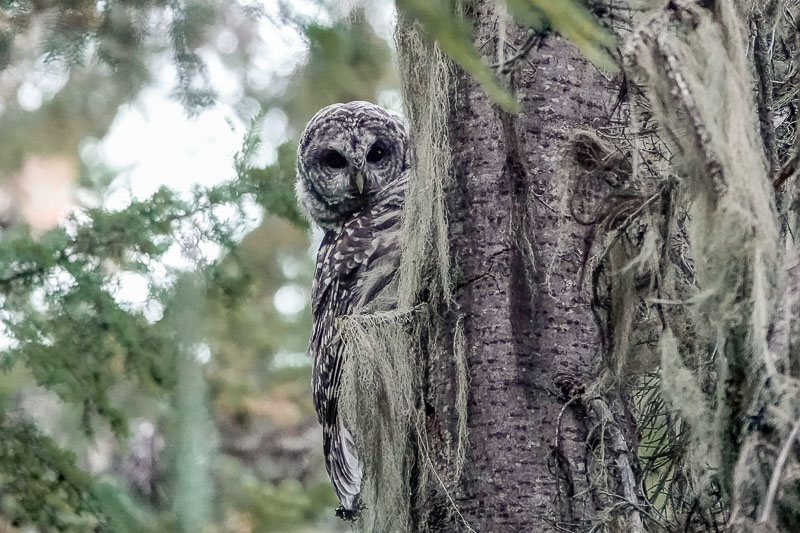
 Ione, in the northeast corner of the state, was our next destination and Spruce Grouse our next
target bird. We had seen several along NF 200 below the Bear Pasture Trailhead
two years ago and were hoping to repeat that experience. We drove all the way up
there only to find the road gated and closed until November two miles shy of our grouse spot. The
Barred Owl that we flushed on our trip back down was our first one for Pend Oreille County but I
would have preferred to have seen a Spruce Grouse. Being in the neighborhood we drove up to
Salmo Pass L+ and
called up both Boreal Owls (at the pass) and Saw-whet Owls (about a half mile below the pass)
allowing us a rare opportunity to compare their "skiu" calls in the field.
Ione, in the northeast corner of the state, was our next destination and Spruce Grouse our next
target bird. We had seen several along NF 200 below the Bear Pasture Trailhead
two years ago and were hoping to repeat that experience. We drove all the way up
there only to find the road gated and closed until November two miles shy of our grouse spot. The
Barred Owl that we flushed on our trip back down was our first one for Pend Oreille County but I
would have preferred to have seen a Spruce Grouse. Being in the neighborhood we drove up to
Salmo Pass L+ and
called up both Boreal Owls (at the pass) and Saw-whet Owls (about a half mile below the pass)
allowing us a rare opportunity to compare their "skiu" calls in the field.

Palouse River, Hooper

Birdwatching in Hooper

Hammond's Flycatcher, Hooper

Dust devil, Bemis WA

Barred Owl, Sullivan Lake

Riverview Motel, Ione
9/06/2024 Bunchgrass Meadows (link to here)
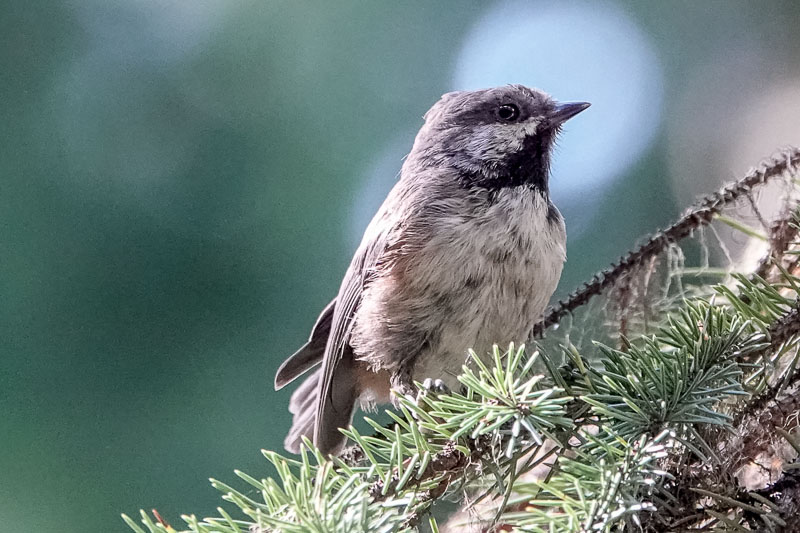
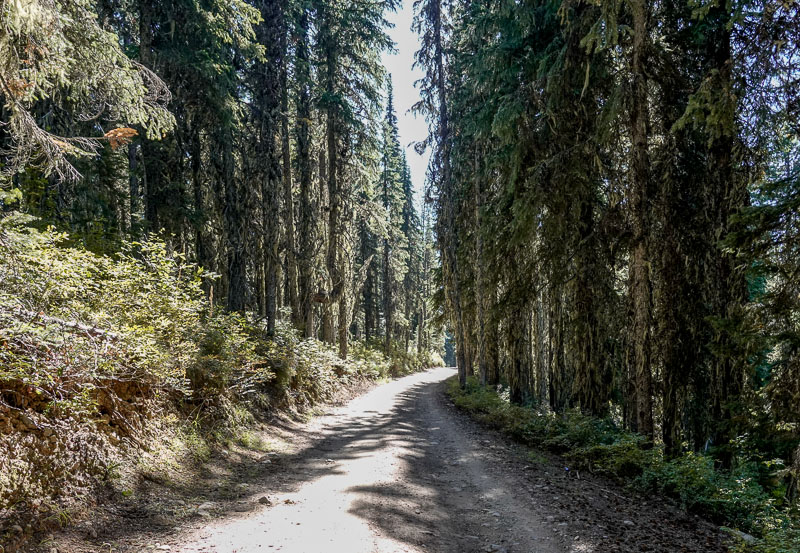
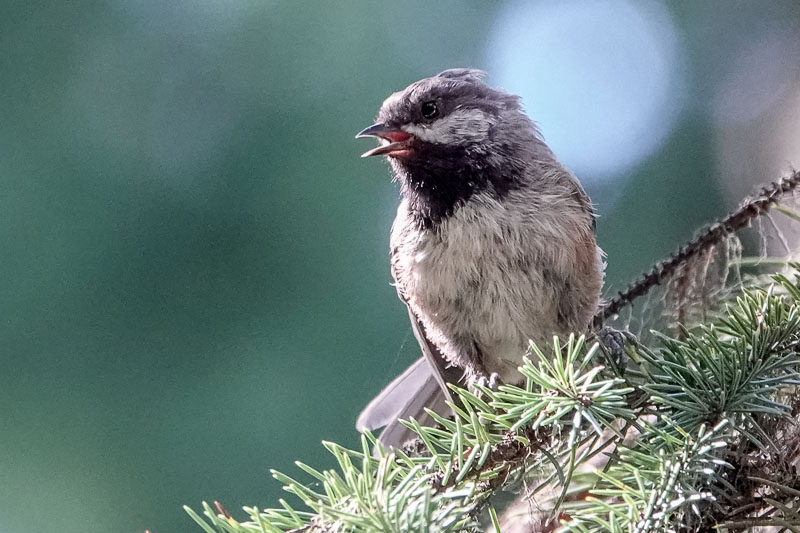 Bunchgrass Meadows
L+ had been on our itinerary for this morning, to try for Boreal Chickadees (resident in the
area) and White -winged Crossbills (present most years except, apparently, this year), and now,
Spruce Grouse as well. They also dwell in the Engelman Spruce and Lodgepole Pine forests around the
broad marshy meadows but on more visits than not, I fail to find them there. Of course, that is
true of virtually everywhere else we search for them as well. This time though we, or rather
Darchelle, found them, thanks to her sharp hearing and her familiarity with their intimate little
calls. Neither of us saw them but she heard them well and I, not so well. The chickadees were
easier, almost flying into her face in response to her calls.
Bunchgrass Meadows
L+ had been on our itinerary for this morning, to try for Boreal Chickadees (resident in the
area) and White -winged Crossbills (present most years except, apparently, this year), and now,
Spruce Grouse as well. They also dwell in the Engelman Spruce and Lodgepole Pine forests around the
broad marshy meadows but on more visits than not, I fail to find them there. Of course, that is
true of virtually everywhere else we search for them as well. This time though we, or rather
Darchelle, found them, thanks to her sharp hearing and her familiarity with their intimate little
calls. Neither of us saw them but she heard them well and I, not so well. The chickadees were
easier, almost flying into her face in response to her calls.

Boreal Chickadee, Bunchgrass Meadows

Spruce Forest, Bunchgrass Meadows

Boreal Chickadee, Bunchgrass Meadows
9/07/2024 Lincoln County (link to here)
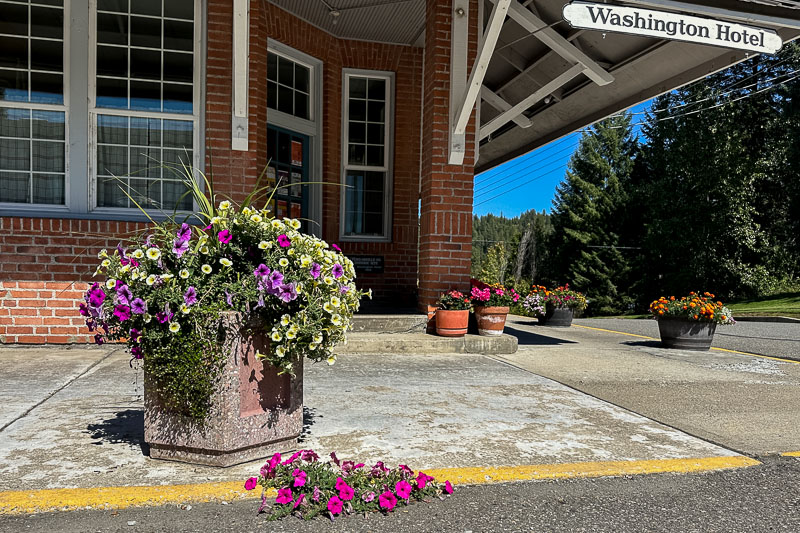
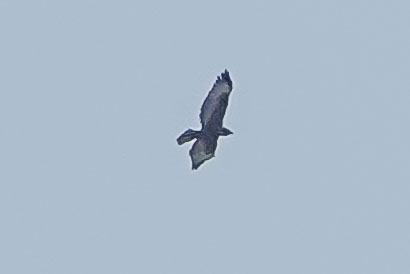
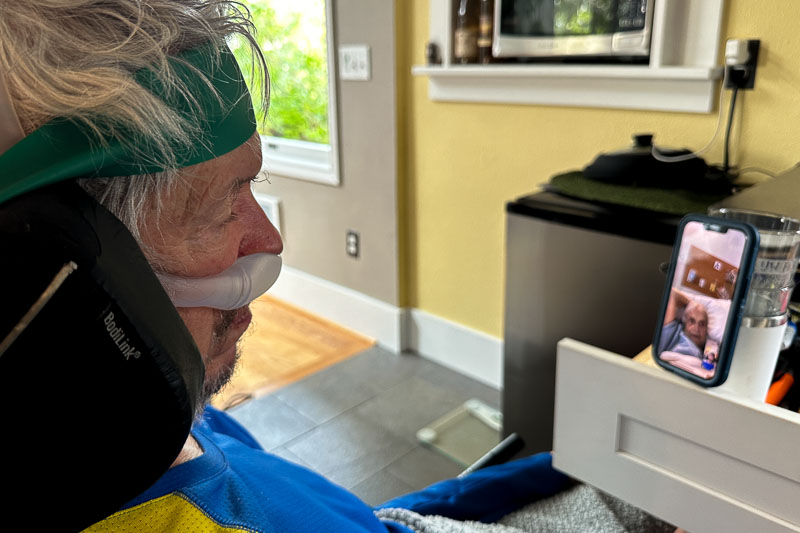 After Bunchgrass Meadows yesterday we stopped by the café in Metalline Falls for lunch but the food
was not as good as I remembered. While I was out front in the car I noticed the pink Petunia
growing in the crack between the sidewalk and the street as if it had fallen out of the flowerpot
behind it. I doubt that it could have rooted there on its own but even if intentionally planted,
how it was managing to thrive in that location is, as my mother used to say, "just one of life's
little mysteries".
After Bunchgrass Meadows yesterday we stopped by the café in Metalline Falls for lunch but the food
was not as good as I remembered. While I was out front in the car I noticed the pink Petunia
growing in the crack between the sidewalk and the street as if it had fallen out of the flowerpot
behind it. I doubt that it could have rooted there on its own but even if intentionally planted,
how it was managing to thrive in that location is, as my mother used to say, "just one of life's
little mysteries".
We spent the night in Colville at the Comfort Inn. In the morning we drove along the Colville River upstream to Springdale and along Chamokane Creek downstream to Long Lake and the Spokane River, all the while following a broad flat valley which is too large to have been carved by either stream, suggesting that it was formed, or at least enlarged by, the southward expansion of the Pleistocene continental glacier(s).
Geology was not our focus though. We were planning to look for birds along the northern edge of Lincoln County where pine and fir forest begins to replace the grasslands (and wheat fields) of the Columbia Plateau. We spent a day in that area in early July last year and added a number of summer birds to our county list but today we were looking for migrants, perhaps even a vagrant or two. We began on Fisher Road L+, worked our way down to Mill Canyon L+ and ended up at Davenport Cemetery L+. Of the 11 new birds we added for the county only one, a Broad-winged hawk above Mill Canyon, could be considered rare. It would be our only Broad-wing all year. Davenport Cemetery had a nice mix of migrants but nothing rare.

Stray Petunias, Washington Hotel, Metalline Falls

Broad-winged Hawk, Mill Canyon

Talking with Mom in the Nursing Home
We spent the night in Colville at the Comfort Inn. In the morning we drove along the Colville River upstream to Springdale and along Chamokane Creek downstream to Long Lake and the Spokane River, all the while following a broad flat valley which is too large to have been carved by either stream, suggesting that it was formed, or at least enlarged by, the southward expansion of the Pleistocene continental glacier(s).
Geology was not our focus though. We were planning to look for birds along the northern edge of Lincoln County where pine and fir forest begins to replace the grasslands (and wheat fields) of the Columbia Plateau. We spent a day in that area in early July last year and added a number of summer birds to our county list but today we were looking for migrants, perhaps even a vagrant or two. We began on Fisher Road L+, worked our way down to Mill Canyon L+ and ended up at Davenport Cemetery L+. Of the 11 new birds we added for the county only one, a Broad-winged hawk above Mill Canyon, could be considered rare. It would be our only Broad-wing all year. Davenport Cemetery had a nice mix of migrants but nothing rare.
9/12/2024 Emails (link to here)
I wrote two emails today. It took me three hours.
I wrote two emails today. It took me three hours.
In other news, we have been tracking weather forecasts and migration statistics for the Columbia
Basin in an attempt to time our visit to Washtucna to coincide with a fallout of migrants.
Migration numbers so far this month have been lower than normal and I suspect that may be due to the
weather. The wind for the past week has been mostly out of the south, a headwind for southbound
birds which may be discouraging them from taking flight. They won't wait forever for favorable
weather so we anticipate a big flight in response to a change in the wind sometime in the next few
days.
Along the coast that big flight happened last night +. It appears that the wind shifted to the northwest during the night prompting much larger migration than on the previous several nights. On the east side of the mountains though, the winds remained southerly and the numbers of migrating birds ranged from 50% of normal along the northern tier + of counties to only 10% of normal in the southeast +. Weather systems move across the state from west to east so we are hoping that what happened along the coast last night will happened over Washtucna tonight.
Along the coast that big flight happened last night +. It appears that the wind shifted to the northwest during the night prompting much larger migration than on the previous several nights. On the east side of the mountains though, the winds remained southerly and the numbers of migrating birds ranged from 50% of normal along the northern tier + of counties to only 10% of normal in the southeast +. Weather systems move across the state from west to east so we are hoping that what happened along the coast last night will happened over Washtucna tonight.
9/15/2024 Walla Walla (link to here)
The flight over Adams county + was indeed big; at 2.7 million birds it was the third largest flight of the past four years. Excited by the prospect of a busy day at Bassett Park, we left David and Kasey to fend for themselves for breakfast and pulled out of the driveway at 5:35 AM headed for Washtucna. The bush was full of birds when we arrived at 8:30 so Darchelle wheeled me
over and parked me in front of it but the activity died down quickly and never picked up again.
RJ dropped by around 10 to report that he had never seen so many birds at Hooper as he had that
morning, adding to the mystery of the Washtucna big day that wasn't. Giving up on Washtucna we
drove down to Lyon's Ferry where I sat in the car and counted juncos flying between the fruit trees
while Darchelle searched for vagrants in the thickets along the shore. I came up with 51 and she
came up with a thrush which she was unable to turn into an Ovenbird.
headed for Washtucna. The bush was full of birds when we arrived at 8:30 so Darchelle wheeled me
over and parked me in front of it but the activity died down quickly and never picked up again.
RJ dropped by around 10 to report that he had never seen so many birds at Hooper as he had that
morning, adding to the mystery of the Washtucna big day that wasn't. Giving up on Washtucna we
drove down to Lyon's Ferry where I sat in the car and counted juncos flying between the fruit trees
while Darchelle searched for vagrants in the thickets along the shore. I came up with 51 and she
came up with a thrush which she was unable to turn into an Ovenbird.
We spent Sabbath with Darchelle's folks in Walla Walla, not even slightly tempted to chase birds after our disappointing experience on Friday though I did do checklists on both Friday afternoon L+ and Saturday afternoon L+ while sitting outside visiting with Richard and Donna. The flyover Nighthawks on Friday and Wood Ducks on Saturday both stumped me at first but Darchelle was able to get binoculars on them to confirm the wing pattern on the former and the face pattern on the latter.
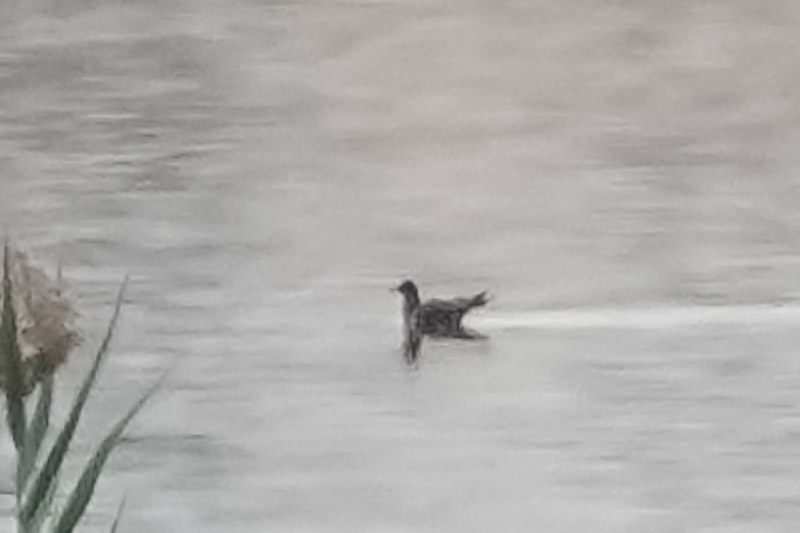

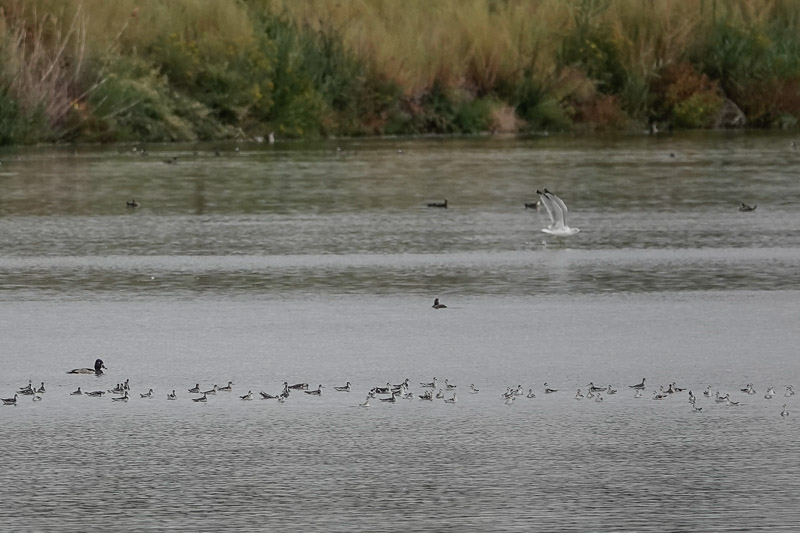 On our way home this afternoon we stopped at McNary NWR L+ to look for a Long-tailed Jaeger which had
been discovered at the headquarters ponds this morning. While Darchelle was scoping distant ducks
in the marshy cove where the jaeger had been reported half an hour earlier I spotted a dark brown
gull flying erratically out over the open water and tried to follow it, suspecting it might be
the bird. Shortly after I lost it Darchelle found it again and confirmed that it was a jaeger
by the white patches at the base of the primaries. Whether or not it was a Long-tailed is still
being debated by those with greater knowledge and better photos. As for myself, after watching
the bird in flight and reviewing Jeff Blake's photos here + along with photos of both
Long-tailed + and
Parasitic + Jaegers on eBird, I believe that the bird is a Long-tailed Jaeger for
the following reasons:
On our way home this afternoon we stopped at McNary NWR L+ to look for a Long-tailed Jaeger which had
been discovered at the headquarters ponds this morning. While Darchelle was scoping distant ducks
in the marshy cove where the jaeger had been reported half an hour earlier I spotted a dark brown
gull flying erratically out over the open water and tried to follow it, suspecting it might be
the bird. Shortly after I lost it Darchelle found it again and confirmed that it was a jaeger
by the white patches at the base of the primaries. Whether or not it was a Long-tailed is still
being debated by those with greater knowledge and better photos. As for myself, after watching
the bird in flight and reviewing Jeff Blake's photos here + along with photos of both
Long-tailed + and
Parasitic + Jaegers on eBird, I believe that the bird is a Long-tailed Jaeger for
the following reasons:
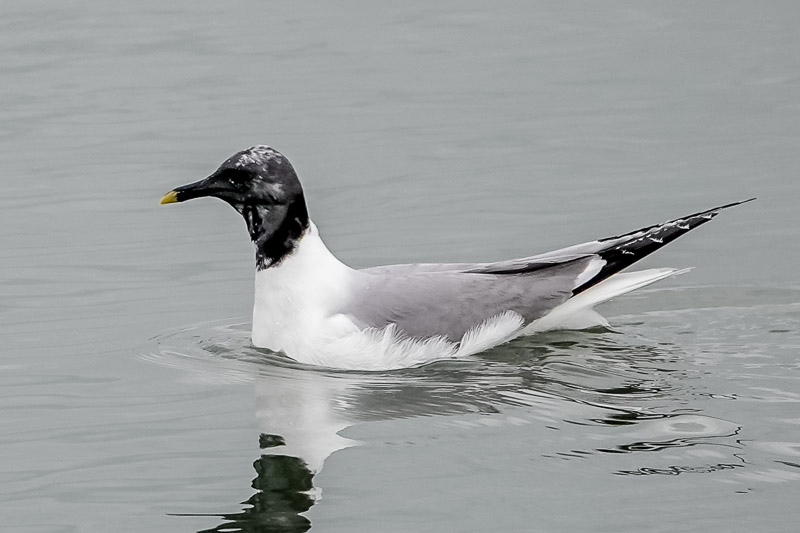
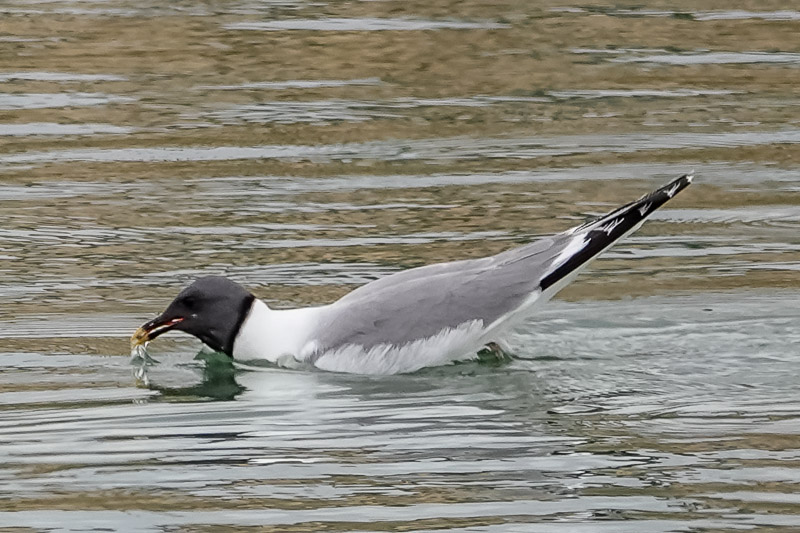
 The Long-tailed Jaeger was not the only pelagic bird at the McNary ponds this afternoon. When we
arrived two Sabine's Gulls were paddling around right next to the causeway and as we departed, a
large flock of Red-necked Phalaropes was milling about on the east pond. I particularly enjoyed
the close-up views of the former, which btw is a species not often recorded on the same checklist
as Blue-winged Teal.
The Long-tailed Jaeger was not the only pelagic bird at the McNary ponds this afternoon. When we
arrived two Sabine's Gulls were paddling around right next to the causeway and as we departed, a
large flock of Red-necked Phalaropes was milling about on the east pond. I particularly enjoyed
the close-up views of the former, which btw is a species not often recorded on the same checklist
as Blue-winged Teal.
The flight over Adams county + was indeed big; at 2.7 million birds it was the third largest flight of the past four years. Excited by the prospect of a busy day at Bassett Park, we left David and Kasey to fend for themselves for breakfast and pulled out of the driveway at 5:35 AM

Waiting for birds at Bassett Park
We spent Sabbath with Darchelle's folks in Walla Walla, not even slightly tempted to chase birds after our disappointing experience on Friday though I did do checklists on both Friday afternoon L+ and Saturday afternoon L+ while sitting outside visiting with Richard and Donna. The flyover Nighthawks on Friday and Wood Ducks on Saturday both stumped me at first but Darchelle was able to get binoculars on them to confirm the wing pattern on the former and the face pattern on the latter.

Long-tailed Jaeger, McNary NWR

Headquarters pond, McNary NWR

Red-necked Phalaropes, McNary NWR
1: Overall color of the plumage. Juvenile Parasitics tend to be a
warm brown color due in part to conspicuous buffy tips on the coverts while juvenile Long-tailed
Jaegers are a more neutral brown with pale cream or whitish feather edges. This bird is neutral
brown in color without buffy tones.
2: Color of undertail coverts. Juvenile Parasitics have dark brown bars on a buffy orange background while juvenile Long-tailed Jaegers is usually show bold black bars on a whitish background, as this bird does.
3: Shape of the bird on the water. Parasitics appear somewhat bulky compared to Long-tails, a difference analagous to the difference between Herring and California Gulls. In addition a Long-tailed Jaeger is more likely to show a rounded forehead like a Ring-billed Gull while a Parasitic often appears to have a slanted forehead like a Herring Gull. This bird better fits the Long-tailed Jaeger profile.
4: Style of flight. In my experience, when they are not pursuing another bird, Parasitic Jaegers tend to be direct and predictable in flight while Long-tails tend to be more erratic and unpredictable, gliding up and diving down to the surface of the water and making frequent and abrupt turns. While certainly not diagnostic, this bird's style of flight suggested a Long-tailed Jaeger.
5: Shape of central retrices. Per Bill Tweit, the two central tail feathers on a juvenile Long-tailed Jaeger have rounded tips while on a juvenile Parasitic they are pointed. On this bird they are rounded.
NOTE: Photos of another juvenile Long-tailed Jaeger taken by Charlie Wright on a Westport
pelagic trip + a few
days later illustrate several of the above characteristics.2: Color of undertail coverts. Juvenile Parasitics have dark brown bars on a buffy orange background while juvenile Long-tailed Jaegers is usually show bold black bars on a whitish background, as this bird does.
3: Shape of the bird on the water. Parasitics appear somewhat bulky compared to Long-tails, a difference analagous to the difference between Herring and California Gulls. In addition a Long-tailed Jaeger is more likely to show a rounded forehead like a Ring-billed Gull while a Parasitic often appears to have a slanted forehead like a Herring Gull. This bird better fits the Long-tailed Jaeger profile.
4: Style of flight. In my experience, when they are not pursuing another bird, Parasitic Jaegers tend to be direct and predictable in flight while Long-tails tend to be more erratic and unpredictable, gliding up and diving down to the surface of the water and making frequent and abrupt turns. While certainly not diagnostic, this bird's style of flight suggested a Long-tailed Jaeger.
5: Shape of central retrices. Per Bill Tweit, the two central tail feathers on a juvenile Long-tailed Jaeger have rounded tips while on a juvenile Parasitic they are pointed. On this bird they are rounded.

Sabine's Gull, McNary NWR

Sabine's Gull, McNary NWR

Blue-winged Teal, McNary NWR
9/16/2024 Black-headed Gull (link to here)

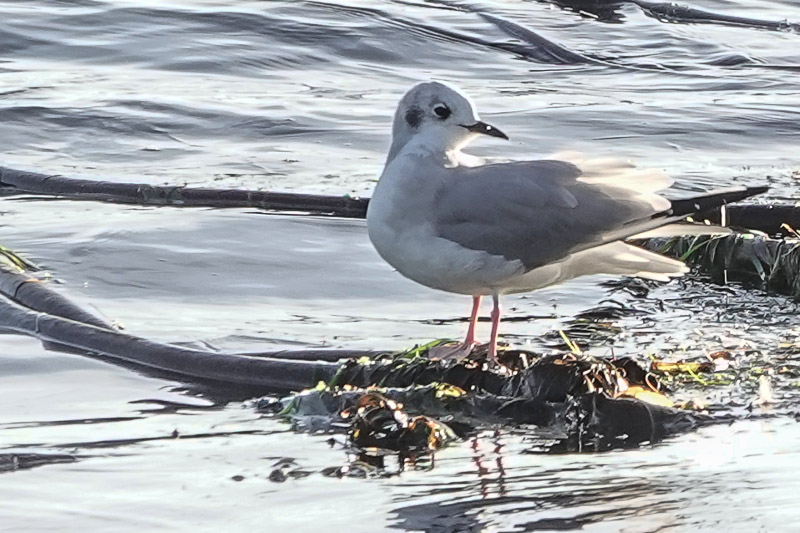
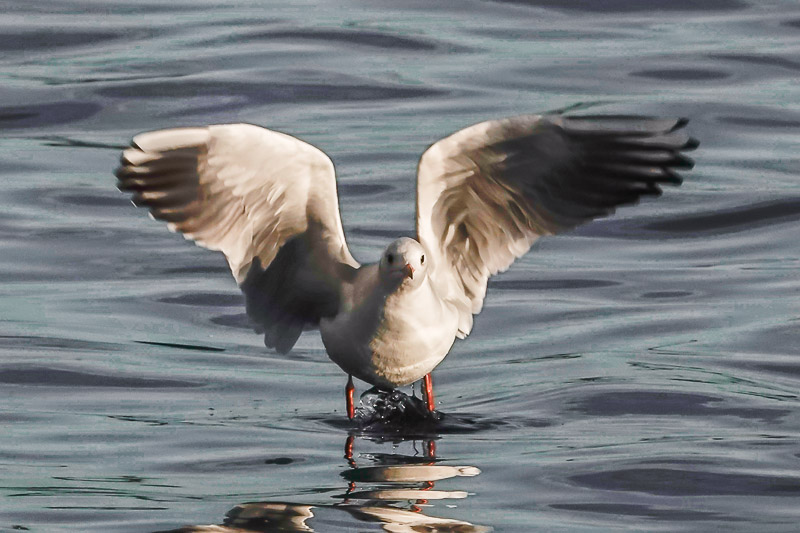 We have chased a Black-headed Gull four times in the past eight years; while we were successful
in 2016,
2022 and
2023
I never enjoyed a satisfactory view of the bird but Darchelle was eager to try once more so after it
was reported again this morning we set out for Birch Bay.
We have chased a Black-headed Gull four times in the past eight years; while we were successful
in 2016,
2022 and
2023
I never enjoyed a satisfactory view of the bird but Darchelle was eager to try once more so after it
was reported again this morning we set out for Birch Bay.
The gull had recently been seen roosting on the beach with a flock of Bonaparte's Gulls but when we arrived we discovered that the beach was at least a mile long and mostly hidden by a berm of dune grass from the street which borders it. We were, to use one of Darchelle's recent favorite words, daunted. Compounding the difficulty, access to the beach is private except for a few widely-separated public parking areas. We resorted to live-parking illegally at intervals along the street so that Darchelle could get out and scan the narrow strip of beach between the dune grass and the high water line. That worked! Within a few minutes she spotted the gull standing on the wrack line at the edge of the water immediately opposite a little path cutting through the dune grass. Parking illegally again, she loaded me into the chair and wheeled me out to the beach L+ where I sat and watched the Black-headed Gull from within 20 feet while she and another birder named Kellie S took photos. Kellie also captured a recording of the gull calling, used here with her permission. I heard a different call, a thin "kileee" given as the gull threw its head back with its bill pointing at the sky.
Shortly before we left all of the gulls along the shore flushed at once giving me an opportunity to compare the Black-headed Gull with a Bonaparte's Gull in flight. The Black-headed appeared to be about 20% larger but otherwise pretty similar.

Black-headed Gull, Birch Bay

Bonaparte's Gull, Birch Bay

Black-headed Gull, Birch Bay
The gull had recently been seen roosting on the beach with a flock of Bonaparte's Gulls but when we arrived we discovered that the beach was at least a mile long and mostly hidden by a berm of dune grass from the street which borders it. We were, to use one of Darchelle's recent favorite words, daunted. Compounding the difficulty, access to the beach is private except for a few widely-separated public parking areas. We resorted to live-parking illegally at intervals along the street so that Darchelle could get out and scan the narrow strip of beach between the dune grass and the high water line. That worked! Within a few minutes she spotted the gull standing on the wrack line at the edge of the water immediately opposite a little path cutting through the dune grass. Parking illegally again, she loaded me into the chair and wheeled me out to the beach L+ where I sat and watched the Black-headed Gull from within 20 feet while she and another birder named Kellie S took photos. Kellie also captured a recording of the gull calling, used here with her permission. I heard a different call, a thin "kileee" given as the gull threw its head back with its bill pointing at the sky.
Shortly before we left all of the gulls along the shore flushed at once giving me an opportunity to compare the Black-headed Gull with a Bonaparte's Gull in flight. The Black-headed appeared to be about 20% larger but otherwise pretty similar.
9/18/2024 Hawk Watching (link to here)
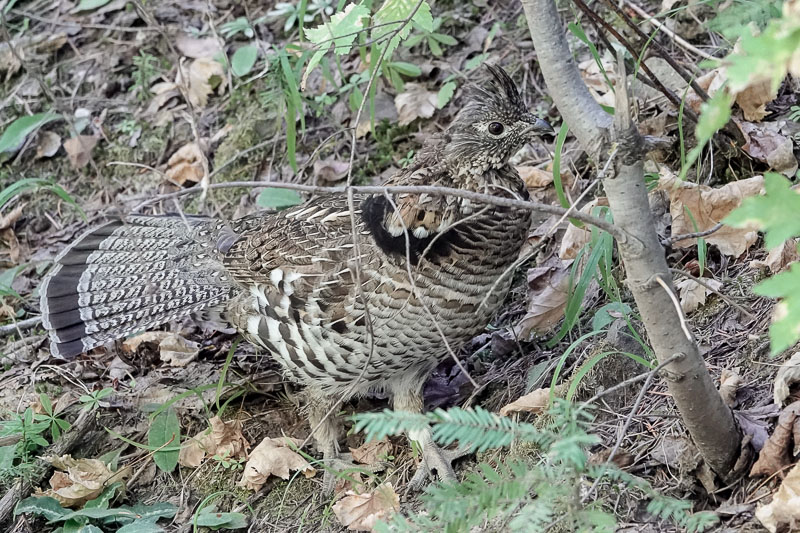

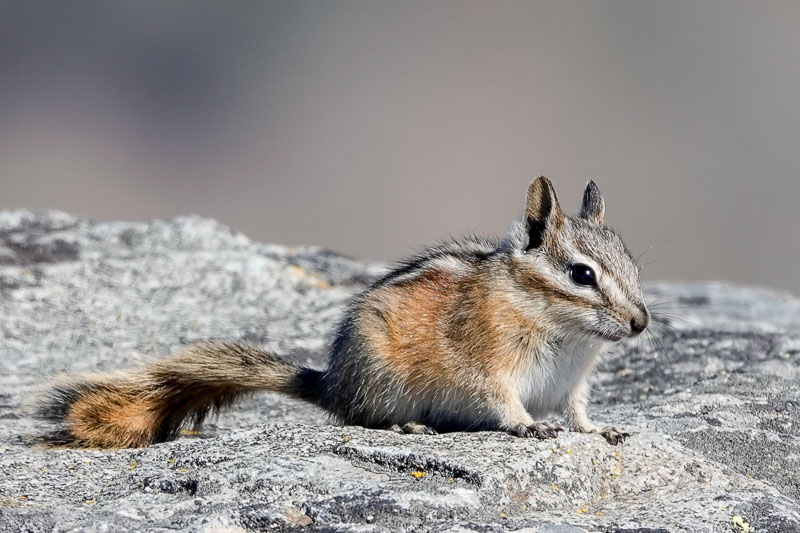 We had been planning a trip up to Harts Pass to look for Ptarmigan with Andy and Ellen for several
weeks but the decision to meet on Sugarloaf Mountain but to look for migrating raptors was a
new development. Inspired by a recent report +, we were particularly hoping to see a Broad-winged Hawk or two
since our report L+
from Mill Canyon on the same day has not been approved. Not that we doubt our ID, though apparently
the reviewers do. In any case we were disappointed; we sat just
below the fire lookout
cabin L+ for four hours and saw almost no hawks at all.
We had been planning a trip up to Harts Pass to look for Ptarmigan with Andy and Ellen for several
weeks but the decision to meet on Sugarloaf Mountain but to look for migrating raptors was a
new development. Inspired by a recent report +, we were particularly hoping to see a Broad-winged Hawk or two
since our report L+
from Mill Canyon on the same day has not been approved. Not that we doubt our ID, though apparently
the reviewers do. In any case we were disappointed; we sat just
below the fire lookout
cabin L+ for four hours and saw almost no hawks at all.
We saw other migrants - Mountain Bluebirds, White-crowned Sparrows, Yellow-rumped Warblers - but even that activity was slow. I sat next to the information kiosk facing out to the north up the Chiwawa River valley where I used to hike and hunt 40 years ago. Thanks to the Tyee fire 30 years ago which burned the surrounding boreal forest, my view of both mountains and migrants was unobstructed as was the westerly breeze which despite the warm sunshine eventually persuaded us to give up and retreat to the warmth of our cars. I don't know if we will return. Andy and Ellen had arrived before us and spoken to the lookout, a friendly and sympathetic man named Doug who had opened the gate to allow us to drive the last quarter mile to the top. We would not have been able get there otherwise.
Where we would like to return is the forested canyon of Van Creek L+ which we followed out of Leavenworth to get to Sugarloaf. Having spent the night at the nearby Wedge Mountain Inn we were there early and found lots of birds, including a Ruffed Grouse, in the thickets along the stream. Maybe next June we can get back there to check out the breeding birds.

Ruffed Grouse, Van Creek FR 7520, Leavenworth

View northwest, Sugarloaf Mountain

Yellow Pine Chipmunk, Sugarloaf Mountain
We saw other migrants - Mountain Bluebirds, White-crowned Sparrows, Yellow-rumped Warblers - but even that activity was slow. I sat next to the information kiosk facing out to the north up the Chiwawa River valley where I used to hike and hunt 40 years ago. Thanks to the Tyee fire 30 years ago which burned the surrounding boreal forest, my view of both mountains and migrants was unobstructed as was the westerly breeze which despite the warm sunshine eventually persuaded us to give up and retreat to the warmth of our cars. I don't know if we will return. Andy and Ellen had arrived before us and spoken to the lookout, a friendly and sympathetic man named Doug who had opened the gate to allow us to drive the last quarter mile to the top. We would not have been able get there otherwise.
Where we would like to return is the forested canyon of Van Creek L+ which we followed out of Leavenworth to get to Sugarloaf. Having spent the night at the nearby Wedge Mountain Inn we were there early and found lots of birds, including a Ruffed Grouse, in the thickets along the stream. Maybe next June we can get back there to check out the breeding birds.
9/19/2024 Harts Pass (link to here)
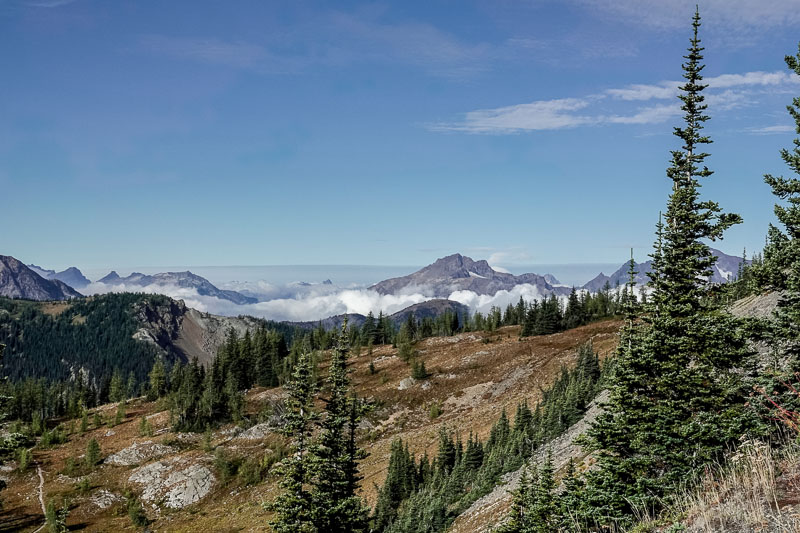
 We checked into the Mazama Ranch House
around 7:00 after stopping for supper at the Twisp River Tap House where the Chicken Pot Pie was solid
but the Traditional Cheesesteak Sandwich was spectacular. It was a treat to eat out with friends again
and I managed both the eating and the visiting without any serious problems.
We checked into the Mazama Ranch House
around 7:00 after stopping for supper at the Twisp River Tap House where the Chicken Pot Pie was solid
but the Traditional Cheesesteak Sandwich was spectacular. It was a treat to eat out with friends again
and I managed both the eating and the visiting without any serious problems.
We tackled the 18 mile trek up to Harts Pass L+ at 6:00 hoping that if we were the first cars up the hill we might spot a Spruce Grouse on the road like we did two years ago, but we didn't. We instead had three falcons for the day, and maybe a Peregrine to make four, along a handful of Accipiters. We did not find a single Ptarmigan even though Darchelle and Ellen hiked across the basin and back while Andy and I watched from above. The weather was just about perfect, sunny and cool without too much wind. Clouds were curling over the crest from the west when we reached the pass so we birded Meadows Campground while we waited for Slate Peak to clear. Lots of White-crowned Sparrows and Yellow-rumped Warblers. Higher up around Slate Peak L+ American Pipits predominated.
While Andy and I waited for Ptarmigan to appear, I noticed an interesting pattern in the vegetation of the basin below us. Grasses and forbs are interspersed with diffuse areas of Mountain Heath across the floor and gentler slopes of the basin but the other common ground cover shrub, Cascade bilberry (Vaccinium deliciosum) +, mostly seemed to grow in discrete patches up to 30 feet wide that were sometimes almost circular. Their uniform dull red color and sharply defined margins suggested that few other plants were growing within the borders of these patches. Apparently the Cascade bilberry often spreads by rhizomes so it seems likely that each patch consists of a single plant. I wondered how old they were and whether they were relatively recent arrivals, given that they appear to be currently expanding at the expense of the surrounding vegetation.

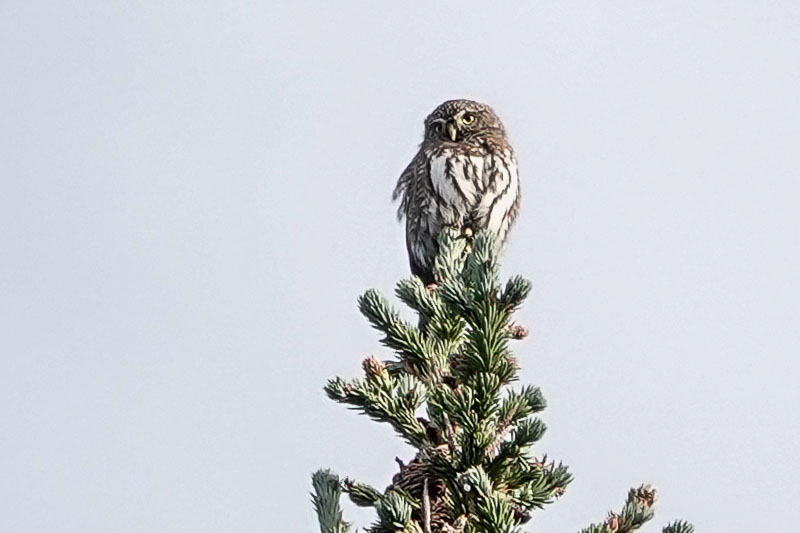
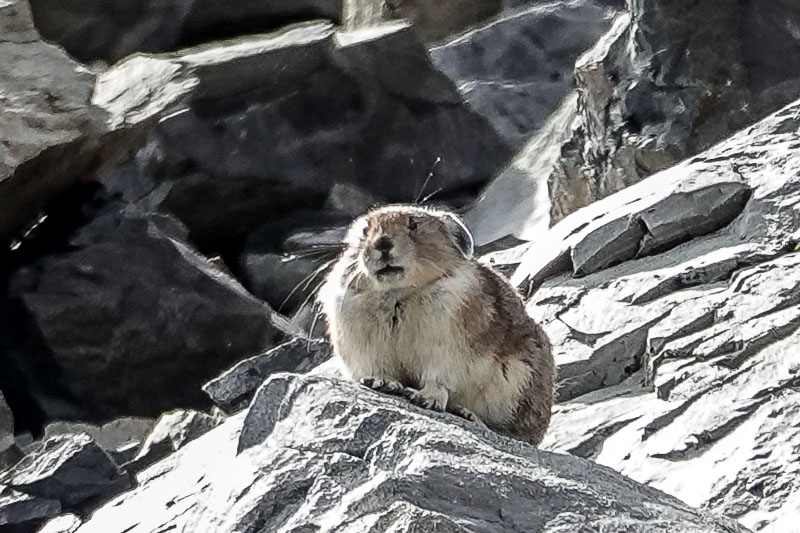 The Merlin just east of the pass was eating a small bird, perhaps a warbler. Ellen spotted the
Northern Pygmy-Owl on top of a Subalpine Fir along FR 700 west of Harts Pass. Darchelle and I
thought it might be new for us for Whatcom County but it was not; we saw one in
the same location L+
exactly three years ago. The Pika on the other hand was a first - the first photo Darchelle has ever
taken of that species.
The Merlin just east of the pass was eating a small bird, perhaps a warbler. Ellen spotted the
Northern Pygmy-Owl on top of a Subalpine Fir along FR 700 west of Harts Pass. Darchelle and I
thought it might be new for us for Whatcom County but it was not; we saw one in
the same location L+
exactly three years ago. The Pika on the other hand was a first - the first photo Darchelle has ever
taken of that species.

View west, Slate Peak Road

View east, Slate Peak Road
We tackled the 18 mile trek up to Harts Pass L+ at 6:00 hoping that if we were the first cars up the hill we might spot a Spruce Grouse on the road like we did two years ago, but we didn't. We instead had three falcons for the day, and maybe a Peregrine to make four, along a handful of Accipiters. We did not find a single Ptarmigan even though Darchelle and Ellen hiked across the basin and back while Andy and I watched from above. The weather was just about perfect, sunny and cool without too much wind. Clouds were curling over the crest from the west when we reached the pass so we birded Meadows Campground while we waited for Slate Peak to clear. Lots of White-crowned Sparrows and Yellow-rumped Warblers. Higher up around Slate Peak L+ American Pipits predominated.
While Andy and I waited for Ptarmigan to appear, I noticed an interesting pattern in the vegetation of the basin below us. Grasses and forbs are interspersed with diffuse areas of Mountain Heath across the floor and gentler slopes of the basin but the other common ground cover shrub, Cascade bilberry (Vaccinium deliciosum) +, mostly seemed to grow in discrete patches up to 30 feet wide that were sometimes almost circular. Their uniform dull red color and sharply defined margins suggested that few other plants were growing within the borders of these patches. Apparently the Cascade bilberry often spreads by rhizomes so it seems likely that each patch consists of a single plant. I wondered how old they were and whether they were relatively recent arrivals, given that they appear to be currently expanding at the expense of the surrounding vegetation.

Merlin, Harts Pass

Northern Pygmy-Owl, Harts Pass

Pika, Slate Peak
9/25/2024 The Coast (link to here)
When we departed for a trip to the coast this morning there were, as far as we could tell, five species of non-pelagic birds in Washington which we had not yet seen this year in the state. By the end of the day we had ticked off three of them, or so we thought until I reviewed Darchelle's photos on the computer a few days later. The bird we found this afternoon on Midway Beach which we had hoped was an American Golden Plover turned out to be its more common consin, the Pacific Golden Plover. Anticipating that possibility, we spent the night in Shelton in order to try for the confirmed American Golden Plover at Fort Flagler State Park tomorrow.

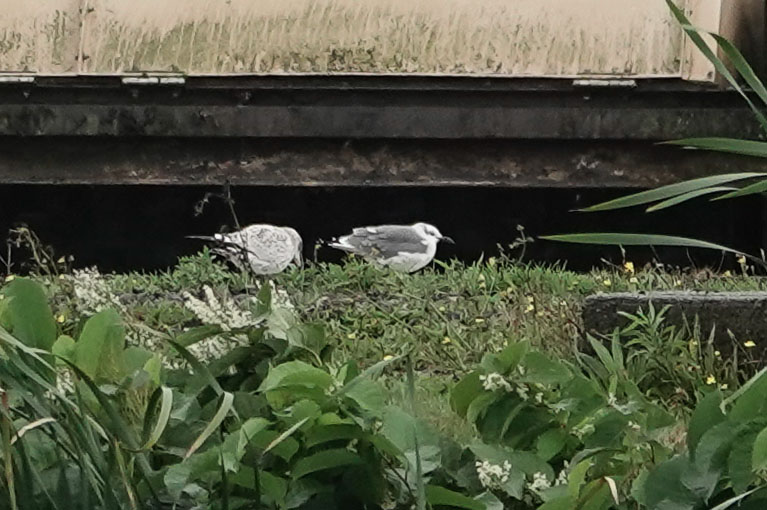
 Our first new year bird, the Laughing Gull at the Hoquiam STP L+ which Wayne Sladek found a month ago and Liam
recently refound in the same location, was not one which I expected to see. I didn't end up seeing
very much of it either, just its head - a tiny white dot - sticking above the grass on the far side
of the pond. I would not even have known it was a bird except that Darchelle was at that moment
standing outside my car door viewing it through the scope. The gull's plumage indicated
that it was an adult which means that it could be the bird we saw at the Tokeland Marina in
March and again in August of last year.
Our first new year bird, the Laughing Gull at the Hoquiam STP L+ which Wayne Sladek found a month ago and Liam
recently refound in the same location, was not one which I expected to see. I didn't end up seeing
very much of it either, just its head - a tiny white dot - sticking above the grass on the far side
of the pond. I would not even have known it was a bird except that Darchelle was at that moment
standing outside my car door viewing it through the scope. The gull's plumage indicated
that it was an adult which means that it could be the bird we saw at the Tokeland Marina in
March and again in August of last year.
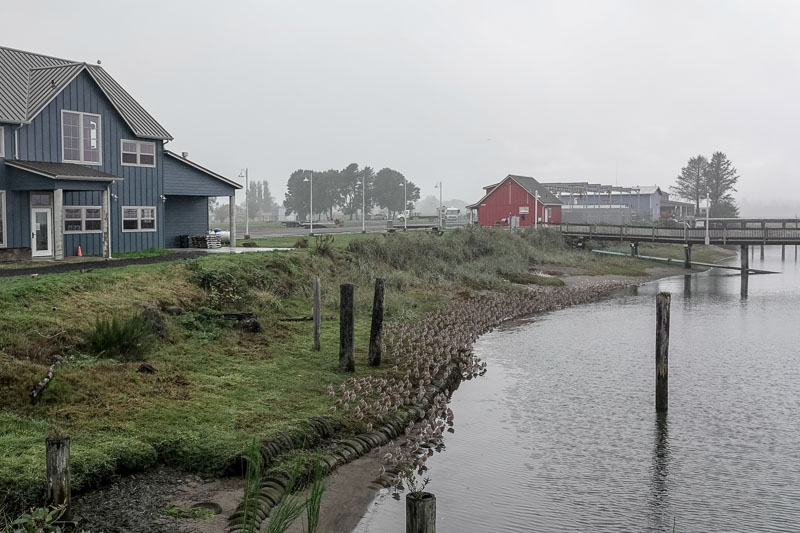
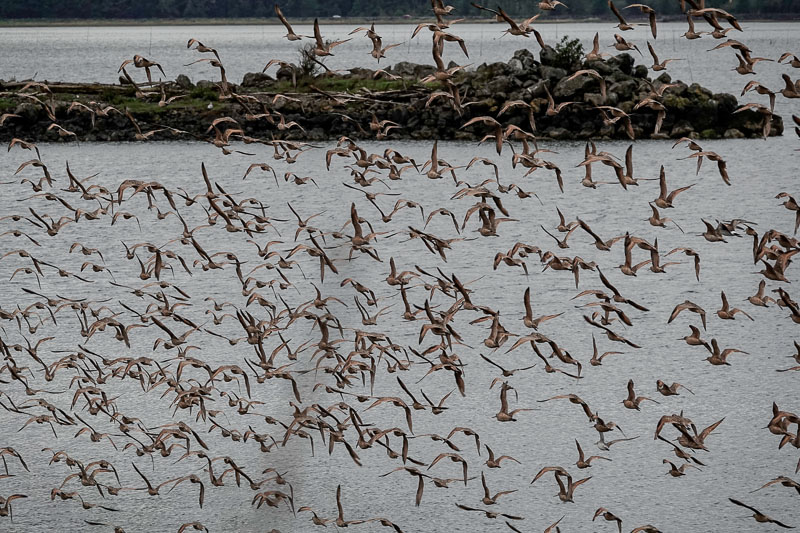
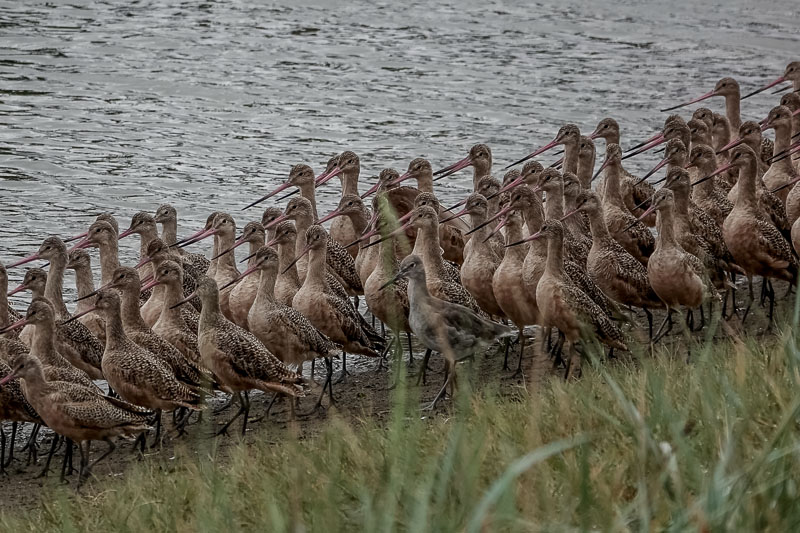 We were headed there next in hopes of getting a good view (and photos) of the rare Hudsonian Godwit
which has been hanging out with a flock of about 1200 Marbled Godwits for at least a week now. When we
arrived at the Marina L+
we found the godwit flock stretched out on the beach between the crab house and red barn. They were
ideally positioned for photos but the incoming tide was steadily encroaching on their narrow remaining
strip of sand so they could have at any moment relocated to the distant breakwater where they usually
rested at high tide. Fortunately they did not so Darchelle was able to get great views and photos.
Unfortunately I did not get out of the car so I did not see them as well as I might have.
We were headed there next in hopes of getting a good view (and photos) of the rare Hudsonian Godwit
which has been hanging out with a flock of about 1200 Marbled Godwits for at least a week now. When we
arrived at the Marina L+
we found the godwit flock stretched out on the beach between the crab house and red barn. They were
ideally positioned for photos but the incoming tide was steadily encroaching on their narrow remaining
strip of sand so they could have at any moment relocated to the distant breakwater where they usually
rested at high tide. Fortunately they did not so Darchelle was able to get great views and photos.
Unfortunately I did not get out of the car so I did not see them as well as I might have.
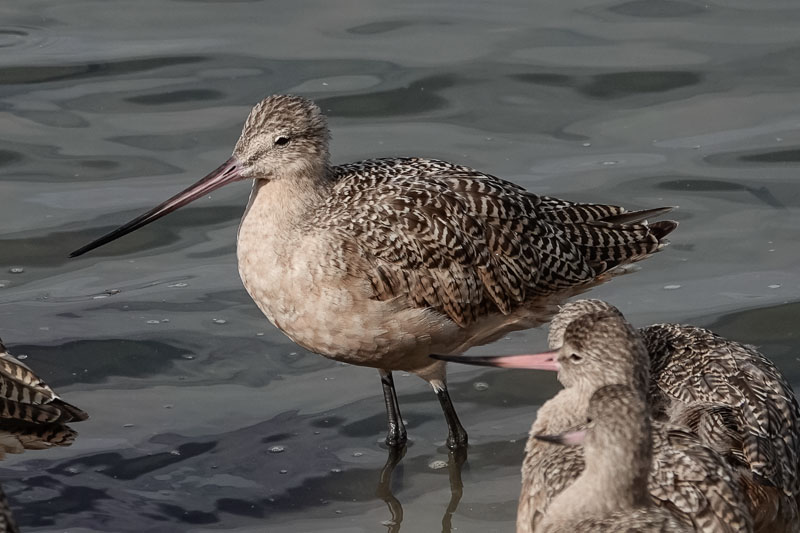
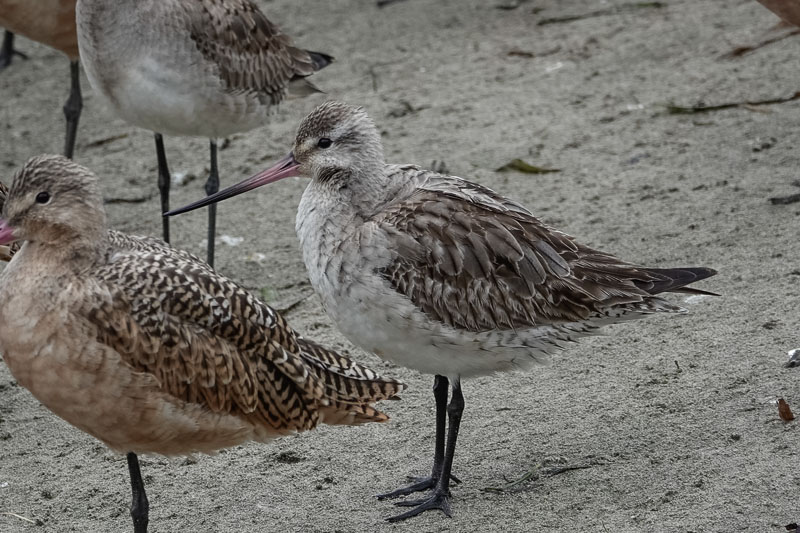
 Also in the godwit flock were two Bar-tailed Godwits so Darchelle had the opportunity to compare them
with both the Marbled and the Hudsonian at close range. The three species are not as easy to tell
apart as her photos might suggest. In basic, that is non-beeding, plumage Bar-tailed Godwits are
generally gray with upper parts that appear scaly rather than barred but their Marbled cousins can
be quite gray as well. Hudsonian Godwits, the smallest of three species, are gray-brown in color and
do not appear as strongly patterned, at least at a distance, as the other two. Except in flight when
the black and white tail really stands out.
Also in the godwit flock were two Bar-tailed Godwits so Darchelle had the opportunity to compare them
with both the Marbled and the Hudsonian at close range. The three species are not as easy to tell
apart as her photos might suggest. In basic, that is non-beeding, plumage Bar-tailed Godwits are
generally gray with upper parts that appear scaly rather than barred but their Marbled cousins can
be quite gray as well. Hudsonian Godwits, the smallest of three species, are gray-brown in color and
do not appear as strongly patterned, at least at a distance, as the other two. Except in flight when
the black and white tail really stands out.


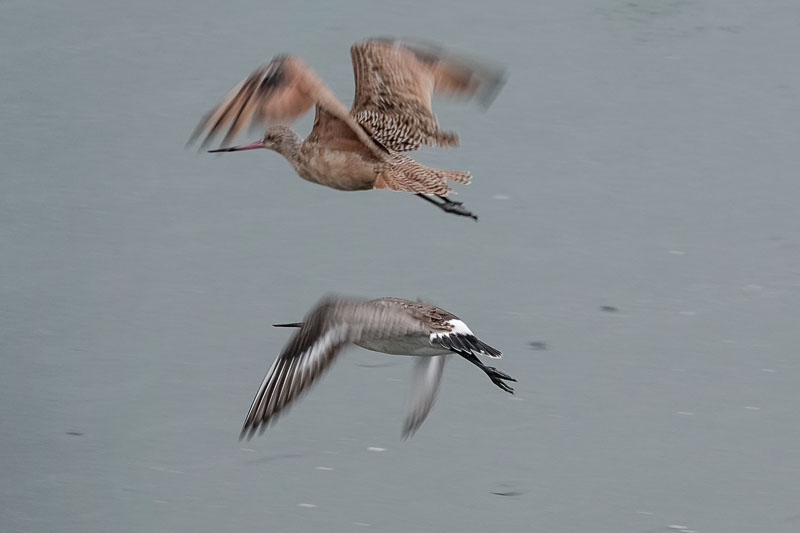 Hudsonian Godwits breed in arctic Canada and Alaska and winter along the coasts of Argentina and Chile
but rarely deign to stop in Washington or anywhere else in the western US in between.
Hudsonian Godwits breed in arctic Canada and Alaska and winter along the coasts of Argentina and Chile
but rarely deign to stop in Washington or anywhere else in the western US in between.
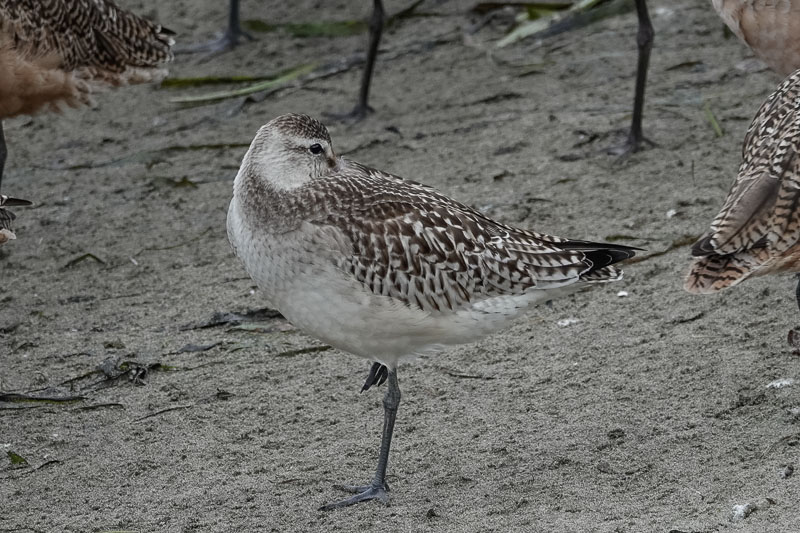
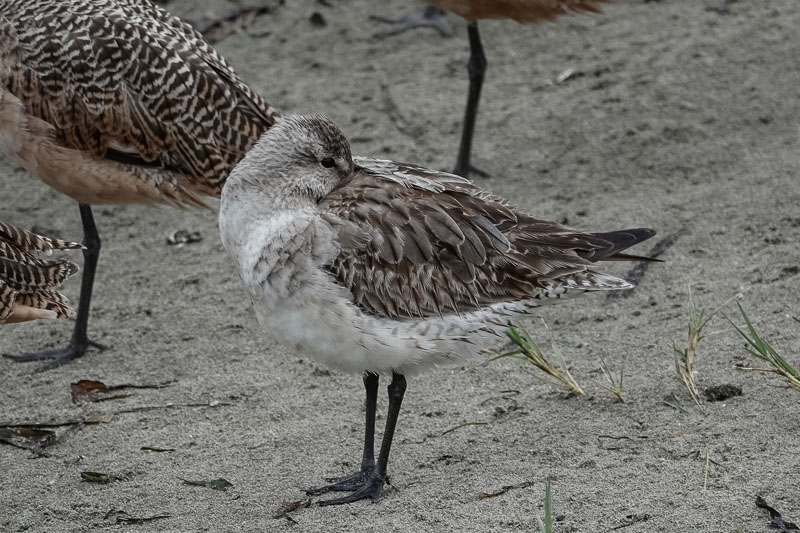
 The North American population of Bar-tailed Godwits breeds in northern and western Alaska, where
they are known for their fearless defense of their nesting territories. The few birds which visit
Washington nearly every fall are apparently slackers. Per
Birds of the World +:
The North American population of Bar-tailed Godwits breeds in northern and western Alaska, where
they are known for their fearless defense of their nesting territories. The few birds which visit
Washington nearly every fall are apparently slackers. Per
Birds of the World +:
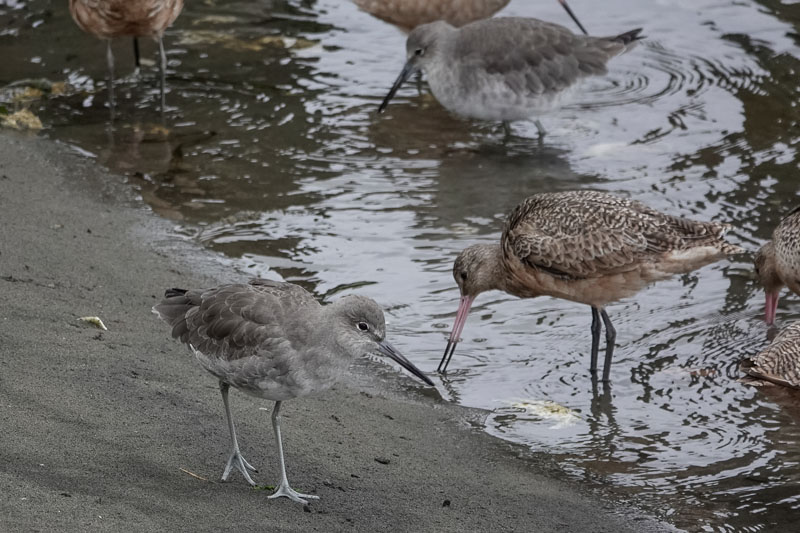
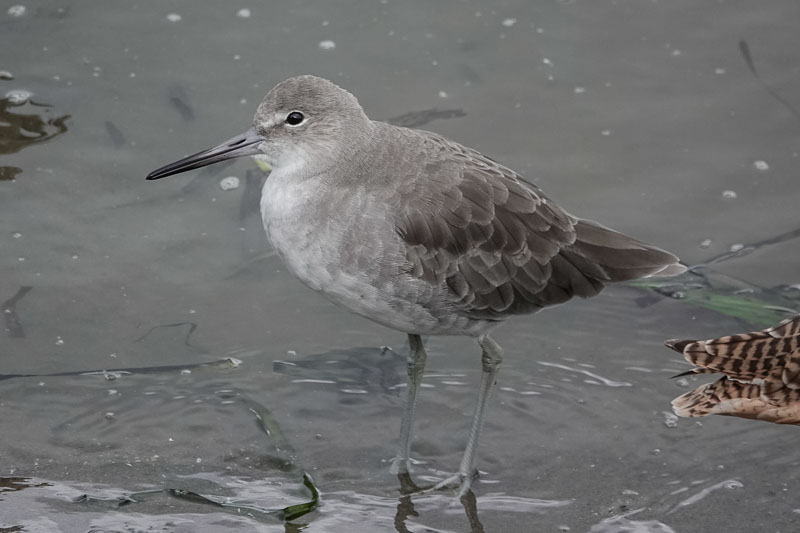
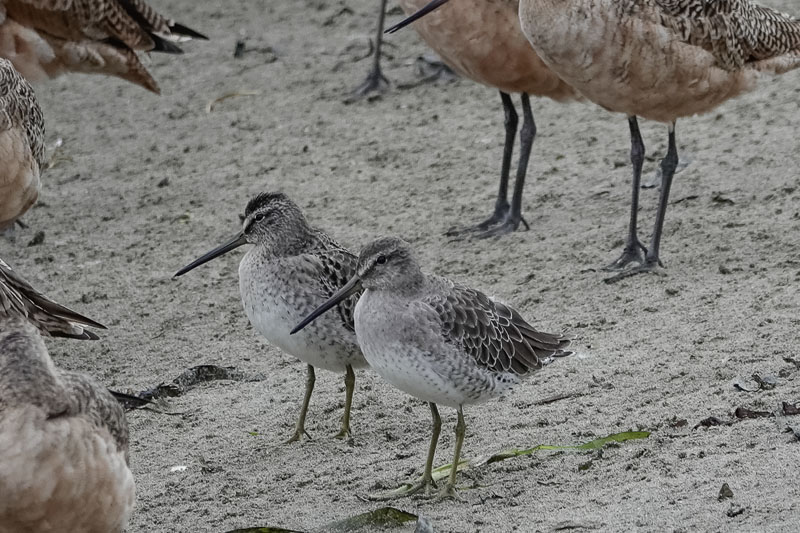 Willets are a large shorebird comparable in size to the godwits. They are rare elsewhere in Washington
but a small (though growing?) flock resides in the vicinity of Tokeland. I have to wonder what they think
about the annual autumn invasion of their territory by the godwits but I have never observed any competitive
interaction between the two species.
Willets are a large shorebird comparable in size to the godwits. They are rare elsewhere in Washington
but a small (though growing?) flock resides in the vicinity of Tokeland. I have to wonder what they think
about the annual autumn invasion of their territory by the godwits but I have never observed any competitive
interaction between the two species.

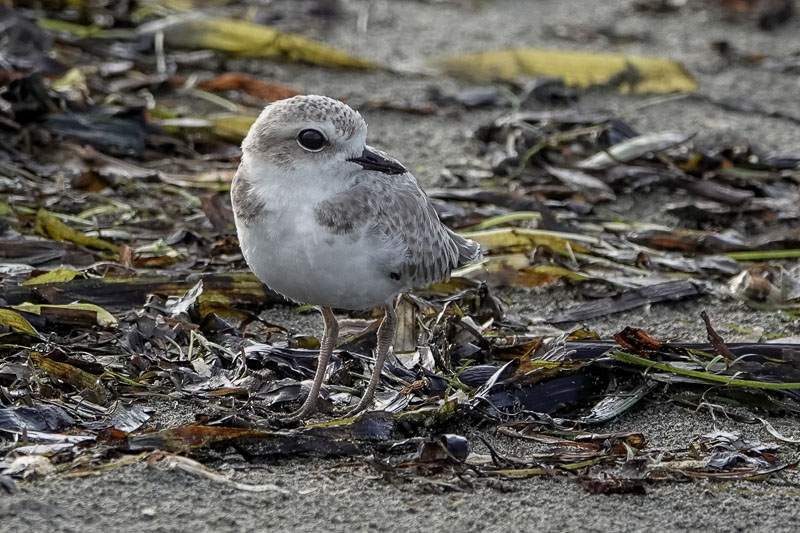
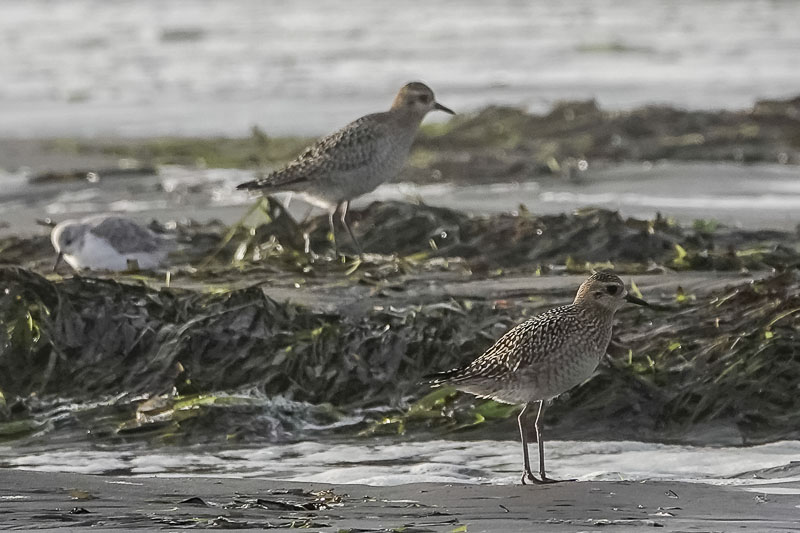 After Tokeland we drove the beach L+ north from the Warrenton Cannery Rd entrance in North Cove. The tide
was high and occasional large waves were pushing the wrack line, mostly tangled clumps of eelgrass,
up onto the dry sand. Flocks of ducks were flying south over the surf and shorebirds were foraging
in the wrack. They were mostly Sanderlings and Snowy Plovers but somewhere off Midway we flushed three
Golden Plovers. Excited because Golden Plovers are rare on the beach, we chased them for several
minutes and Darchelle was able to get photos of all three.
After Tokeland we drove the beach L+ north from the Warrenton Cannery Rd entrance in North Cove. The tide
was high and occasional large waves were pushing the wrack line, mostly tangled clumps of eelgrass,
up onto the dry sand. Flocks of ducks were flying south over the surf and shorebirds were foraging
in the wrack. They were mostly Sanderlings and Snowy Plovers but somewhere off Midway we flushed three
Golden Plovers. Excited because Golden Plovers are rare on the beach, we chased them for several
minutes and Darchelle was able to get photos of all three.
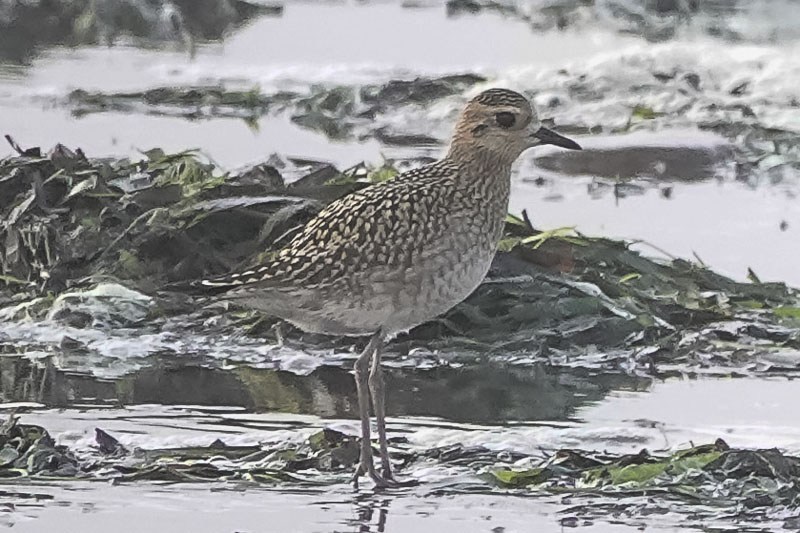

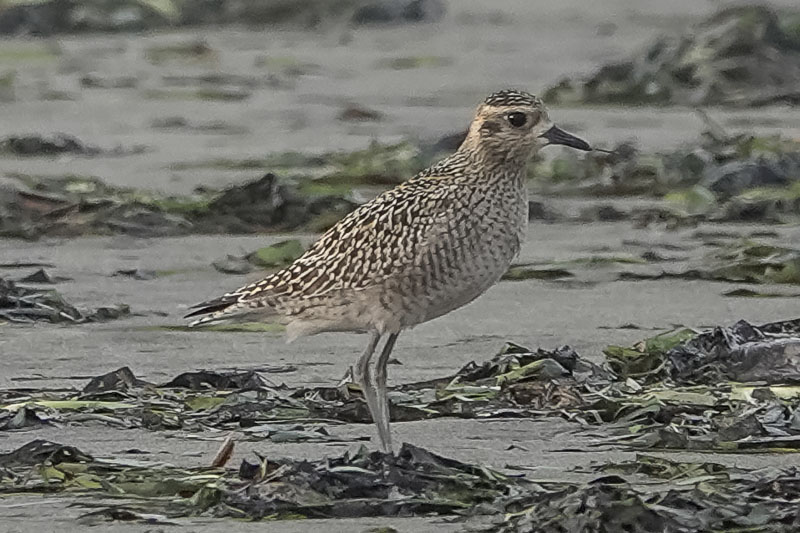 From her photos I was able to determine that they were all Pacific Golden Plovers. American Golden
Plovers have relatively longer primaries and shorter tertials but the differences are subtle and it
helps to know the range of variation in those features in Pacific Golden Plovers. That range is
illustrated nicely by the three birds we photographed on the beach. The photos are arranged from
left to right by the length of the wing relative to the tail. The bird on the left has the longest
primary extension beyond the tail (suggestive of an American) and the bird on the right the shortest
(clearly a Pacific) but in all three the tertials appear long relative to the primaries with no more
than three dark primary feathers extending beyond the spotted tertials.
From her photos I was able to determine that they were all Pacific Golden Plovers. American Golden
Plovers have relatively longer primaries and shorter tertials but the differences are subtle and it
helps to know the range of variation in those features in Pacific Golden Plovers. That range is
illustrated nicely by the three birds we photographed on the beach. The photos are arranged from
left to right by the length of the wing relative to the tail. The bird on the left has the longest
primary extension beyond the tail (suggestive of an American) and the bird on the right the shortest
(clearly a Pacific) but in all three the tertials appear long relative to the primaries with no more
than three dark primary feathers extending beyond the spotted tertials.
FWIW Our hope of finding an American Golden Plover was not unreasonable; just nine days later + Maxine found one on the same stretch of beach.
When we departed for a trip to the coast this morning there were, as far as we could tell, five species of non-pelagic birds in Washington which we had not yet seen this year in the state. By the end of the day we had ticked off three of them, or so we thought until I reviewed Darchelle's photos on the computer a few days later. The bird we found this afternoon on Midway Beach which we had hoped was an American Golden Plover turned out to be its more common consin, the Pacific Golden Plover. Anticipating that possibility, we spent the night in Shelton in order to try for the confirmed American Golden Plover at Fort Flagler State Park tomorrow.

My view of the Laughing Gull, Hoquiam STP

Scope view of the Laughing Gull, Hoquiam STP

Laughing Gull, Hoquiam STP

About 600 Marbled Godwits, Tokeland Marina

My view of the Hudsonian Godwit (far right), Tokeland Marina

Willet and Marbled Godwits, Tokeland Marina

Marbled Godwit, Tokeland Marina

Bar-tailed Godwit, Tokeland Marina

Hudsonian Godwit, Tokeland Marina

Hudsonian Godwit, Tokeland Marina

Hudsonian Godwit, Tokeland Marina

Hudsonian Godwit, Tokeland Marina

Bar-tailed Godwit (juvenile), Tokeland Marina

Bar-tailed Godwit, Tokeland Marina

Bar-tailed Godwit, Tokeland Marina
After breeding across subarctic and arctic tundra in western and northern Alaska, nearly 100,000
individuals depart from the Bering Sea coast of Alaska in September or early October, many
apparently on a nonstop flight to Australia and New Zealand, a distance of 11,000 kilometers.
Commensurate with such a lengthy migration, these godwits carry the greatest fat loads of any
migrant bird studied to date. Individuals apparently accommodate such prodigious amounts of fat by
reducing the size of their digestive apparatus prior to departing on what may be the longest nonstop
migration of any bird in the world.

Willets, Tokeland Marina

Willet, Tokeland Marina

Short-billed Dowitchers, Tokeland Marina

The Wrack Line, Midway Beach

Snowy Plover, Midway Beach

Pacific Golden Plovers, Midway Beach

Pacific Golden Plover, Midway Beach

Pacific Golden Plover, Midway Beach

Pacific Golden Plover, Midway Beach
FWIW Our hope of finding an American Golden Plover was not unreasonable; just nine days later + Maxine found one on the same stretch of beach.
9/26/2024 Port Townsend (link to here)

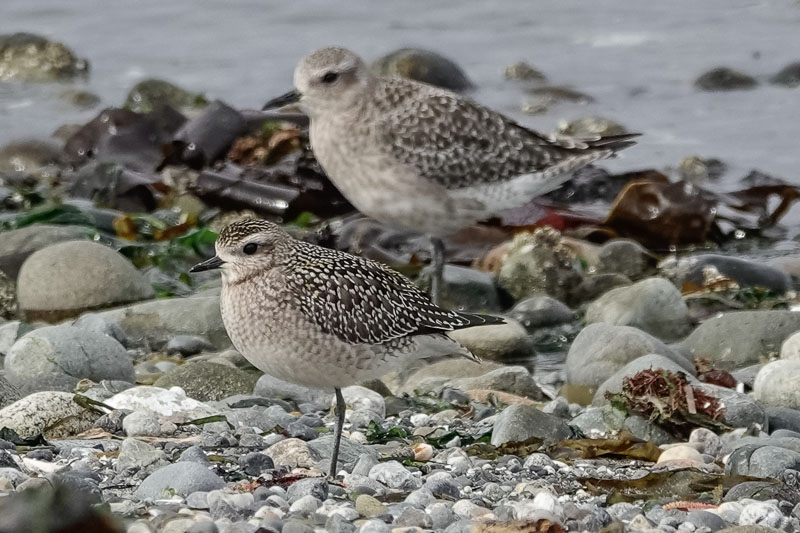
 There being no question about the identity of the American Golden Plover at
Fort Flagler State Park
L+, we gambled that it would stick around one more day and drove up there this morning to look
for it. Our plan paid off, but barely; I think we were the last birders to report it. Darchelle
found it roosting with about 100 Black-bellied Plovers on the sand (and pebble) spit west of the
beach campground but the spit was not accessible for my wheelchair so I waited in the car hoping
that the birds would fly and give me a view of the flock. They did and I counted the tick, #346 for
the year. I assumed that the bird was in the flock and later confirmed that it was - dead center in
the photo on the left above.
There being no question about the identity of the American Golden Plover at
Fort Flagler State Park
L+, we gambled that it would stick around one more day and drove up there this morning to look
for it. Our plan paid off, but barely; I think we were the last birders to report it. Darchelle
found it roosting with about 100 Black-bellied Plovers on the sand (and pebble) spit west of the
beach campground but the spit was not accessible for my wheelchair so I waited in the car hoping
that the birds would fly and give me a view of the flock. They did and I counted the tick, #346 for
the year. I assumed that the bird was in the flock and later confirmed that it was - dead center in
the photo on the left above.

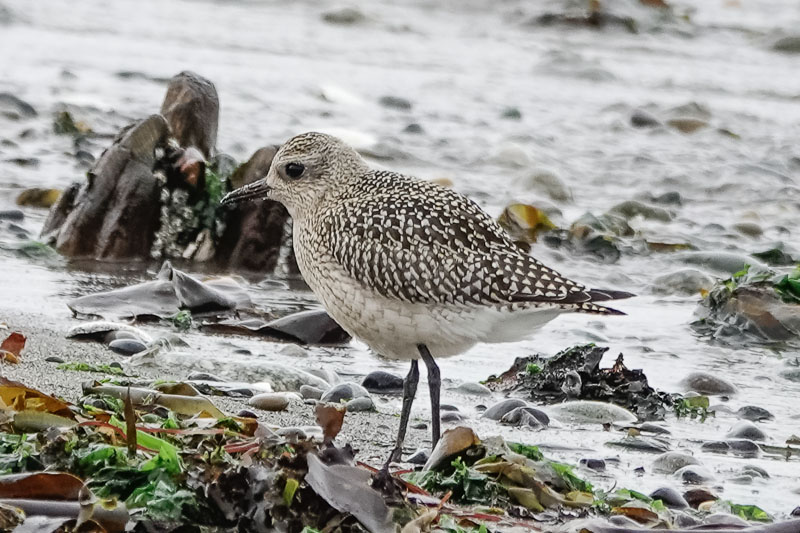
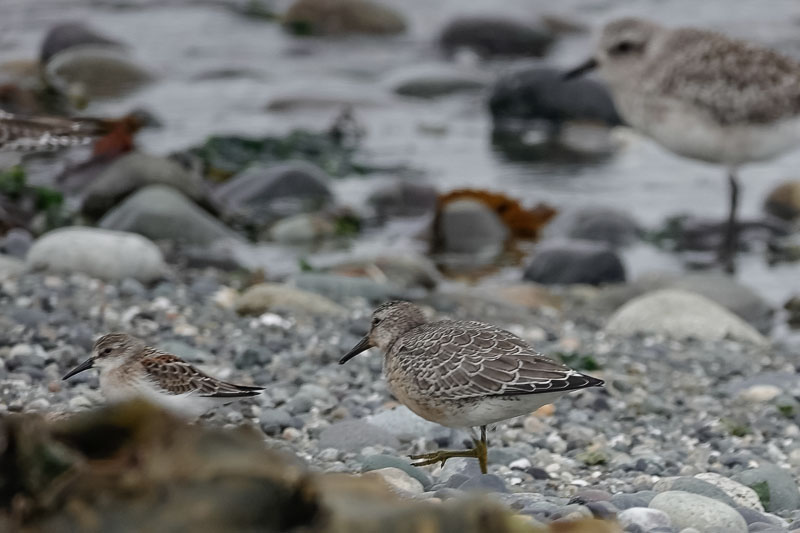 After identifying the American Golden Plover, Darchelle was distracted by two Black-bellied Plovers
which looked very similar to it. Most of the Black-bellied Plovers were clearly larger and more
gray overall than the Golden Plover but she wondered if those two might be Pacific Golden Plovers.
She spent quite a bit of time watching the bird in the center photo above before it finally raised
its wings and revealed the telltale black axillars of a Black-bellied Plover.
After identifying the American Golden Plover, Darchelle was distracted by two Black-bellied Plovers
which looked very similar to it. Most of the Black-bellied Plovers were clearly larger and more
gray overall than the Golden Plover but she wondered if those two might be Pacific Golden Plovers.
She spent quite a bit of time watching the bird in the center photo above before it finally raised
its wings and revealed the telltale black axillars of a Black-bellied Plover.

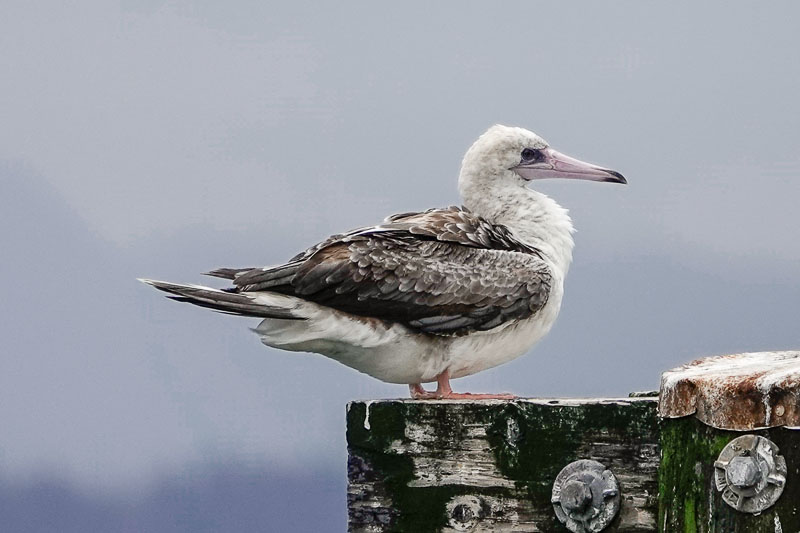
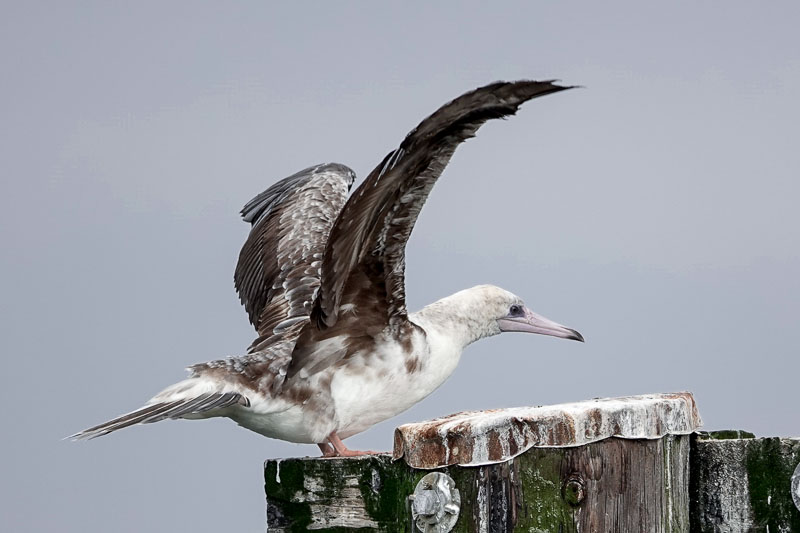 While we were out there we decided couldn't pass up the opportunity to pay our respects to the
local celebrity bird, the Red-footed Booby which first showed up in Port Townsend back in August.
It posed cooperatively for us on pilings by the Marine Science Center while Darchelle took photos.
While we were out there we decided couldn't pass up the opportunity to pay our respects to the
local celebrity bird, the Red-footed Booby which first showed up in Port Townsend back in August.
It posed cooperatively for us on pilings by the Marine Science Center while Darchelle took photos.

My view of the American Golden Plover, Fort Flagler SP

American Golden Plover, Fort Flagler SP

American Golden Plover, Fort Flagler SP

Black-bellied Plover, Fort Flagler SP

Black-bellied Plover, Fort Flagler SP

Red Knot and Western Sandpiper, Fort Flagler SP

My view of the Red-footed Booby, Fort Worden SP

Red-footed Booby, Fort Worden SP

Red-footed Booby, Fort Worden SP
9/30/2024 September Summary (link to here)
As we had anticipated, September was a big birding month, second only to May for days in the field (13) and nights away from home (9). We put 3145 miles on the car (odometer now at 127205), entered 30 complete checklists and accumulated 165 species for the month. With 346 species, we are still two behind where we were a year ago and 16 behind our big year pace in 2022.
As we had anticipated, September was a big birding month, second only to May for days in the field (13) and nights away from home (9). We put 3145 miles on the car (odometer now at 127205), entered 30 complete checklists and accumulated 165 species for the month. With 346 species, we are still two behind where we were a year ago and 16 behind our big year pace in 2022.